

Experts Warn Travelers to Avoid These 15 Dangerous Cities in Mexico
As someone who has lived in Mexico since 2018 , and traveled to more than half the states in the country — I know Mexico is an incredible place filled with vibrant culture, breathtaking nature, amazing food, and rich history.
However, it’s crucial to be informed about the safety risks that come with visiting certain parts of the country.
In this article, I’m going to highlight the 15 most dangerous cities in Mexico, along with practical safety tips to help you navigate your Mexico travels more securely.
Why is Mexico so dangerous?
Danger comes in many forms, including environmental dangers like tornadoes and landslides, but this article is about the dangers associated with crime.
Below, you’ll discover some of the factors contributing to high crime rates in Mexico — but if you’re very concerned, make sure you get Mexico travel insurance for peace of mind.
1. Drug Cartel Activities
Mexico’s high crime rates are significantly influenced by the activities of powerful drug cartels .
These criminal organizations, including the Sinaloa Cartel, Jalisco New Generation Cartel, and others, have a stronghold in various regions.
Their influence extends to drug trafficking, extortion, and violent confrontations, affecting both local communities and travelers.
The presence of these cartels often leads to increased crime rates and a general atmosphere of insecurity.
2. Socio-Economic Inequality
Another critical factor contributing to crime in Mexico is socio-economic inequality .
There is a strong connection between poverty and crime, as individuals in impoverished areas may turn to illegal activities out of desperation.
Income inequality exacerbates violence, leading to higher crime rates in regions where economic disparities are most pronounced.
You’ll especially see these disparities in cities where affluent neighborhoods are juxtaposed with impoverished communities, creating a breeding ground for criminal activities.
3. Government Corruption
Corruption within law enforcement and government institutions in Mexico play a significant role in allowing crime to flourish.
When officials are corrupt, they may turn a blind eye to criminal activities or even participate in them, undermining efforts to maintain law and order.
Notable cases of corruption in Mexico related to crime have been reported, further eroding public trust in authorities, and contributing to the overall crime problem.
The 15 Most Dangerous Cities in Mexico for Tourists
All of the most dangerous parts of Mexico featured in this list have been ranked by the number of homicides per 100,000 residents.
These cities in Mexico with high murder rates, as well as other types of crime, should be considered among the least safe cities in Mexico to visit for tourists.
Information for this article to determine the most dangerous Mexican cities was sourced from the U.S. State Department travel advisories, World Population Review , Numbeo and Statista .
1. Tijuana, Baja California
- Murder rate per 100,000 residents: 138 (Source: World Population Review)
- U.S. State Department Warning Level: Tijuana is in Baja California state, which has a Level 3: Reconsider Travel To warning.
- Most dangerous neighborhoods in Tijuana: Centro, Rio, Sanchez Taboada, Zona Norte
Located on the U.S.-Mexico border, Tijuana is a bustling city known for its vibrant culture and nightlife. However, it’s also one of the most dangerous cities in Mexico.
Tijuana has consistently high crime rates, particularly in terms of homicides and drug-related violence.
In fact, the city recorded more than 2,000 homicides in 2020 — making it one of the deadliest cities in the world.
Most incidents in Tijuana involve cartel-related violence, including shootouts and assassinations, particularly in the Zona Norte and Zona Centro areas.
Local authorities in Tijuana have implemented various measures to combat crime in tourist areas, including increased police presence and community outreach programs.
While the effectiveness of these efforts is debated, Tijuana Mexico remains very popular with U.S. tourists driving across the border for weekend trips.
Still, statistically-speaking, it is the most dangerous city in Mexico.
⚠️ Tijuana Safety Tips
- Avoid areas known for gang activity, particularly at night.
- Stick to well-populated and tourist-friendly zones.
- Be cautious with personal belongings and avoid displaying valuables.
2. Acapulco, Guerrero
- Murder rate per 100,000 residents: 111
- U.S. State Department Warning Level: Acapulco is in Guerrero state, which has a Level 4: Do Not Travel To warning.
- Most dangerous neighborhoods in Acapulco: Ciudad Renacimiento, El Coloso, Emiliano Zapata, La Laja, Jardín Mangos
One of the top Mexico resort towns , it might seem bizarre to include Acapulco on a list of risky Mexican cities.
While much of the city boasts safety and hospitality towards tourists, with numerous upscale resorts and hotels enticing visitors seeking a lavish Mexican getaway.
However, beyond these opulent tourist hubs, Acapulco presents significant safety concerns.
Regrettably, Acapulco visitors should limit exploration beyond the immediate resort vicinity — In other words: Don’t venture far from the resorts.
Venturing outside the confines of the resort area reveals prevalent poverty and quality of life issues, contributing to heightened crime rates in one of Mexico’s least secure destinations.
⚠️ Acapulco Safety Tips
- Stay within designated safe zones, like the Acapulco beaches and resort area.
- Avoid isolated areas, especially after dark.
- Use reputable transportation services, and avoid hailing taxis on the street.
3. Ciudad Victoria, Tamaulipas
- Murder rate per 100,000 residents: 86
- U.S. State Department Warning Level: Ciudad Victoria is in Tamaulipas state, which has a Level 4: Do Not Travel To warning.
- Most dangerous neighborhoods: Northern Ciudad Victoria (all of it)
Plagued by violence from Mexican cartels, Ciudad Victoria is considered one of Mexico’s most perilous destinations.
Despite its allure as one of the country’s most beautiful colonial cities, it’s regarded as a no-go area for Latin America visitors because of alarming homicide rates.
Sadly, Ciudad Victoria isn’t considered safe for local residents nor international travelers, and is one of the most violent cities per capita in Tamaulipas state.
Its strategic location along a key drug smuggling route between the U.S. and Mexico has precipitated the city’s deterioration in recent times.
⚠️ Ciudad Victoria SAFETY TIPS
- If you’re driving, use only main roads and well-traveled routes.
- Download the iOverlander App so you can connect with people who are currently driving in the area.
- Stay informed about current safety advisories.
4. Ciudad Juárez, Chihuahua
- U.S. State Department Warning Level: Ciudad Juarez is in Chihuahua state, which has a Level 3: Reconsider Travel To warning.
- Most dangerous neighborhoods in Ciudad Juarez: Delicias, Aldama, Babicora Sur
Ciudad Juárez (often just called Juárez) is located in northern Mexico, close to the border with El Paso, Texas.
It’s one of the most dangerous cities in Mexico — though the El Paso Crossing is one of the most-used border crossings , so exercise extra caution if you’re driving.
Over the past few decades, Juárez has experienced significant population growth, but as the city expanded, the crime rates have risen accordingly.
This has earned Juárez a spot on the list of cities tourists should avoid in Mexico due to safety concerns.
Tragically, the high number of lives lost in Juárez places it among the top 50 most dangerous and violent cities in the world.
⚠️ Ciudad Juárez SAFETY TIPS
- Use main roads and well-traveled routes.
- Avoid border areas known for smuggling and violence.
5. Irapuato, Guanajuato
- Murder rate per 100,000 residents: 81
- U.S. State Department Warning Level: Irapuato is in Guanajuato state, which has a Level 3: Reconsider Travel To warning.
- Most dangerous neighborhoods in Irapuato: Central Irapuato (all parts)
Irapuato, while not as popular with tourists as some major Mexican cities on this list, has gained a reputation for being relatively unsafe.
Tourists should exercise caution because of the increasing crime rates in recent years, particularly kidnappings, violence, and drug trafficking.
While Irapuato has had a relatively safe past, conflicts between rival cartel groups have made it hazardous, posing risks to both tourists and locals.
Despite numerous things to do in Irapuato, like parks, zoos and shopping centers, visitors should exercise caution and remain vigilant while exploring the city.
⚠️ Irapuato SAFETY TIPS
- Avoid public places known for gang activity.
- Stay in well-reviewed hotels , and avoid venturing out alone.
- Be aware of your surroundings, and avoid displaying valuables.
6. Cancún, Quintana Roo
- Murder rate per 100,000 residents: 64
- U.S. State Department Warning Level: Irapuato is in Quintana Roo state, which has a Level 2: Exercise Increased Caution warning.
- Most dangerous neighborhoods in Cancun: Bonfil, Tres Reyes, Santa Cecilia, Valle Verde
Despite being the most-visited destination in Mexico for MANY years now, and like most cities with a lot of tourists, Cancun harbors a darker side.
Beyond its luxurious all-inclusive resorts and beautiful beaches, this coastal destination grapples with a high incidence of violent crime, particularly murder.
While tourists are generally safe within monitored areas, like the Cancun Hotel Zone, they should steer clear of the unsafe Cancun neighborhood on the outskirts of town.
⚠️ Cancun SAFETY TIPS
- Stick to the Zona Hotelera (hotel zone on the beach), and avoid venturing into less touristy areas.
- Be cautious when accepting offers from strangers.
- Use trusted transportation options, and avoid hailing taxis on the street.
7. Culiacán, Sinaloa
- Murder rate per 100,000 residents: 61
- U.S. State Department Warning Level: Culiacan is in Sinaloa state, which has a Level 4: Do Not Travel To warning.
- Most dangerous neighborhoods in Culiacan: La Retama, El Cóporo, El Seminario, Zopilocalco, Santa Bárbara, Santa Ana
Culiacán, located near the popular Mexican beach town of Mazatlán, is unfortunately among the least safe places to visit in Mexico.
Despite its attractions like nearby beaches, hot springs, malls, parks, and water parks, tourists often avoid this city due to its sinister reputation.
Culiacán is known as the stronghold of the powerful Sinaloa Cartel, and the infamous Mexican drug lord known as El Chapo is from a small town not far from here.
While it’s relatively safe in tourist-friendly zones, exploring other parts of the city is not advisable because of high crime rates.
⚠️ Culiacán Safety Tips
- Avoid areas with known cartel activity.
- Travel in groups, and avoid venturing out at night.
- Stay in secure accommodations with good reviews.
8. Uruapan, Michoacán
- Murder rate per 100,000 residents: 55
- U.S. State Department Warning Level: Uruapan is in Michoacán state, which has a Level 4: Do Not Travel To warning.
- Most dangerous neighborhoods in Uruapan: The Central and South parts of Uruapan
Uruapan, one of the older cities in Mexico that was founded in 1533, holds significant historical and cultural importance.
It’s a magnet for history enthusiasts due to its rich heritage and numerous landmarks that attract visitors from around the globe.
Despite its historical significance and natural beauty, Uruapan is not currently a top recommendation for tourists.
In recent years, it has gained attention for a surge in cartel-related crime from the so-called avocado cartels that often take violent revenge against advisories.
Violent crime rates continue to rise unabated in Uruapan, according to government reports.
9. Ciudad Obregón, Sonora
- Murder rate per 100,000 residents: 52
- U.S. State Department Warning Level: Ciudad Obregon is in Sonora state, which has a Level 3: Reconsider Travel To warning.
- Most dangerous neighborhoods in Ciudad Obregón: The northern areas
Ciudad Obregón is yet another city plagued by violence that tourists should steer clear of.
The presence of drug cartels has escalated gang violence, resulting in a rise in shootings, kidnappings, murders, and assaults.
Once considered a picturesque and tourist-friendly destination, Ciudad Obregón has now become a place best avoided, or approached with extreme caution, despite its abundance of natural beauty.
10. Coatzacoalcos , Veracruz
- Murder rate per 100,000 residents: 48
- U.S. State Department Warning Level: Coatzacoalcos is in Veracruz state, which has a Level 3: Reconsider Travel To warning.
- Most dangerous neighborhoods in Coatzacoalcos: La Bahía de San Martín, Cxala, Unidad Habitacional ISSFAM (U.H. ISSFAM)
Nestled along the Mexican coastline in Veracruz state, Coatzacoalcos boasts a rich history and cultural allure. It is also the birthplace of Mexican actress Salma Hayek.
This coastal gem offers visitors a plethora of unique experiences where visitors can immerse themselves in the vibrant tapestry of Mexican culture .
Despite its charms, travelers should exercise caution when visiting Coatzacoalcos, as it ranks among the less safe destinations in Mexico.
While a brief excursion of the coast is enticing, you might not want to prolong your stay because tourists have expressed unease about venturing alone or after dark.
Also, Coatzacoalcos grapples with criminal activities ranging from property crimes, vandalism and theft, to severe offenses like armed robbery and assault (Source: Numbeo)
11. Celaya , Guanajuato
- Murder rate per 100,000 residents: 47
- U.S. State Department Warning Level: Celaya is in Guanajuato state, which has a Level 3: Reconsider Travel To warning.
Celaya boasts museums, captivating architecture, and a notable presence of candy manufacturers.
However, Celaya has recently experienced an uptick in violence, largely attributed to the Santa Rosa de Lima Cartel as it endeavors to protect its interests.
For those who want to explore Guanajuato state, there are safer places nearby you can check out, like Guanajuato City and San Miguel de Allende .
12. Ensenada , Baja California
- U.S. State Department Warning Level: Ensenada is in Baja California state, which has a Level 3: Reconsider Travel To warning.
Similar to Acapulco, the tourist-friendly parts of Ensenada are very safe. However, Ensenada also harbors some darker aspects in the surrounding areas.
The fourth-largest municipality in Mexico, it’s renowned for wine festivals in nearby Valle de Guadalupe , and vibrant celebrations, like Carnaval in Mexico .
Beyond the bustling city center, instances of violent killings are unfortunately frequent, indicating a significant concern regarding safety outside the urban core.
13. Tepic , Nayarit
- Murder rate per 100,000 residents: 45
- U.S. State Department Warning Level: Tepic is in Nayarit state, which has a Level 2: Exercise Increased Caution warning.
Tepic is situated in a fertile agricultural region, known specifically for sugarcane and tobacco production.
The capital city and largest city of Nayarit state, Tepic is also a vital urban hub.
Regrettably, Tepic grapples with rampant gang activity, earning it the unfortunate distinction of being the 36th most dangerous city globally.
Tourists are strongly advised to steer clear of this city, due to its status as a hotspot for cartel violence.
Though Tepic presents safety concerns, there are other places to visit in Nayarit state. These include the beach towns of Riviera Nayarit, like Sayuilta and Guayabitos.
14. Reynosa, Tamaulipas
- Murder rate per 100,000 residents: 41
- U.S. State Department Warning Level: Reynosa is in Tamaulipas state, which has a Level 4: Do Not Travel To warning.
Reynosa, a border city located in Northern Tamaulipas, lies close to the Texas border.
As you might have noticed, many of the most dangerous Mexico cities are the ones located near the U.S.-Mexico border.
There are a lot of great things to do in Reynosa, but despite its cultural attractions, Reynosa poses significant risks of carjackings and robberies.
The city is also notorious for drug trafficking, kidnapping, and violence, making such incidents commonplace.
Due to its high crime rates, Reynosa raises serious safety concerns for both residents and visitors.
15. Chihuahua City, Chihuahua
- Murder rate per 100,000 residents: 38
- U.S. State Department Warning Level: Chihuahua City is in Chihuahua state, which has a Level 3: Reconsider Travel To warning.
Chihuahua, the capital of the Mexican state of Chihuahua, is renowned for stunning natural landscapes, including gorges and canyons, and Spanish Baroque architecture.
Despite these attractions, the U.S. State Department advises travelers to think twice before visiting this Mexican city.
Chihuahua is not considered safe for tourists due to violent crime, gang activity, a concerning number of murders, and drug cartel influence.
Like so many other cities, the presence of drug cartels leads to frequent violent incidents that affect locals and travelers alike.
Practical Safety Tips for Travelers in Mexico
Understanding the risks associated with traveling to certain cities in Mexico is crucial for a safe and enjoyable trip.
By staying informed, taking necessary precautions, and following practical safety tips, you can minimize potential dangers and make the most of your travel experience.
Stay vigilant, be cautious, and enjoy the beauty and culture that Mexico has to offer.
General Safety Advice
- Stay Informed and Aware: Keep yourself updated on the current safety situation in the areas you plan to visit. Follow local news and advisories.
- Use Trusted Transportation: Opt for registered taxis, ride-sharing services like Uber, or hotel-arranged transportation. Avoid hailing taxis on the street.
- Avoid Risky Areas and Times: Stay away from areas known for criminal activity, especially after dark. Stick to well-populated and tourist-friendly zones.
Emergency Contacts and Resources
- Important Phone Numbers: Keep a list of emergency contacts, including local police, medical services, and your country’s embassy or consulate .
- Local Embassy Contacts: Know the location and contact information of your country’s embassy or consulate in Mexico for assistance in case of emergencies.
Travel Insurance
- Importance of Having Travel Insurance: Ensure you have comprehensive travel insurance that covers medical emergencies, theft, and other unexpected incidents.
- What to Look for in a Policy: Choose a policy that offers extensive coverage, including emergency evacuation and medical treatment — the company I have used since 2022 is SafetyWing Insurance. You can get a FREE quote here .
Key Takeaways from this Article
1. Of the most dangerous cities in the world per capita, 7 out of 10 are in Mexico, with familiar places like Tijuana and Ensenada on the list. (Source: Statista)
2. The #1 factor attributed to Mexico’s high crime rates is drug cartel activities, but socio-economic inequality, and corruption also contribute.
3. Mexico travelers should practice general safety measures, like remaining aware of your surroundings, yourself and your belongings at all times. This is especially true in Mexico’s top destinations , where tourist scams target visitors.
4. According to the Global Peace Index , Mexico is the 24th least peaceful country in the world (making it the 140th most peaceful country in the world).
5. The following government travel advisories provide additional helpful resources for your destination to stay safe and informed:
- 🇺🇸 Mexico Travel Advisories from the United States
- 🇨🇦 Mexico Travel Advisories from Canada
- 🇬🇧 Mexico Travel Advisories from the U.K.
- 🇦🇺 Mexico Travel Advisories from Australia
6. Use the following links to learn more about the safest cities in Mexico , and what is considered the safest city in Mexico .

- Mexico Travel News
- Seaweed Updates
- Hidden Travel Gems

12 Most Dangerous Cities in Mexico in 2024, According to Data
Mexico is one of the most popular tourist destinations in the world and with good reason.
But not all parts of Mexico are safe for travelers. In this article, we’ll take a look at the most dangerous cities in Mexico in 2023.
Suggested: Is it safe to visit Mexico now? (Complete guide)
12. Ensenada
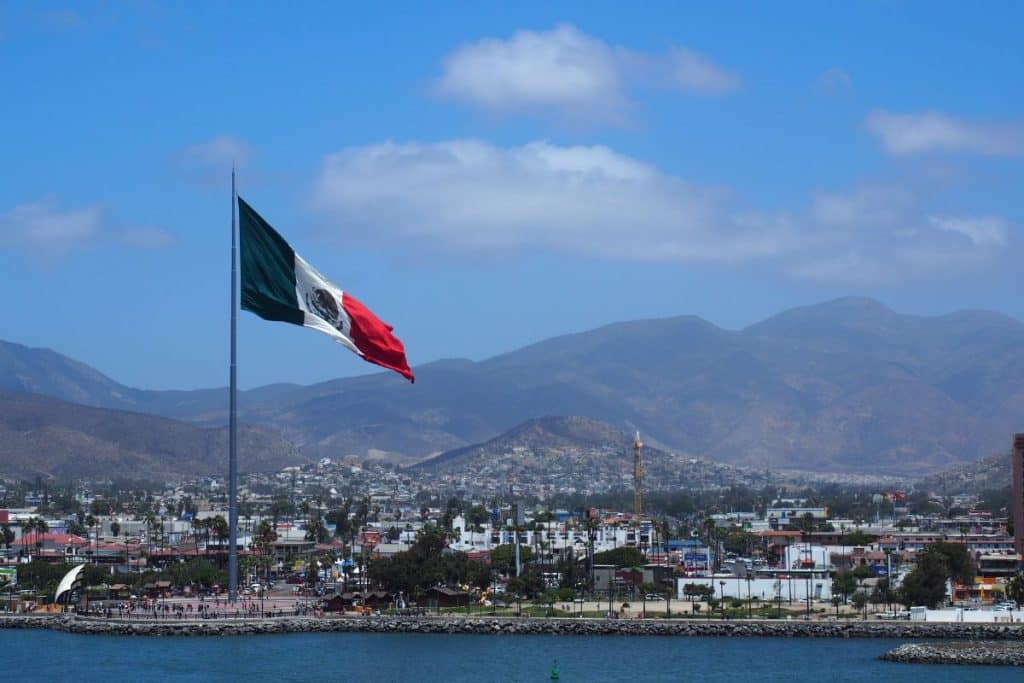
Ensenada, a coastal city in Baja California, Mexico, has been experiencing challenges with crime. While it remains a popular tourist destination, recent years have seen incidents of violence, including armed robberies and homicides.
According to residents and press reports, violence has increased. However, tourism and locals have not been affected by this unrest.
In the last months, the number of violent murders in Ensenada and Tijuana has increased, mostly at night and outside the city center. The city center is still very safe, although there are some risks in the ungated neighborhoods further out.
The accounts state that over 1000 people were brutally murdered each year. The rise in drug sales, thefts, and human trafficking were all noted, so the story doesn’t end here. It is unsafe to spend your holiday in Celaya.
Currently, Celaya is regarded as one of the most dangerous cities in the world, with 109.38 killings per 100,000 residents.
10. Coatzacoalcos
With a homicide rate of 48 per 100,000 residents, Coatzacoalcos was once a vibrant tourist spot in Veracruz. Today, it is the sight of violence where recently nine bodies were left on the street. Murder, robbery, and violent crime make this city one of the top ten most dangerous in Mexico.
9. Ciudad Obredón
Cuidad Obregon is the second largest city in Sonora, but now has a new notoriety – being named the fourth most dangerous city in the world in 2022. This rise in violence is not just in Ciudad Obredon, but in the surrounding area of Cajame, the state’s southernmost region. Only time will tell if this steep increase in crime will continue to hold. Its current homicide rate is 52 per 100,000 residents.
8. Uruapan
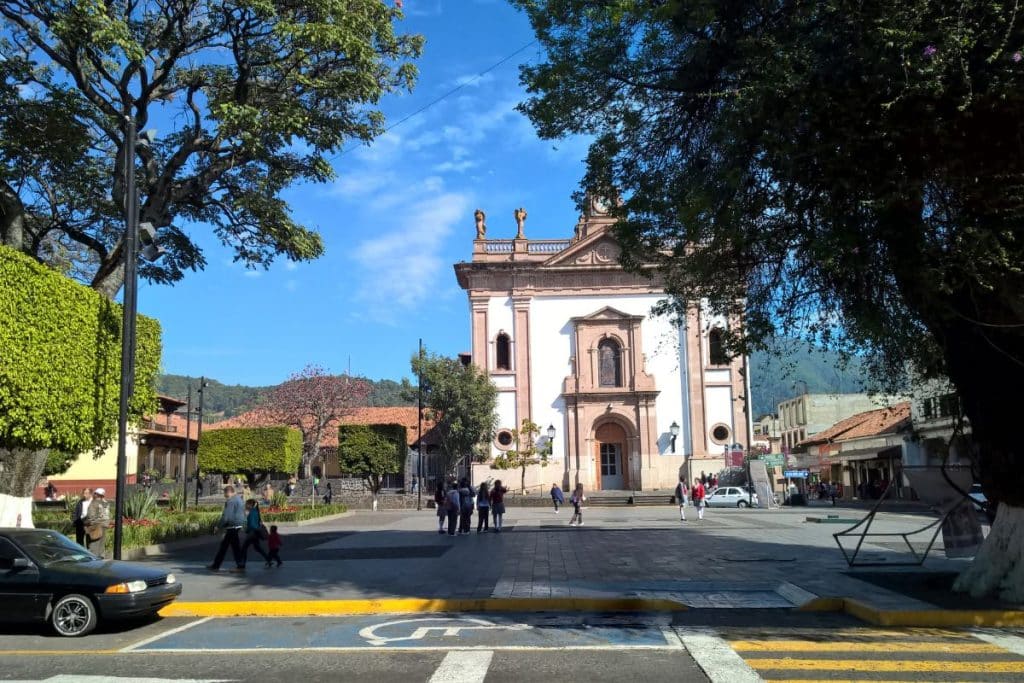
In Uruapan, violence has steadily increased for this mountainside city in Michoacan. Sadly, it seems as though the violence here only continues to escalate. The once quiet town is now home to battling cartels that consistently change hands and names. Killings occur in the most indiscreet areas, such as arcades and bars. The current homicide rate here is 55 per 100,000 residents.
7. Culiacán
While Culiacan was once seen as a mid to low-level dangerous city, it is now the site of a deadly battle that occurred due to the arrest of cartel leader El Chapo’s son, Ovidio Guzman. The city has a homicide rate of 61 per 100,000 people and is considered the central city in Sinaloa. The Sinaloa Cartel has a firm grip on the city and its residents, making it incredibly dangerous for tourists to visit.
6. Cancun
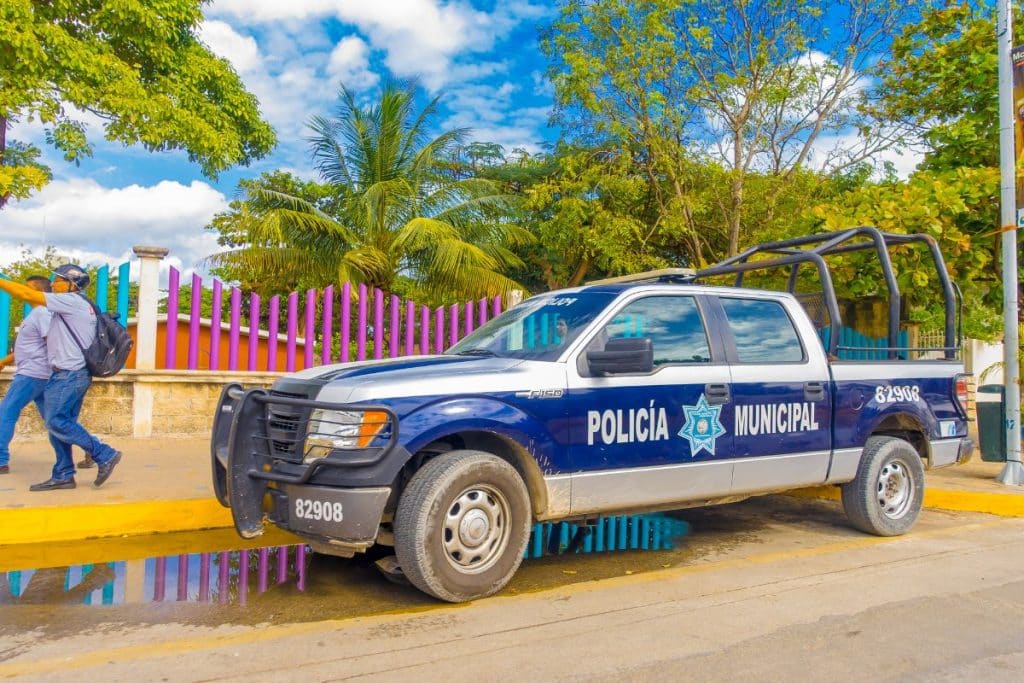
Mexican President Andres Manuel Lopez Obrador has recently warned tourists about the dangers of visiting Cancun after a string of cartel-related shootings, robberies, and attacks on tourists in the city. The homicide rate here is 64 per 100,000 people, making it far less deadly than other cities in Mexico, but still notorious for its high levels of violence.
5. Irapuato
Irapuato is located in the central state of Guanajuato, and in the past three years has seen a sharp increase in homicides due to drug-related violence. The city has a homicide rate of 81 per 100,000 people, making it one of the most unsafe cities for tourists and, unfortunately, locals that call this city home. Murders here are largely attributed to turf wars between the Jalisco Cartel New Generation and the Santa Rosa de Lima Cartel.
4. Ciudad Juarez
Another border city, residents of El Paso can see Ciudad Juarez from their side of the Rio Grande. It is one of the most violent cities in Mexico, with a homicide rate of 86 per 100,000 people. The city is another hotbed for drug trafficking and has seen a sharp rise in violence due to turf wars between the Juarez and Sinaloa cartels. Both of these powerful cartels have a strong presence in Ciudad Juarez.
3. Ciudad Victoria
Located in Tamaulipas state, Ciudad Victoria is one of the most violent cities in Mexico. The homicide rate here stands at 86 per 100,000 people and it is another hot spot for drug-related violence. It is also an entryway city, with Tamaulipas sitting just beyond the U.S. border. Members of the Northeast Cartel actively run their operations in Ciudad Victoria.
2. Acapulco
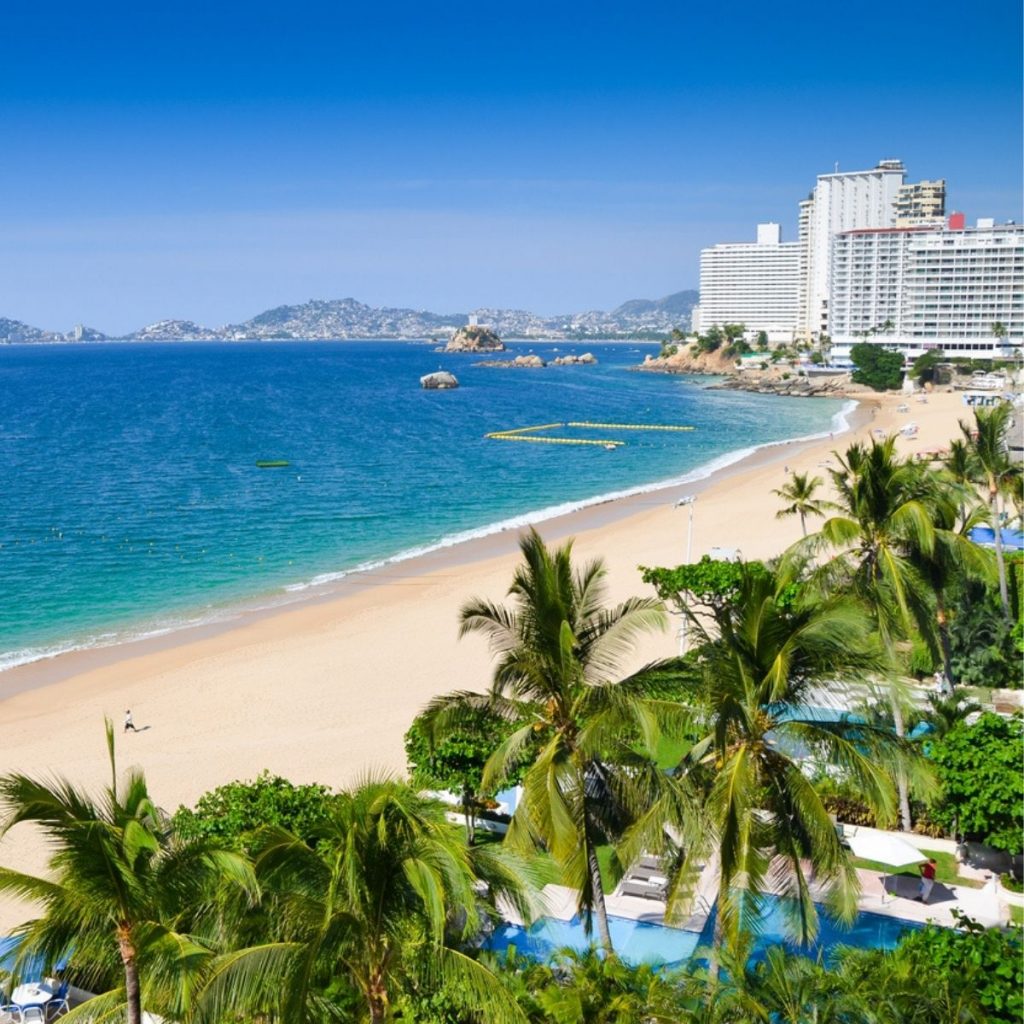
While many tourists still flock to Acapulco for its beaches, it is also one of the most dangerous cities in Mexico.
The city’s homicide rate is 111 per 100,000 people. Acapulco has seen a sharp rise in drug-related violence as various cartels battle for control of the city’s lucrative drug trade. This city is also situated inside of Guerrero, the infamous state known for its high levels of violence, turmoil due to turf wars between gangs, and for its production of heroin.
1. Tijuana
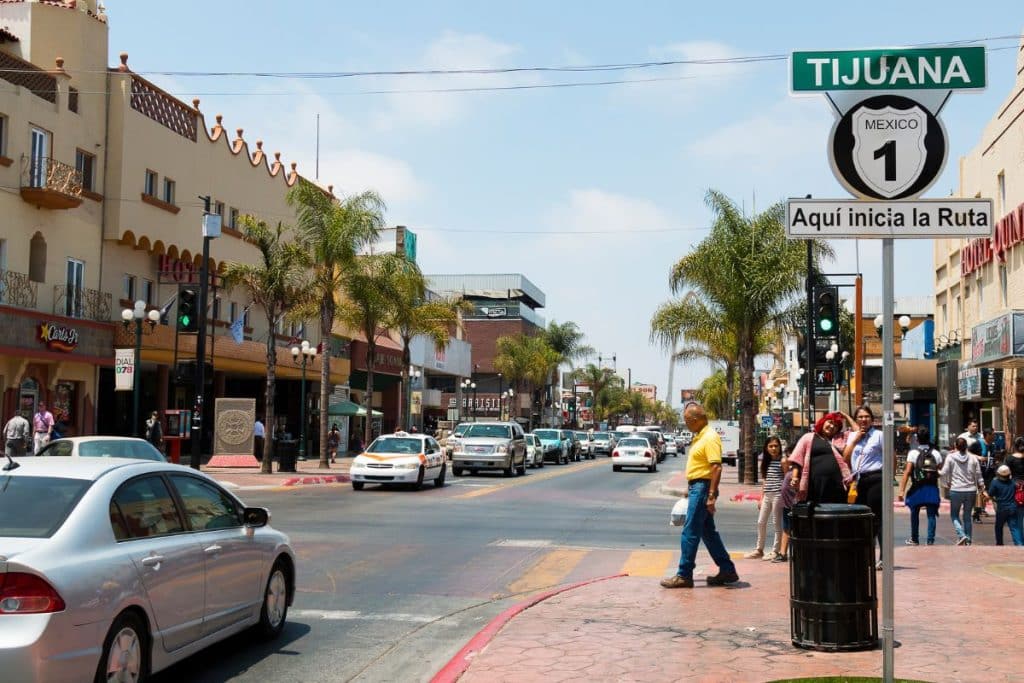
Tijuana is considered the most dangerous city in Mexico due to its high rate of homicides and drug-related violence.
The homicide rate is 138 per 100,000 people. As the main entry point for drugs coming from South America, Tijuana is a hotbed of cartel activity. Being close to the border with the United States, it is also a major center for human trafficking and organized crime.
Tijuana is also considered the most dangerous city in the world , according to homicide rate stats.
Current U.S. Travel Advisory for Mexico
As of 2023, the U.S. Department of State’s travel advisory for Mexico highlights varied levels of caution across different states due to concerns about crime and kidnapping. The advisory classifies regions in Mexico under four levels:
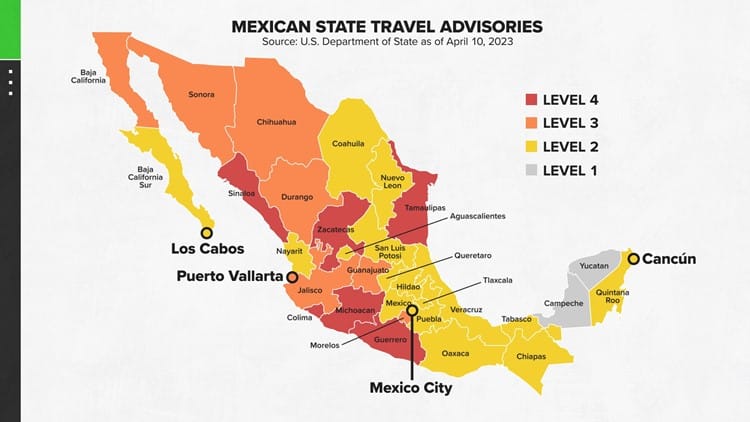
- Exercise Normal Precautions : This is the lowest advisory level for safety and security risk. Some states in Mexico fall under this category, suggesting a relatively lower level of concern for travelers.
- Exercise Increased Caution : The advisory recommends increased awareness due to crime or other safety concerns. In Mexico, this includes areas where there is a heightened risk of violent crime such as homicide, kidnapping, and carjacking.
- Reconsider Travel : This level advises travelers to reconsider travel plans to certain areas due to serious risks to safety and security. Parts of Mexico with higher levels of crime, gang activity, and drug-related violence are typically placed under this category.
- Do Not Travel : The highest level of advisory, indicating that the region is considered too dangerous to visit. This is often due to severe crime, such as areas controlled by drug cartels or where government control is limited.
Do Not Travel To:
- Colima state due to crime and kidnapping .
- Guerrero state due to crime .
- Michoacan state due to crime and kidnapping .
- Sinaloa state due to crime and kidnapping
- Tamaulipas state due to crime and kidnapping.
- Zacatecas state due to crime and kidnapping .
Reconsider Travel To:
- Baja California state due to crime and kidnapping .
- Chihuahua state due to crime and kidnapping .
- Durango state due to crime .
- Guanajuato state due to crime and kidnapping .
- Jalisco state due to crime and kidnapping .
- Morelos state due to crime .
- Sonora state due to crime and kidnapping .
Where is the ‘Vine Valley’ you refer to near Ensenada?
It’s called the Valle de Guadalupe, and it’s amazing. Like Napa except cheaper and possibly more gorgeous? I stay over night and make sure to hit up at least 5-6 wineries and restaurants (the food is also amazing).
Ensenada Centro where several cruises a week is pretty safe.
Leave a Reply Cancel reply
Your email address will not be published. Required fields are marked *
- Skip to primary navigation
- Skip to main content
- Skip to primary sidebar
- Skip to footer
TravelAwaits
Our mission is to serve the 50+ traveler who's ready to cross a few items off their bucket list.
Places to Avoid in Mexico According to The U.S. State Department | Here’s Where You Should And Shouldn’t Travel

- News and Tips
- Travel News
Some places in Mexico, including Cancun and Puerto Vallarta, are extremely popular destinations for Americans traveling during spring break and Easter.
The U.S. State Department, however, has issued a number of advisories for U.S. citizens traveling to various Mexican states in recent weeks. Now, as violent crime and kidnapping rates increase across Mexico, Americans considering travel to all but two of the states in Mexico should be aware of renewed and increasing warnings, the State Department cautions.
“Violent crime — such as homicide, kidnapping, carjacking, and robbery — is widespread and common in Mexico,” the State Department explains . “The U.S. government has limited ability to provide emergency services to U.S. citizens in many areas of Mexico, as travel by U.S. government employees to certain areas is prohibited or restricted. In many states, local emergency services are limited outside the state capital or major cities.”
Is Mexico Dangerous For Tourists?
While there are so many wonderful things about Mexico, drug cartels and violent crime have crept back into the news in recent years. This is why a lot of people are concerned for their safety in Mexico when planning a trip.
In general, Mexican drug cartels do not want to harm American tourists, but it is also true that the armed groups operate independently. If you visit popular tourist destinations, it is very common to be offered illegal drugs by a passerby. You should always say no, as these individuals are almost always connected to a major drug cartel.
Foreigners have a negative idea about how dangerous Mexico is because the U.S. State Department has high standards when it comes to risk aversion, and their travel warnings regarding Mexico may sometimes seem like fear-mongering. However, this doesn’t apply to places in Mexico that are truly dangerous and should be avoided.
American citizens, as well as Europeans, Canadians, and other tourists outside of Latin America, are generally very safe in Mexico so long as they don’t seek out illegal activities. Sought-after tourist destinations are generally not among the riskiest areas in Mexico.
Places to Avoid in Mexico According to The U.S. State Department
Here are the State Department’s recommendations for U.S. citizens considering travel to Mexico.
Do Not Travel To
The State Department recommends U.S. citizens not to travel to five states in Mexico due to increasing levels of crime and kidnapping.
Those states are Colima (where Manzanillo is located), Michoacan, Sinaloa (where Mazatlán is located), Tamaulipas, and Zacatecas (home to Zacatecas City).
Guerrero — where Acapulco, Zihuatanejo, and Ixtapa are located — is also on the State Department’s “Do not travel” list because crime is widespread in those areas.
Reconsider Travel To
The State Department recommends U.S. citizens reconsider travel to five states in Mexico due to crime and kidnapping.
Those states are Baja California (where Tijuana is located), Chihuahua, Guanajuato (where Guanajuato City is located), Jalisco state (home to Guadalajara and Puerto Vallarta), and Sonora.
The states of Durango and Morelos are also on the State Department’s “Reconsider travel” list due to high crime rates.
Exercise Increased Caution When Traveling To
The State Department recommends U.S. citizens exercise increased caution when traveling to 17 areas of Mexico, primarily due to crime rates but also the threat of kidnapping in some places.
Those states are Aguascalientes, Baja California Sur (where Cabo San Lucas , San Jose del Cabo, and La Paz are located), Chiapas, Coahuila, Hidalgo, Mexico State, Nayarit, Nuevo Leon, Oaxaca (home of Oaxaca City and Huatulco), Puebla, Queretaro, Quintana Roo (where Cancun , Cozumel, Tulum, and Riviera Maya are located), San Luis Potosi, Tabasco, Tlaxcala, and Veracruz.
Mexico City is also on the list due to high crime rates.
Exercise Normal Precautions When Traveling To
The State Department recommends U.S. citizens exercise normal precautions when traveling to Campeche and Yucatan, where Chichen Itza and Merida are located.
Know Before You Go
If you decide to travel to Mexico, the State Department offers some guidance.
“Exercise increased caution when visiting local bars, nightclubs, and casinos,” the State Department recommends. “Do not display signs of wealth, such as wearing expensive watches or jewelry. Be extra vigilant when visiting banks or ATMs.”
The State Department also recommends that travelers in Mexico keep both traveling companions and friends or family at home up to date about their travel plans.
Finally, if you are alone and take a taxi or Uber, be sure to take a photo of the taxi number and/or its license plate and text it to a friend or family member, the State Department recommends, especially if you’re a woman. Mexico is considered one of the five most dangerous countries for women .
You can find a detailed explanation of the threats in each state in Mexico and learn more about being safe while traveling within Mexico in the State Department’s Mexico Travel Advisory .
What Are Mexico’s Most Dangerous Cities?
The most dangerous places in Mexico are Tijuana and Acapulco, followed by Ciudad Victoria and
Ciudad Juarez in the third place. Mexico’s northern border and Central Mexico are among the least safe places in Mexico. Tijuana is even considered the most dangerous city worldwide.
Are Popular Tourist Destinations in Mexico Dangerous?
Major tourist areas popular with American tourists like San Miguel de Allende or the coastal city of Mazatlan are typically not among the most dangerous places in Mexico. However, criminal activity can occur in otherwise safe tourist zones in the southern region as well, so you better exercise caution.
Are Beaches in Mexico Safe?
The most popular beaches in Mexico such as Playa del Carmen are considered low-risk. Reports of gang activity and cartel-related violence in the media are scaring the public away, but Washington and Mexican authorities are ensuring that policing standards stay high in popular destinations.
Is the Mexican Government Doing Enough to Counter the Organized Crime?
Mexican authorities claim to be doing all that they can to combat organized crime, and many local authorities are. However, with crime rates high and prosecutions low, people’s confidence in the state and its institutions is waning further.
Is Mexico City Dangerous for Tourists?
While Mexico City has areas with safety concerns, many tourist areas are generally safe. Exercise caution, stay in well-traveled areas, and follow local advice. Take usual precautions, and enjoy the rich cultural offerings and Mexico City historical sites.
How Can I Stay Safe in Mexico?
Mexican drug cartels do not want to harm tourists but you should exercise extreme caution anyway. Reconsider your need to travel to violent cities and remote areas as criminal groups frequently maintain roadblocks. Also, use ATMs in public spaces and during the daytime.

Jim Fulcher has been a writer and editor his entire career. In addition to writing, he also enjoys traveling--particularly in an RV. Over the course of numerous trips, Jim has driven an RV through West Virginia, Virginia, Tennessee, Kentucky, Indiana, Illinois, Wisconsin, Iowa, Nebraska, South Dakota, and Wyoming. His favorite national park is Yellowstone, which he has visited three times.
Most Dangerous Places in Mexico
There are many reasons to visit Mexico. Beautiful beaches, delicious food, a rich culture with a complex history, and friendly people are just some reasons the country attracts millions of tourists each year.
However, it’s also true that there are places in Mexico that just aren’t very safe. Some main reasons for unstable areas are the presence of drug cartels and unreliable law enforcement. Violent crime and kidnapping are some of the most worrying things to look out for, and some states are far worse than others.
The 16 Most Dangerous States in Mexico
In this post, we’ll look at the most dangerous places in Mexico as defined by the U.S. Department of State and the travel notices it sets. We’ll also examine the crime rates in Mexico and see how they compare to other countries.
Dangerous States in Mexico:
Mexico Travel Warning Map
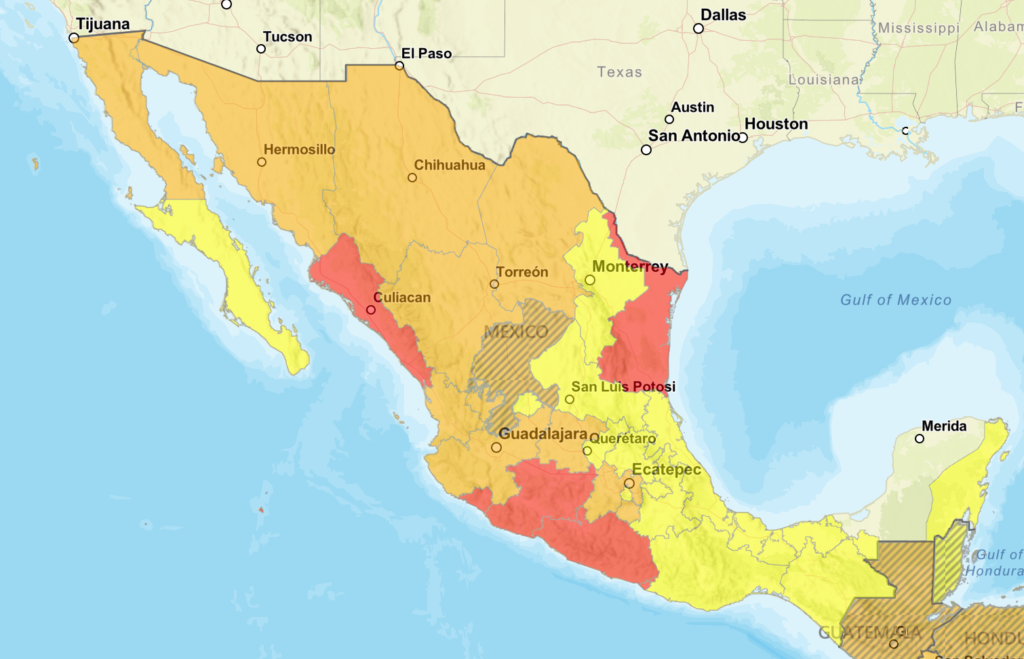
5 Do Not Travel States
“Do Not Travel” is the most severe travel notice that the U.S. Department of State issues, out of four possible travel advisory levels. It is what the department issues when there are greater, potentially life-threatening risks in an area.
There are currently five Mexican states with a “Do Not Travel” advisory :
Colima is a small Mexican state on Mexico’s Pacific coast and is the home of Manzanillo, a beach town with tourist resorts and consistently warm weather. It is posted as a “Do Not Travel” state because of the prevalence of violent crime, kidnapping, and gang activity, which are widespread.
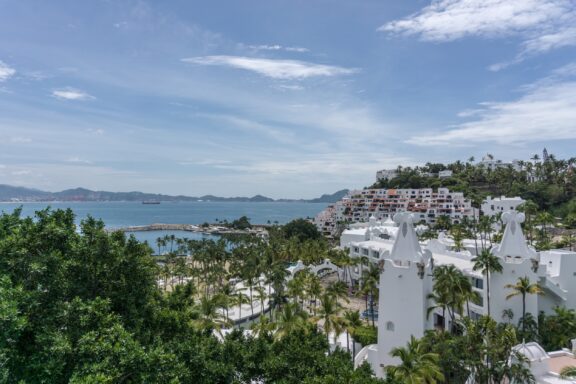
U.S. government employees are prohibited from traveling to the city of Tecomán, the Colima/Michoacán Border, and the non-tourist areas of Manzanillo.
2. Guerrero
Located between the states of Michoacán and Oaxaca, Guerrero is also listed as a state that should be avoided. The reasons for this are violent crime and kidnapping. There are several armed groups that act independently of the government in this state, and they have been known to set up roadblocks and to use violence toward travelers.
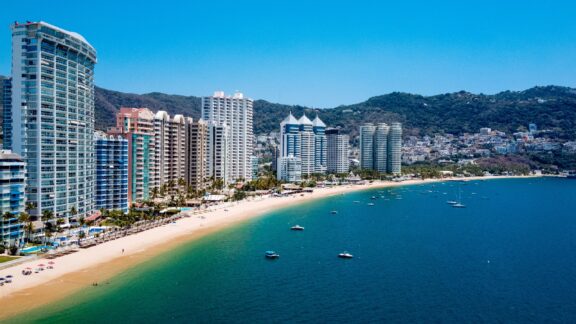
The very popular resort towns of Acapulco and Ixtapa are located in Guerrero. Both of these locations attract large numbers of tourists each year that are seeking sun and beautiful beaches. Agriculture and livestock breeding are other important parts of the state’s economy.
Most of Guerrero is restricted for U.S. government employees, except for portions of Taxco.
3. Michoacán
Michoacán is situated between Colima and Guerrero, forming three neighboring states on Mexico’s Pacific coast with a “Do Not Travel” designation. This is for the same reason as the other two: a high prevalence of crime and kidnapping.
Part of the Monarch Butterfly Reserve is located in Michoacán, as are many Spanish colonial towns that make it an attractive location for tourists.
The Sinaloa Cartel is one of the most famous drug cartels in the world, and they are responsible for trafficking an immense portion of the illicit drugs that enter the United States. They are also one of the main reasons this state is so dangerous.
Mazatlán, a very popular resort destination for tourists coming to Mexico, is located in the state of Sinaloa, and it is one of the few places U.S. government employees are allowed to travel to.
5. Tamaulipas
Tamaulipas is located on the Gulf of Mexico and borders the US state of Texas to the north. It is an important center for Mexico’s fishing industry.
The state is listed as “Do Not Travel” because of high incidences of violent crime and kidnapping. There are armed groups committing organized crime activities such as kidnapping, carjacking, armed robbery, murder, and more, especially along the northern border.
11 “Reconsider Travel” States
The states in this “Reconsider Travel” category are listed as such because of “serious risks to safety and security” as described by the U.S. State Department. The State Department provides additional, area-specific advice for these areas.
- Baja California
In Mexico, the “Reconsider Travel” designation is usually due to increased levels of violent crime and kidnapping in the area. Most of the violent crime in these Mexican states takes place between members of criminal organizations, but these incidents sometimes take place in areas that are frequented by tourists. Collateral damage is often the greatest risk to visitors.
How Dangerous is Mexico?
It isn’t easy to say exactly how dangerous Mexico is. The truth is that danger levels in the country vary by region, just as in any other country. Some people are more at risk than others, as well. For example, young males form the vast majority of homicide victims.
With that in mind, it’s certainly true that it is important to take more precautions to stay safe in Mexico than it is in many other countries.
How Many Homicides are there in Mexico?
As demonstrated by the table above, the homicide rate is significantly higher in Mexico than it is in the United States or the United Kingdom.
Is Mexico Safe for Tourists in 2022?
There are plenty of places that are safe in Mexico for tourists in 2022, but it’s important to exercise caution and carefully plan your destinations. Mexico is among the top countries worldwide for total tourist visitors — tens of millions come to the country each year, and the vast majority have a trouble-free stay.
However, there are occasionally tourist victims of violent crime. Sometimes this is because the tourists were engaged in illegal activity, and sometimes it is simply collateral damage from gang violence. Generally, resorts and popular tourist areas are safe. The Mexican government sometimes deploys marines to these areas to ensure the safety of visitors.
Some measures visitors can take to keep themselves safe include not traveling alone or at night, remaining aware of their surroundings, and taking extra care when using ATMs. Learning basic Spanish can also increase your level of safety.
Which Are the Safest States in Mexico in 2022 ?
The only states in Mexico that do not have a travel advisory from the U.S. State Department are Yucatán and Campeche. It is advised to exercise normal precautions that should be taken when traveling anywhere, but there isn’t an elevated safety risk in either of these states. They are located on the Yucatán Peninsula, an area that constituted a large part of the Maya Civilization.
The Mexican state of Yucatán is a popular destination for many. It’s known for beautiful beaches, tropical rainforests, cenotes, and for being the home of the ancient Maya people. The ruin of Chichen Itza is located here and is a UNESCO World Heritage Site. The pink lakes of Las Coloradas on the coast in the state of Yucatán are another attraction that draws many tourists.
The capital city of Yucatan is Merida, sometimes referred to as the “White City.” It is the largest city on the Yucatan Peninsula and serves as the cultural capital of the state. It is also one of the safest cities in Mexico.
The state of Campeche is located on the Yucatan Peninsula next to Yucatan, Tabasco, Quintana Roo, and Guatemala. Its capital city is San Fransisco de Campeche and it has one of the smallest populations of any Mexican state. Mining and oil production are the largest contributors to the state’s economy.
One of the most popular tourist destinations in Campeche is the city of Ciudad del Carmen, which is on the coast. It boasts peaceful beaches and colonial buildings that make for a beautiful and relaxing atmosphere. While the coastal areas are noteworthy for being quiet in Campeche, the most beautiful beaches in Mexico are found elsewhere.
Other states that are generally considered safe include Mexico City, Oaxaca, Chiapas, Quintana Roo, and Puebla.
Crime Rates by State
Whereas the information regarding the most dangerous states in Mexico is mostly focused on violent crimes such as homicide, kidnapping, and violent robbery, the crime rates described below consider non-violent crimes as well. These types of crimes include petty theft, pickpocketing, and others that don’t threaten your physical wellbeing.
Crime rate per 100,000 inhabitants in 2020, by state in Mexico.
Crime rate in Mexico in 2020, by state (per 100,000 inhabitants), Source: Statista
The region in Mexico with the highest crime rate, by far, is Mexico City. But that doesn’t mean that it’s necessarily the most dangerous state. It’s important to recognize just how massive Mexico City is when thinking about its safety. There are well over 20 million people in Greater Mexico City, and it ranks fifth among the most populous cities in the world.
The incredible size of Mexico’s capital city means that there are many drastically different parts of the city, and the most dangerous parts aren’t those that are usually visited by tourists and foreigners. It’s common for residents of these safer parts of Mexico City to feel much safer in the city than when traveling to other parts of the country.
Also, evident in the above table is that the state of Tamaulipas has the third-lowest crime rate in the country. This could be misleading, as the state is listed as one of the five “Do Not Travel” states by the U.S. Department of State. While there may be lower levels of petty crime, higher instances of kidnapping and violent crime make it one of the least safe states in Mexico.
At least three of the five most dangerous states in Mexico are on the half of the list with the lowest crime rates. It is also possible that crime reporting in these states is not as comprehensive or effective as in states with higher reported crime rates.
What is the Safest Place in Mexico?
Merida, the capital city in the state of Yucatán, is probably the safest city in Mexico. It has a low rate of homicides and is widely considered to be one of the safest places in Latin America. One reason for being safer is its geographic isolation, which makes it less appealing to drug cartels.
Is it Safe to Move to Mexico?
If you plan carefully and take basic safety precautions, yes, it is safe to move to some areas of Mexico. The most dangerous states and areas of the country should be avoided, and it’s important to maintain good safety practices wherever you live in the country. Many foreigners move to Mexico each year and live safely in places like Mexico City, Merida, or Puerto Vallarta.
What is the Most Dangerous Country in Latin America?
The country with the highest homicide rate in Latin America is Venezuela. The political situation in Venezuela is highly unstable, and the economy has been in dire straits for several years, putting a strain on public services and basic safety. Honduras also has a high homicide rate in Latin America, and Mexico comes in as the third-most dangerous. The safest country in Latin America is Chile.
Is Mexico More Dangerous Than the US?
When looking at homicide rates, Mexico is clearly more dangerous than the US. But homicide rates don’t paint the whole picture. The vast majority of homicides in Mexico take place between members of criminal organizations, and foreigners are not often the ones affected. The homicide rate for US citizens inside Mexico is significantly lower than for US citizens living within the USA.
- Coastal Cityscape with Beach and Skyscrapers: © Daniel Elizalde S/Shutterstock
Get Daily Travel Tips & Deals!
By proceeding, you agree to our Privacy Policy and Terms of Use .
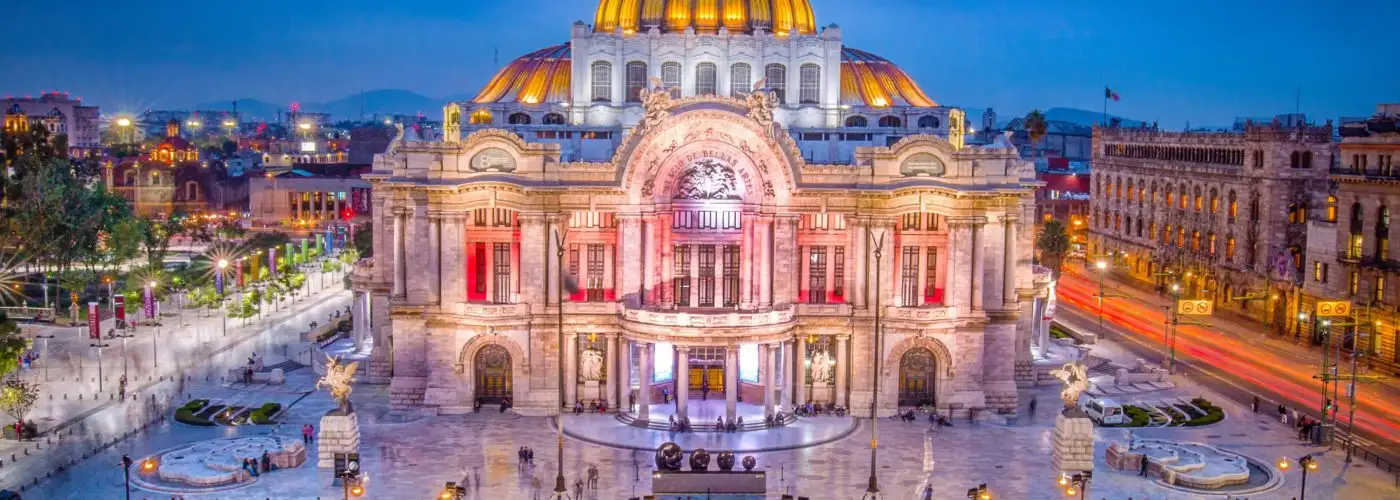
The 8 Safest Places in Mexico for Travelers
Ed Hewitt started traveling with his family at the age of 10 and has since visited dozens of countries on six continents. He wrote for IndependentTraveler.com for more than 20 years, producing hundreds of columns on travel and offering his expertise on radio and television. He is now a regular contributor to SmarterTravel.
An avid surfer and rower, Ed has written about and photographed rowing competitions around the world, including the last five Olympic Games.
He's passing his love of travel on to the next generation; his 10-year-old son has flown some 200,000 miles already.
Travel Smarter! Sign up for our free newsletter.
“Is my destination safe?” It’s a question many American travelers have asked themselves as they pour over the State Department’s travel advisories and color-coded maps .
Mexico is a vast country, with heaps of beautiful and interesting places to see, and some 28 million Americans safely travel there each year. To help you plan your own trip, I’ve gathered some of the safest places to visit in Mexico, complete with information on why you should go and where to stay.
The Safest Places in Mexico
Keep in mind that incidents can happen even in the safest places in Mexico, and destinations that don’t appear on this list could still be great spots for a vacation. No matter where you go while traveling abroad, you’ll want to follow common-sense rules such as drinking only in moderation, getting a cab instead of wandering around after dark, and leaving your valuables at home.
Mexico City
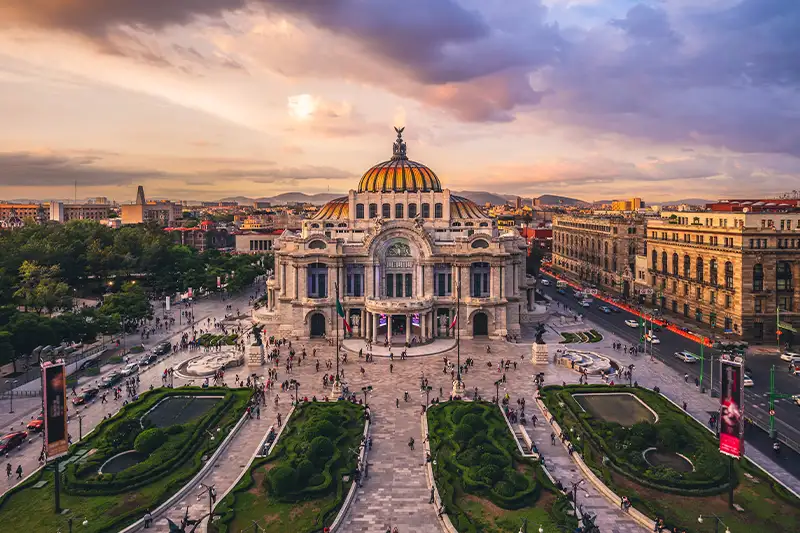
Despite a longstanding reputation as a dangerous city to visit, Mexico City only has an advisory to exercise increased caution, and for good reason; the downtown core in particular is considered quite safe, and the city has numerous attractions for visitors—including street art, colorful markets, and more than 150 museums.
Where to Stay: The small, beautifully decorated Nima Local House Hotel is one of the best luxury hotel options in the city. For a more affordable option, consider the Chillout Flat Bed & Breakfast , which earns plaudits for friendly service and homemade granola.

Nima Local House
Chillout Flat B&B
The 5 Best Things to Do in Mexico City
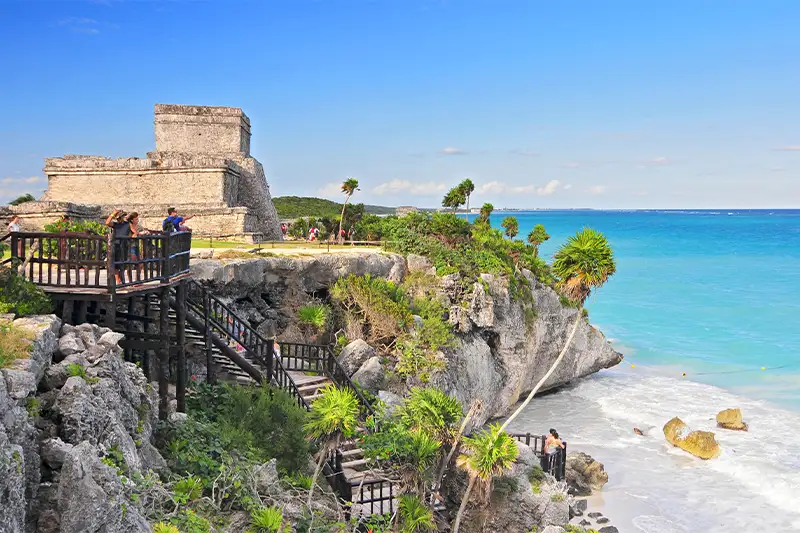
As Playa del Carmen has been the site of some troubling violence in the past, the coastal town of Tulum to the south may be a safer alternative. It is also less touristy than other resort towns on the Yucatan Peninsula, offering well-preserved ruins of the former Mayan city walls and other historic structures right in town. The State Department has explicitly stated there are no restrictions on travel to Tulum or to Chichen Itza, the magnificent archaeological site just an hour up the road.
Where to Stay: Guests appreciate the clean, comfortable rooms and fast Wi-Fi at the centrally located Posada Luna del Sur .
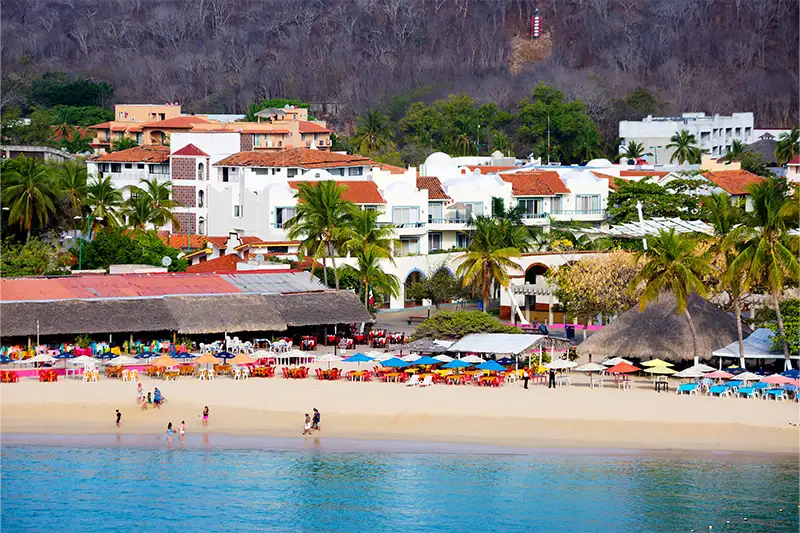
A beach town located in Oaxaca to the southwest of Puerto Escondido, Huatulco offers tons of water activities such as snorkeling and scuba diving, some nearby surf spots, and tours of coffee farms to boot. Huatulco is considered one of the safest places in Mexico.
Where to Stay: For an indulgent resort experience you can’t do much better than Secrets Huatulco Resort & Spa , where amenities include multiple swimming pools and tennis courts, yoga classes, watersports, and nine restaurants.
Merida and Valladolid
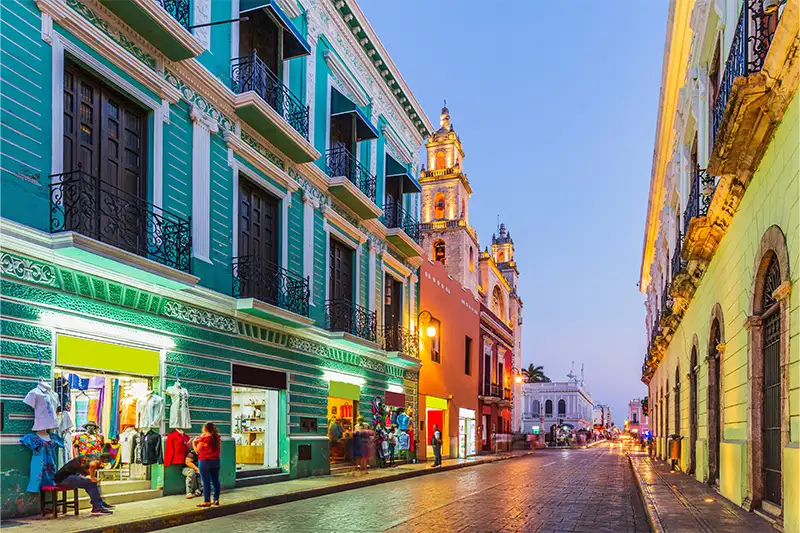
Gerardo Tanaka Pacheco, Senior Account Executive for MSL Group, the public relations firm for VisitMexico.com , recommends these two towns as great alternatives to other nearby tourist hot spots. “A lot of people go to Playa del Carmen and Tulum, but on the Yucatan Peninsula there are these two beautiful colonial cities that are so welcoming, colorful, and full of traditions that travelers won’t regret visiting them,” he says.
Merida is a walking-friendly town that is connected to Chichen Itza by a toll road, which is considered the safest way to travel in Mexico if you are driving. The Mayan influence remains strong here, and the area has its own style of cuisine that diverges considerably from what you will find in other parts of Mexico.
Midway between Merida and Cancun is Valladolid, a colorful and friendly city that’s within easy driving distance of several beautiful cenotes.
Where to Stay: In Merida, consider snagging a poolside room at the Luz En Yucatan . In Valladolid, you can’t go wrong at the centrally located Hotel Posada San Juan .
Luz En Yucatan
Hotel Posada San Juan
10 Travel Safety Mishaps and How to Avoid Them
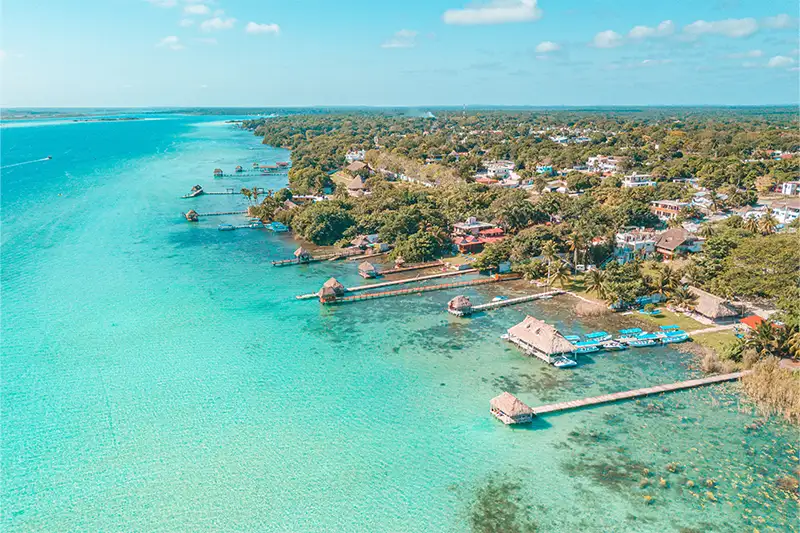
Pacheco says that Bacalar, also on the Yucatan Peninsula, is “an amazing place, kind of unknown and definitely uncrowded. This is one of my favorite secrets spots in Mexico; the lagoon there is unbelievable.”
Called the Lake of Seven Colors, the lagoon stretches for 42 kilometers and is fed by underground rivers. Like Todos Santos mentioned below, Bacalar holds the official designation as a “Pueblo Magico,” or Magical Town, due in large part to the lagoon. In addition to being one of the safest places in Mexico, Bacalar is also very affordable.
Where to Stay: At the Bacalar Lagoon Resort , you can get a view of the lake right from your cabana.
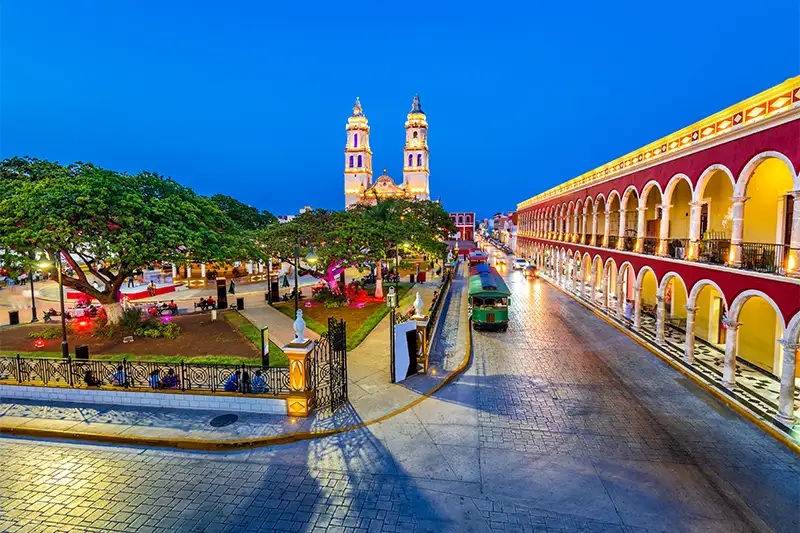
Another UNESCO World Heritage Site located on the western coast of the Yucatan Peninsula, Campeche is a walled Spanish colonial city that has been superbly restored. The walled center is somewhat of a museum piece, but the life of the town surrounding it might even be the main attraction. There are also significant Mayan ruins in the state of Campeche, of which the city is the capital; these aren’t as well known as the famous ruins to the east, and as such they’re less crowded.
Where to Stay: Try for a balcony room or suite at the modestly priced Hotel Socaire .
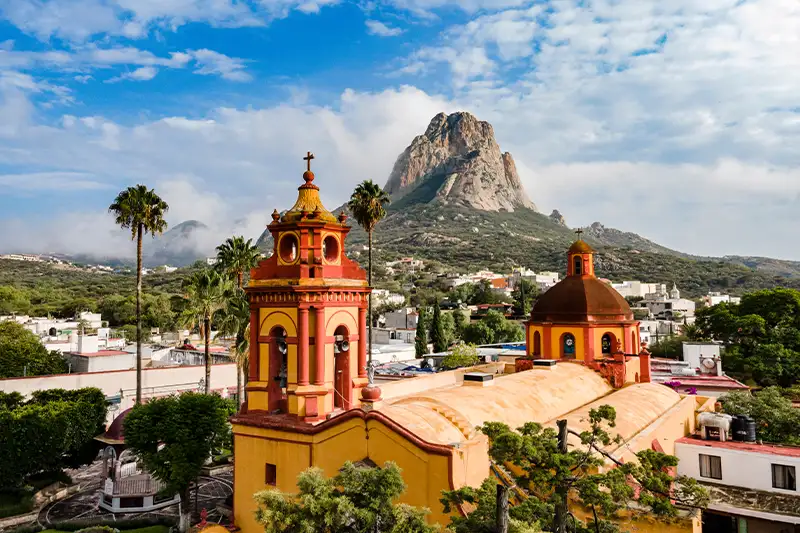
Queretaro’s streets are a wondrous mix of old and very old, as grid-like Spanish streets connect to the pre-Hispanic winding lanes from the time of the Otomi. From rock climbing and art galleries to architecture sightseeing, there is a ton to do in this central Mexican city.
Where to Stay: La Casa del Atrio , across from the Museo de Arte , is both popular and affordable.
Is Cabo San Lucas Safe? Swimming Dangers, Drinking Water, and More
Todos Santos
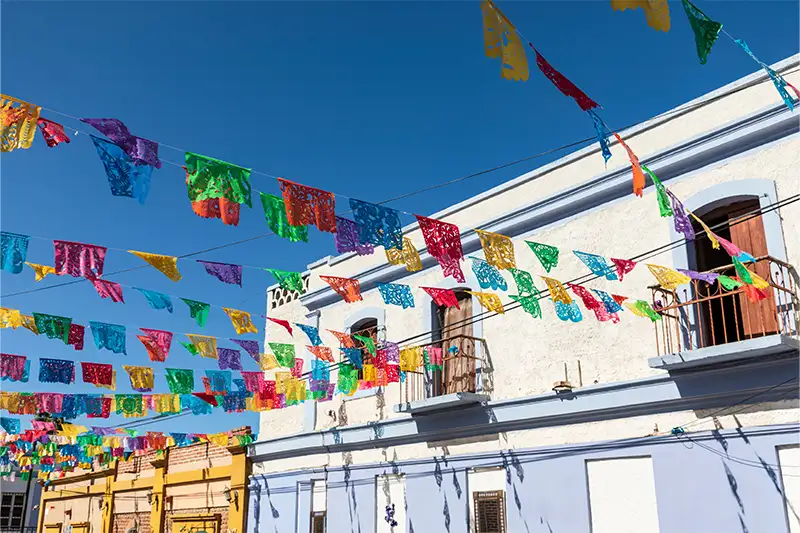
This surf town in Baja California Sur features world-class waves and lots of natural beauty—and it’s just far enough north of touristy Cabo San Lucas to offer respite from the crowds. Todos Santos is slowly becoming more popular, but its stone streets and uncrowded beaches have earned it the official Pueblo Magico designation.
Where to Stay: La Poza Boutique Hotel & Spa has a fantastic oceanfront location at very reasonable rates.
You Might Also Like:
We hand-pick everything we recommend and select items through testing and reviews. Some products are sent to us free of charge with no incentive to offer a favorable review. We offer our unbiased opinions and do not accept compensation to review products. All items are in stock and prices are accurate at the time of publication. If you buy something through our links, we may earn a commission.
Top Fares From

Don't see a fare you like? View all flight deals from your city.
Today's top travel deals.
Brought to you by ShermansTravel
Oslo to Bergen: 6-Night Norway Fjords...

Luxe, 7-Night Caribbean & Mexico Cruise...
Regent Seven Seas Cruises

Shop and Save with Country Inns...
Patricia Magaña

Trending on SmarterTravel
World News | Mexico danger map: Latest warnings from U.S….
Share this:.
- Click to share on Facebook (Opens in new window)
- Click to share on Twitter (Opens in new window)
- Click to print (Opens in new window)
- Click to email a link to a friend (Opens in new window)
- Click to share on Reddit (Opens in new window)
Today's e-Edition
- Latest News
- Environment
- Transportation

Breaking News
World news | evacuation order for tracy as corral fire spreads to 8,800 acres, world news | mexico danger map: latest warnings from u.s. state department.
Update, 2023: The travel warnings have been changed since this article was published. The more recent map is here .
Even as travel is discouraged to all of Mexico because of the COVID-19 pandemic, the U.S. State Department continues to update its warnings concerning kidnappings and other crimes in the country’s states.
Level 4 : The five states with the sternest “do not travel” advisory, because of kidnappings and other crimes, are the northern border state of Tamaulipas and the Pacific coast states of Sinaloa, Colima, Michoacán and Guerrero. They are shown in red on the map above.
Level 3 : Baja California (Norte) has been added this year to the list of states for which visitors are advised to “reconsider travel” because of crime. The 10 other states in that category are Chihuahua, Coahuila, Durango, Guanajuato, Jalisco, Mexico, Morelos, Nayarit, Sonora and Zacatecas. They are shown in orange on the map.
The warning for Baja California, which includes Tijuana and Ensenada, cites violence by criminal organizations involved in drug trafficking and human smuggling. “Of particular concern is the high number of homicides in the non-tourist areas of Tijuana,” the advisory says. “Most homicides appeared to be targeted; however, criminal organization assassinations and territorial disputes can result in bystanders being injured or killed.” It also mentions that U.S. citizens have been kidnapped in the state. Baja California Sur, which includes the beach resorts of Los Cabos, remains in Level 2.
Level 2 : Except for the two Level 1 states, travelers to all the rest are advised to “exercise increased caution.” These are shown in yellow. They are: Aguas Calientes, Baja California Sur, Chiapas, Hidalgo, Nuevo Leon, Oaxaca, Puebla, Queretara, Quintana Roo, San Luis Potosi, Tabasco, Tlaxcala and Veracruz. Mexico City (Distrito Federal) is Level 2, though it is surrounded by Level 3 states.
Level 1: The State Department advises “normal precautions” when traveling to Campeche or Yucatán, shown in green.
In addition to the general tourist warnings, specific prohibitions are issued to U.S. government employees staying or traveling in Mexico; the State Department advises that all U.S. citizens adhere to those rules.
Click here for the full document on the warnings.
- Report an error
- Policies and Standards
More in World News

World News | Israeli leader Netanyahu faces growing pressure at home after Biden’s Gaza proposal

World News | The ANC party that freed South Africa from apartheid loses its 30-year majority in landmark election

World News | Canadian serial killer who may have fed victims to pigs dies in prison

World News | ABBA gets Swedish knighthood for ‘exceptional’ pop career
- Share full article
Advertisement
Supported by
Is It Safe to Travel to Mexico? Here’s What You Need to Know.
A spate of incidents, including a kidnapping and the death of two Americans near the border, have prompted travel warnings from the U.S. government.

By Elisabeth Malkin and Isabella Kwai
Two Americans found dead after they were attacked and kidnapped near the border. Airports shuttered amid gang violence in Sinaloa. Turmoil among taxi drivers in Cancún.
A number of recent security incidents have raised concerns about the risks of traveling to Mexico, where more than 20 million tourists flew last year to visit the country’s beaches, cities and archaeological sites, or to obtain health care .
Ahead of the spring break holiday, a popular time for American tourists to visit the country, the U.S. Embassy issued a travel alert , urging visitors to exercise caution by avoiding dangerous situations and drinking responsibly, among other recommendations. “Crime, including violent crime, can occur anywhere in Mexico, including in popular tourist destinations,” the alert said. And the State Department has warned tourists to steer clear of six states, including the state of Tamaulipas, where the recent kidnapping occurred — and to exercise increased precautions in other popular destinations like Playa del Carmen, Cancún, Tulum and Mexico City.
An overwhelming majority of visitors enjoy a safe vacation in Mexico, and tourists are largely sheltered from the violence that grips local communities. But the attack and kidnapping of four Americans in the border city of Matamoros, two of whom were later found dead, along with recent disorder in Cancún and violence in early January that forced the closure of three airports in northwest Mexico, is prompting questions about whether the country’s broader unrest is spilling into other destinations.
What happened on the border?
On March 3, four Americans from South Carolina traveling in a white minivan crossed the border from Brownsville, Texas, into the city of Matamoros, in the Mexican state of Tamaulipas. One of the Americans was scheduled for cosmetic surgery.
Soon after the Americans crossed the border, gunmen fired on their vehicle and then abducted the group in a pickup truck. Officials later said that two of the group were found dead at a rural location alongside the other two, who had survived.
The Americans were attacked as a result of “confusion,” according to Irving Barrios, the state prosecutor in Tamaulipas. Matamoros has a long history of violence and highway shootouts, though that reputation has partially subsided in recent years. Then, in late February, one gang moved into the city to wrest control of drug sales from another, said Eduardo Guerrero, the director of Lantia Intelligence , a security consulting company in Mexico City.
“There are places in the country where the situation can change abruptly from one week to another,” he said. While the motives in the attack remain unclear, the Americans had “very bad luck,” Mr. Guerrero said, because they likely stumbled into a battle between the two gangs.
What happened earlier this year in Cancún?
Uber has been challenging the taxi unions for the right to operate in Cancún and won a court decision in its favor on Jan. 11. The ruling infuriated the powerful unions, which are believed to have links to local organized crime figures and former governors. Taxi drivers then began harassing and threatening Uber drivers.
The conflict generated widespread attention after a video of taxi drivers forcing a Russian-speaking family out of their rideshare car went viral, and after unions blocked the main road leading to Cancún’s hotel zone. That prompted the U.S. Embassy in Mexico to issue a security alert .
Mr. Guerrero said that the authorities will try to negotiate some kind of compromise, but there was a probability of more violence ahead.
Have authorities curbed violence that might affect tourists?
As a rule, criminals in Mexico are careful not to kill tourists, Mr. Guerrero explained, because doing so “can set in motion a persecution that can last years,” the consequences of which can be “very dissuasive,” he said.
But the rule doesn’t always hold. And in two popular destinations for foreign tourists — Los Cabos , at the tip of the Baja California peninsula, and the Caribbean coast — local and state officials have recently sought help from the United States to take on organized crime that threatened to drive off tourists.
A spasm of violence at the end of 2021 and early 2022 rattled the tourist industry along the Riviera Maya, the 80-mile strip of Caribbean resorts south of Cancún. Two visitors were killed in crossfire between local gangs in Tulum; a gunfight on a beach in Puerto Morelos sent tourists running for cover into a nearby hotel; a hit man gained entry to a luxury hotel in Playa del Carmen and killed two Canadian tourists believed to have links to organized crime.
The federal government sent National Guard units to patrol the beaches, and Quintana Roo state authorities asked U.S. law enforcement agencies, including the Federal Bureau of Investigation and the Drug Enforcement Administration, to provide intelligence, Mr. Guerrero said. Local authorities, flush with tourism revenues, invested in the police, which is typically the weakest link in Mexican law enforcement.
The joint approach led to a lull in gangland gun battles in Quintana Roo’s tourist areas, and experts say that drug sales to meet foreign demand no longer take place on the street, although they are continuing more discreetly.
The success in tamping down drug violence in Quintana Roo follows a similar improvement in Los Cabos a couple of years ago when U.S. authorities also collaborated with local officials in the state of Baja California Sur. The murder rate soared in Los Cabos in 2017 amid cartel wars, and although tourists were not targeted, that year police chased gunmen into the lobby of a luxury hotel in San José del Cabo, and a cooler containing two heads was left in a tourist area.
What about tourist areas in other states?
Even in states where crime is very high, tourist areas have generally been spared. San Miguel de Allende, a haven for U.S. retirees, is an island of relative peace in a state, Guanajuato, that has been riddled with cartel violence .
The Pacific Coast state of Jalisco, home to the resort of Puerto Vallarta, picturesque tequila country and the cultural and gastronomic attractions of the state capital, Guadalajara , is also the center of operations of the extremely violent Jalisco New Generation Cartel . The cartel’s focus of violence is in the countryside; Puerto Vallarta and the beaches to its north, including the exclusive peninsula of Punta Mita and the surfers’ hangout of Sayulita, are all booming — and, despite drug sales, the cartel’s control seems to limit open conflict.
Mexico City has become a magnet for digital nomads and shorter term visitors , and concerns about violence there have receded. The city’s police force has been successful in reducing violent crime, particularly homicides, and the number of killings has been cut almost in half over the past three years.
Are there any other safety concerns?
Street crime is still a problem almost everywhere, especially in bigger cities and crowded spaces. Kidnapping and carjacking are a risk in certain regions and many businesses that cater to tourists operate under extortion threats. While tourists may not be aware of underlying criminal forces, their power sometimes spills out into the open in spectacular shows of violence.
The attack in Matamoros is only the most recent example. Mexican border cities, which have long endured waves of violence, are not typically tourist destinations, although Americans often cross the border to visit family, seek out cheaper health care or dine at restaurants.
Three airports in the state of Sinaloa, including the beach destination Mazatlán, were closed on Jan. 5 amid gang violence after Mexican security forces arrested Ovidio Guzmán López, a son of Joaquín Guzmán Loera, the crime lord known as El Chapo, who is serving a life sentence in the United States. A stray bullet fired by cartel gunmen shooting at a Mexican military plane as it landed at the airport in the state capital, Culiacán, clipped an Aeromexico plane preparing to take off for Mexico City. Nobody was hurt and the plane returned to the terminal.
In August, gunmen positioned burning cars and buses to block roads around Guadalajara in response to a military raid on a meeting of criminal bosses. In October, a local politician was shot and killed in an upscale steakhouse in suburban Guadalajara as terrified diners crawled to safety.
Pierre de Hail, the president of Janus Group Mexico, a risk management company in Monterrey, is skeptical that security has improved. “There is too much random risk,” he said. “It’s all about being in the wrong place at the wrong time.”
What precautions should tourists take?
Mr. de Hail recommends researching the resort and news from the area you’re visiting. The U.S. State Department provides state-by-state information about travel risks in Mexico. As of early March, the department had issued its strongest possible warning — Level 4: Do Not Travel — for six states, including Tamaulipas and Sinaloa. Quintana Roo and Baja California Sur are at Level 2, indicating that visitors should exercise increased caution. (By comparison, the same Level 2 advisory is applied to France and Spain.)
The Matamoros incident shows how violence can flare up in places that have been quiet recently. Mr. Guerrero suggests searching on the internet before traveling for news of recent outbreaks.
Mr. de Hail also suggests buying travel insurance in case of a medical emergency or theft, and recommends that tourists keep a low profile to avoid attracting attention, he said, warning that it is easy to misread situations.
As anywhere, common sense should prevail, Mr. de Hail said: Don’t wear expensive watches or jewelry, and avoid dark and deserted places. He recommends making a copy of your passport, remaining alert while walking home at night and not leaving your drinks unattended. “I have had numerous cases of people asking for help because they were extorted coming back from bars,” he said.
He added: “If you’re staying in a place that has a report of strikes or demonstrations, don’t go there. You’re a fish out of water.”
Follow New York Times Travel on Instagram , Twitter and Facebook . And sign up for our weekly Travel Dispatch newsletter to receive expert tips on traveling smarter and inspiration for your next vacation. Dreaming up a future getaway or just armchair traveling? Check out our 52 Places to Go in 2023 .
Isabella Kwai is a breaking news reporter in the London bureau. She joined The Times in 2017 as part of the Australia bureau. More about Isabella Kwai
Open Up Your World
Considering a trip, or just some armchair traveling here are some ideas..
52 Places: Why do we travel? For food, culture, adventure, natural beauty? Our 2024 list has all those elements, and more .
The Alaska Highway: On an epic road trip, a family plots a course from Alaska to the Lower 48, passing through some of Canada’s most spectacular scenery .
Minorca: Spend 36 hours on this slow-paced Spanish island , which offers a quieter and wilder retreat than its more touristy neighbors.
Japan: A new high-speed train stop unlocks Kaga, a destination for hot springs, nourishing food and traditional crafts , as an easy-to-reach getaway from Tokyo.
London: The Victoria and Albert Museum is a treasure trove of art and design. Here’s one besotted visitor’s plan for taking it all in .
Safe places to visit in Mexico now

Sep 18, 2019 • 6 min read
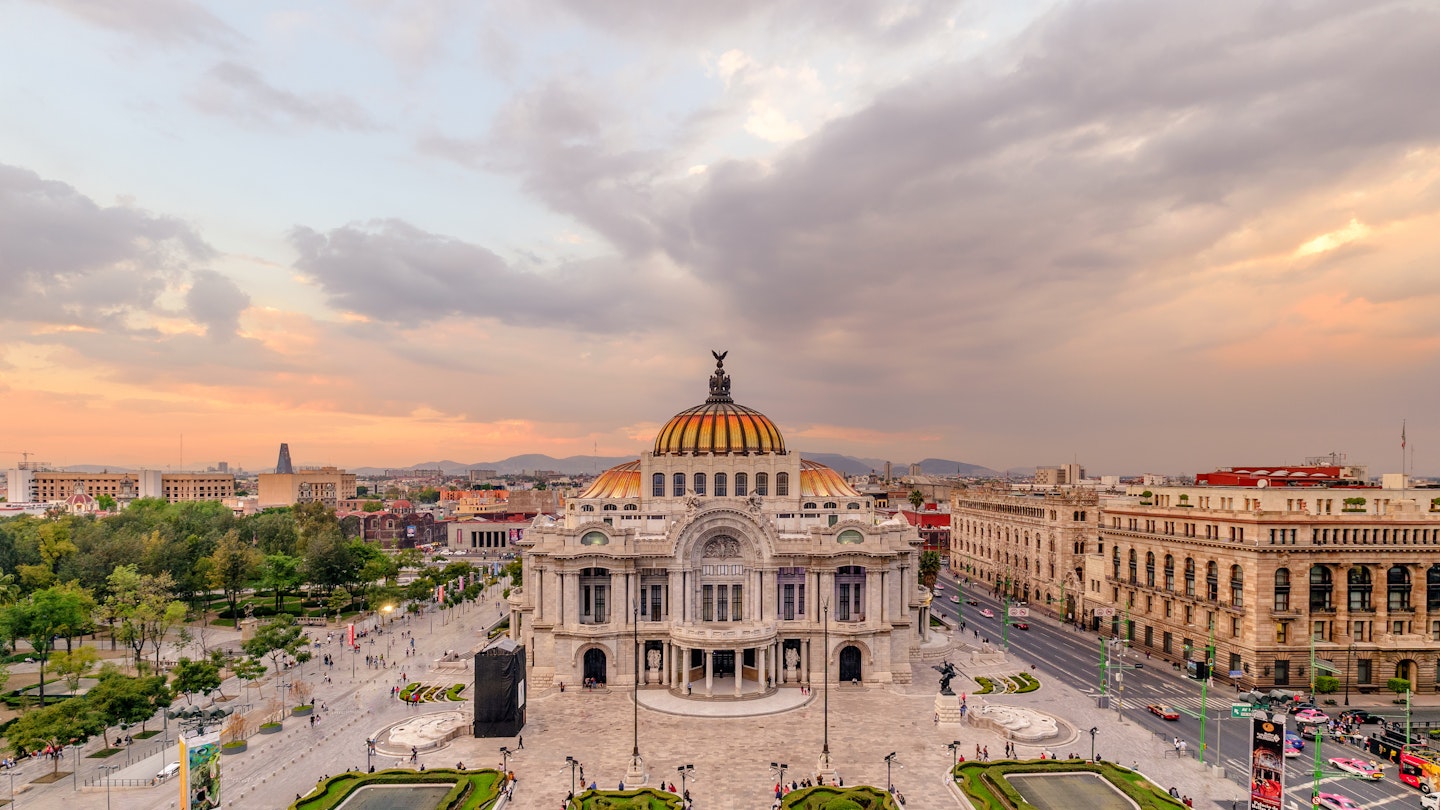
Aerial of Palacio Bellas Artes in Mexico City © Maria Sward
'Is it safe to go to Mexico?' We hear that question constantly, and the answer is always yes, if you know where to go and do your research.
The grisly drug-related murders that make the headlines usually happen far from where the majority of travelers to the country visit, and yet many potential visitors are still avoiding the country.
Before brushing a Mexico trip aside though, consider these favorite places of ours to visit (there are dozens of other candidates), in terms of travel appeal and safety record. None are on the US State Department's warning list.
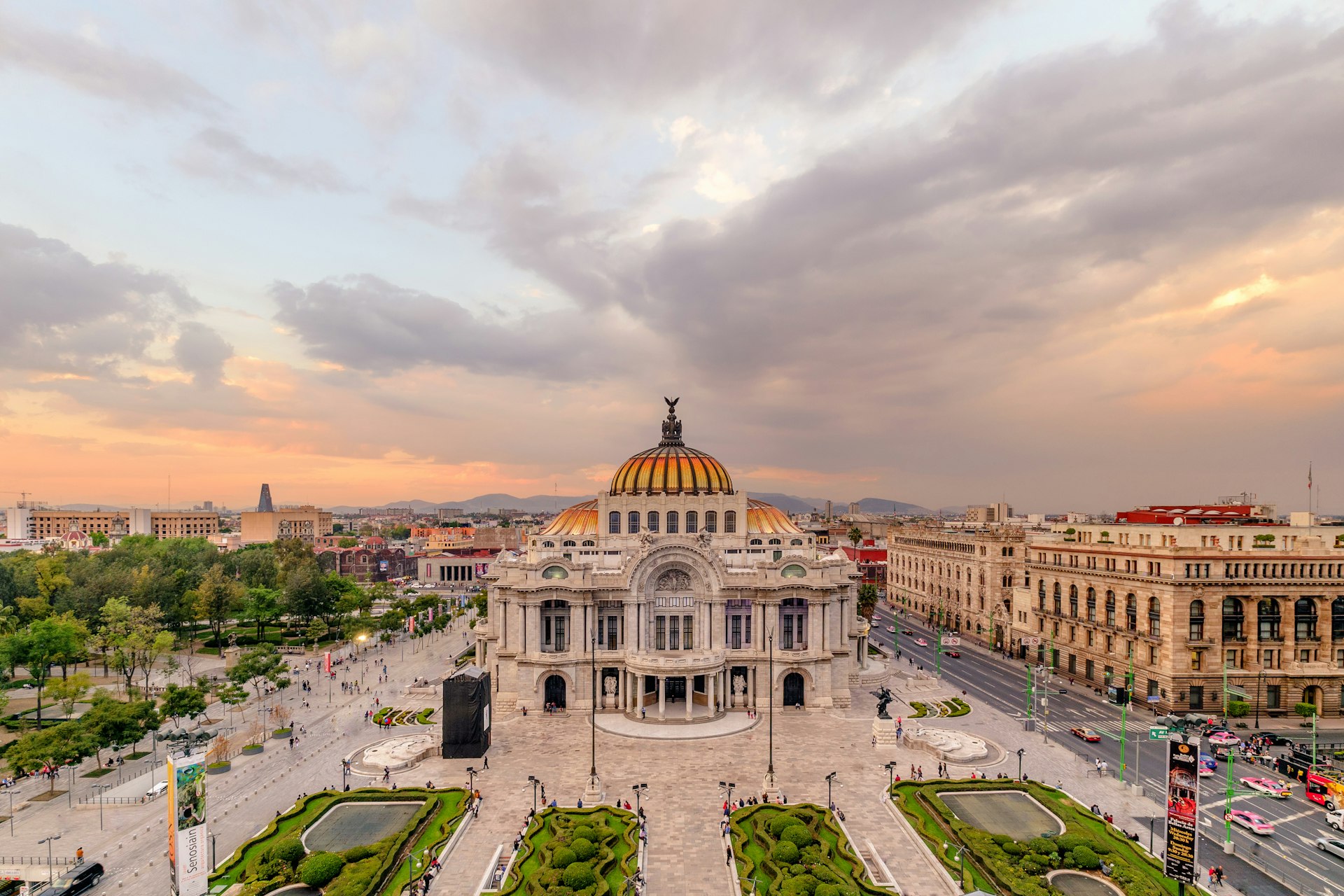
Mexico City
There really is no more fascinating city in the world than Mexico's misunderstood capital. With a population of over 21 million (and a crime rate about a third of Washington, DC's), Mexico City had a serious scrub-up for its bi-centennial, and now some places like mariachi-filled Plaza Garibaldi are considered (like Times Square in New York) safe enough to be a 'Disney version' of its former gritty self. Also, many restored colonial buildings show details long obscured by years of pollution build-up. Meanwhile, this ancient city built over a filled-in lake has Aztec canals, pyramids, Diego Rivera and Frida Kahlo's old studio, and hipster dining in chic eateries of the Condesa and Polanco. That and a million other things.
Expert tip: Enjoy a great night’s sleep, a delicious breakfast and a top-notch location at Condesa Haus . Be sure to check out the original tile floors, the stunning archways, and ask for a peek into the Puebla room to see a bathroom unlike any other.

Merida is gorgeous colonial city about three hours inland from Cancun. The buildings are well-preserved and brightly colored. The city itself is the best place to enjoy amazing Yucatecan foods like cochinita pibil, papadzules, and panuchos. The city is best on weekends, when the historical core – a scene of 17th-century cathedrals made from Mayan bricks – closes to vehicles and fills with open-air stages, taco stands and balloon vendors. For a fun cantina experience, head to La Negrita . There’s live music most nights and as long as you order a few drinks, the free snacks will keep on coming.
Expert tip: Luz en Yucatán is a fine boutique option a few blocks north of the cathedral, with a pool and nicely designed rooms.
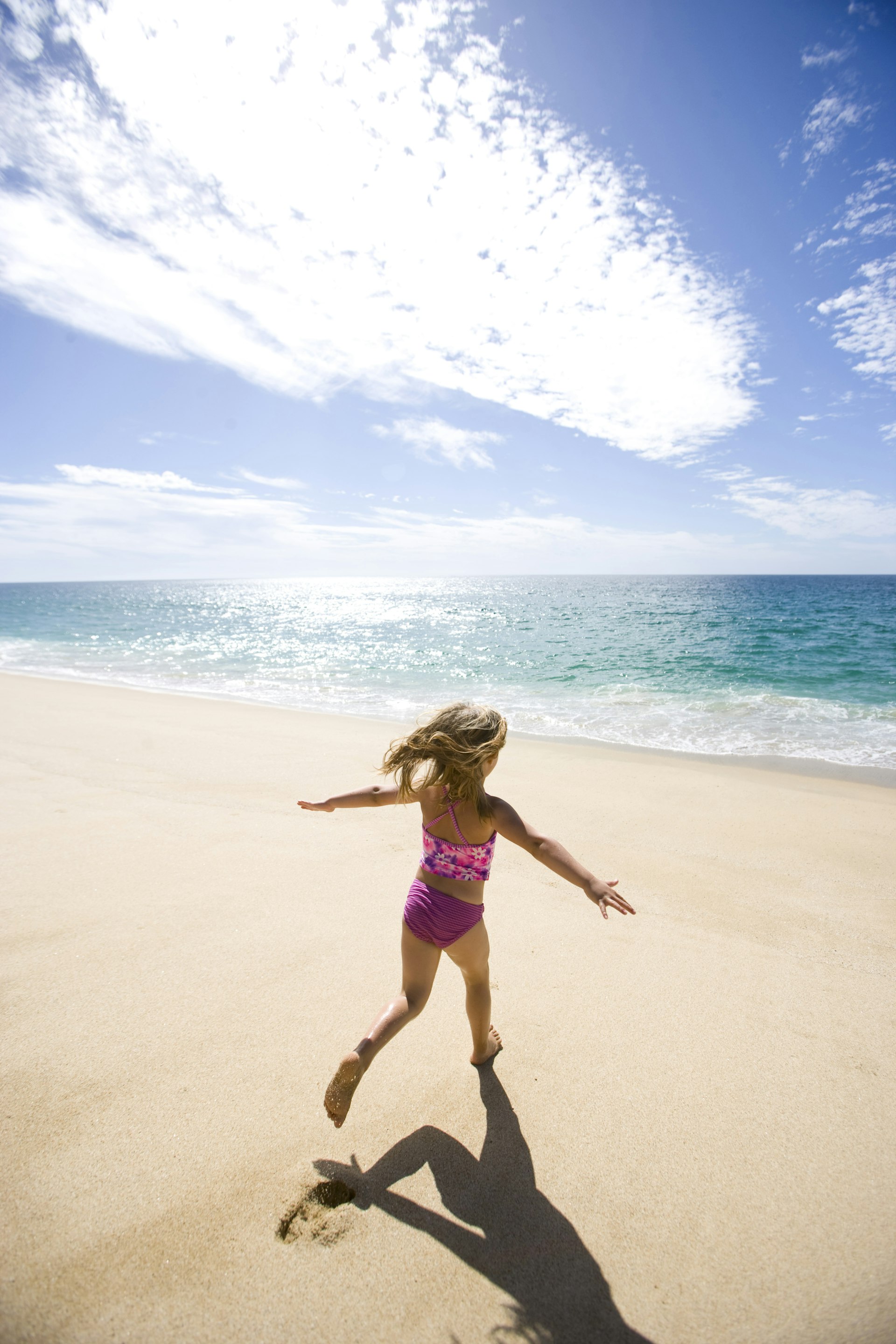
Todos Santos
If you've not been – and most haven't – circle ' Todos Santos ' for the next Baja trip. Sure, some long-timers say it's not what it used to be, as popularity has swelled (and its 'gringo: Mexicano' ratio has evened out), but it still beats the Cabo San Lucas condos for laid-back sense of peace in Baja Sur. A couple of hours from the Cabo or La Paz airports, is a mountain-backed artist community with good surfing beaches. You can easily drive into Sammy Hagar bars and or take a boat trip to Cabo, then return for the quiet at night. Plus the Hotel California here likes to claim it's the Hotel California.
Expert tip: Learn to surf at Mario Surf School . Or if it's just comfort and a rooftop pool you want, boutiquey Guaycura Hotel is a classy option in Todos Santos.
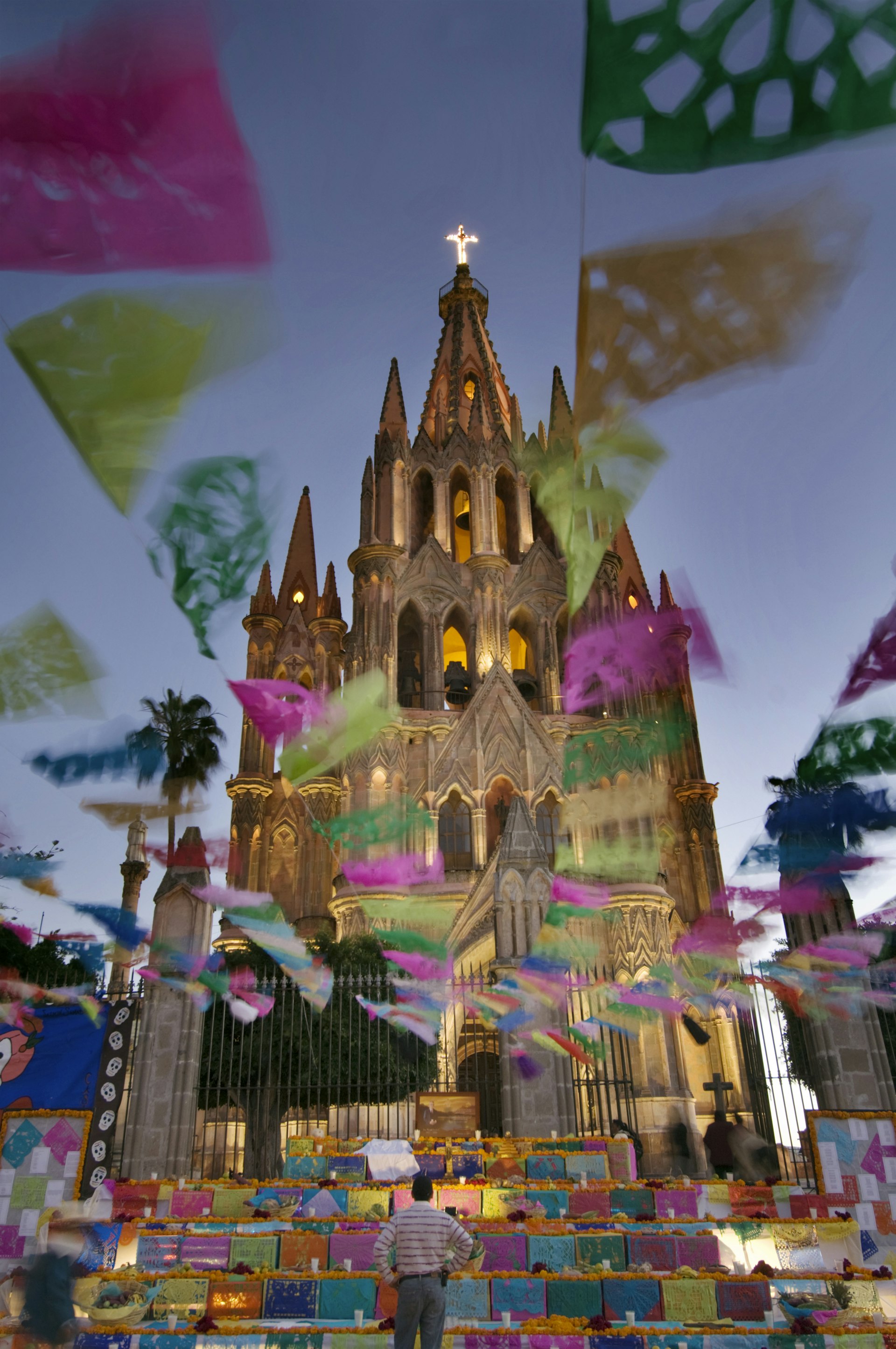
San Miguel de Allende
Yes, it's an obvious choice – and with reason. A bit of an American-expat go-to of the silver towns of the central highlands north of Mexico City (and two hours from the León airport), San Miguel de Allende is a stunner, with any worry of drug violence a distant rumor. The town itself – as seen in Robert Rodriguez's Once Upon a Time in Mexico – is the main attraction. A Unesco World Heritage site since 2008, the town of 62,000 is filled with handicraft shops, 17th-century cathedrals, botanic gardens, organic farmer restaurants and lovely (sometimes luxe) guesthouses.
Expert tip: San Miguel's a good spot to study Spanish or cooking. Set in a colonial building, Academia Hispano Americano is a good choice (and can arrange homestays).

If it's resorts you want, Huatulco is a rare success story in recent resort development. This former fishing village has become the Oaxacan beach resort of choice lately, benefiting from its gentle development plan that keeps much of the 12 miles of sandy shoreline completely unspoiled and the town under six-stories high. Activities can fill several days. Snorkeling, diving, kayaking, surfing, cycling and rafting trips are easy to find, as are tours to waterfalls and coffee farms. There are flights in from Mexico City and Oaxaca City.
Expert tip: The Misión de los Arcos offers comfy rooms, most with balcony, a touch of colonial style, and a warm welcome.
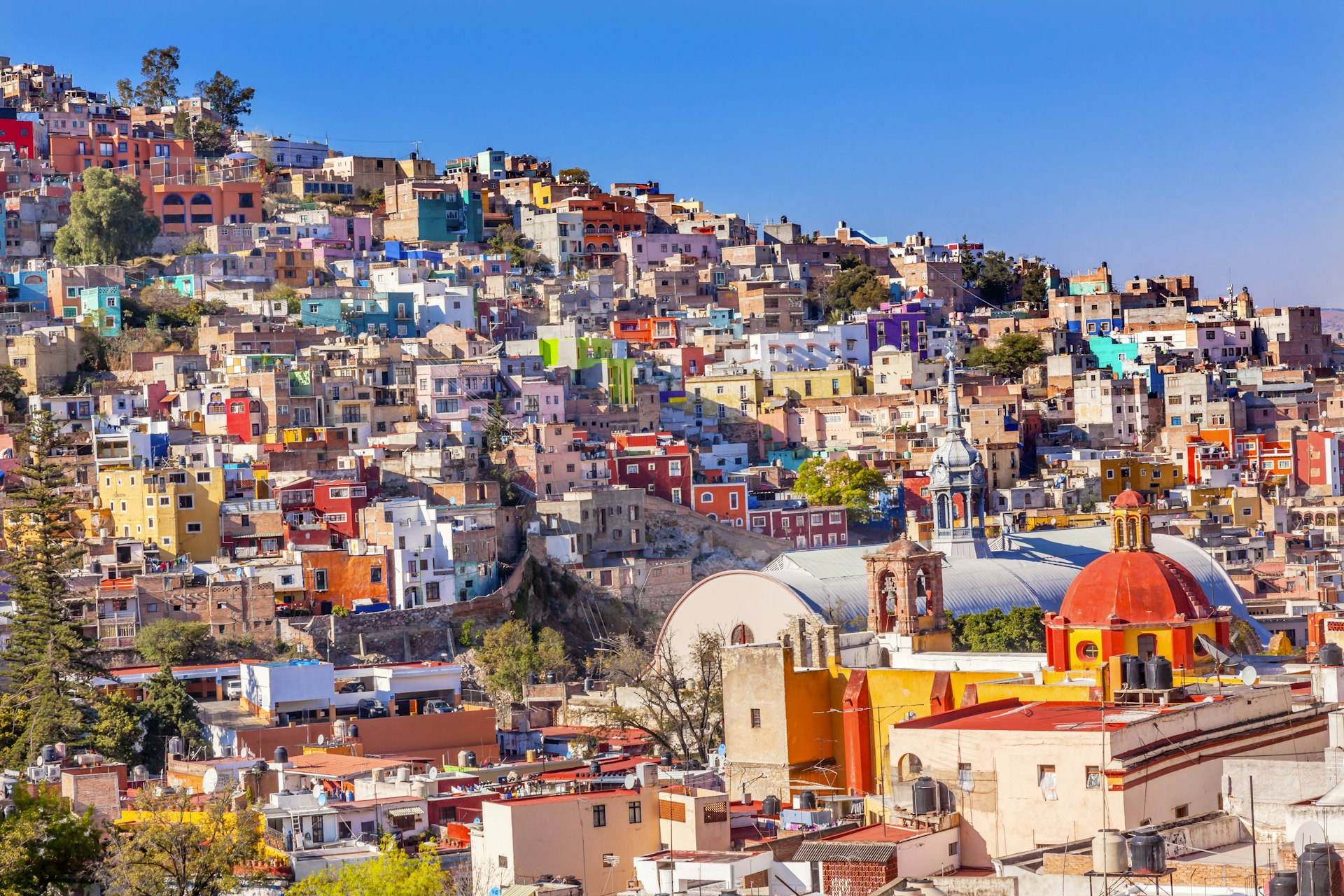
A gorgeous hill town of 16th-century cathedrals and brightly colored homes on plazas lined with laurel trees, Guanajuato is best visited during October's Festival Cervantino – a serious cultural extravaganza with orchestras, ballet folklórico, modern art, mariachis, and Mexico City punk bands. And most of it's free. At any time of year it's a great hub for laid-back colonial life and a look at a mummy museum, plus a visit could easily be combined with nearby San Miguel de Allende. The town's 30 minutes from León's Bajío airport, or five hours by bus from Mexico City.
Expert tip: Several schools offer Spanish classes and homestays, including Escuela Mexicana.

A 'mini Mexico City' – with a mere 1.5 million residents – Puebla is a colonial wonder city, packed with cathedrals and a wonderful museum devoted to ancient artifacts, and is far more manageable and laid-back than its size would suggest. The historic center is the place to stay, with buildings decked in azulejos (painted tiles) and many spots to sample the local taco árabe (Arabic taco), made of marinated pork served on Middle Eastern-style flat bread. The more adventurous should ask for escamoles (rice-like ant larvae sauteed in butter). It's two hours by bus from Mexico City.
Expert tip: When in beautiful Puebla you should stay in a beautiful hotel and there's none better than the Casona de la China Poblana .

There’s a little something for everyone in this sleepy little beach town. It’s known best for the stunning Mayan ruins that hug its coastline, but there’s a lot more to Tulum than this one-day outing. Stay beachside to enjoy a slice of luxury. There are romantic cabanas on the beach and high-end restaurants like Hartwood where people line up hours before dinner service just to get a table. For something more mellow, stay in the town of Tulum where you can take yoga classes, drink freshly pressed orange juice and eat late night street tacos. The best way to get around is by bicycle.
Expert tip: For a unique beachside hotel, check out Be Tulum. They have private villas that back onto the beach and an on-site spa to help you relax even further.

Oaxaca City
Last, but certainly not least, Oaxaca is a quiet little city has recently made an international name for itself as the foodie capital of Mexico. It’s home to some of the best mezcal in the country and there is also a ton of culture to explore in the surrounding state. You could easily spend a week exploring the markets, eating mole at different restaurants, and soaking in the history at nearby archaeological sites like Mitla and Monte Alban . Don’t miss out on a tour of the Ethnobotanical Gardens , it’s only offered in English twice a week, but it’s totally worth waiting for.
Expert tip : For a nice boutique hotel in the center of all of the action that doesn’t break the bank, check out Casa Azul. Each room was designed by a popular Mexican artist.
Article updated September 2019.
Explore related stories

May 14, 2024 • 6 min read
With grand architecture, colorful markets and free galleries – not to mention affordable accommodation and food – Oaxaca is budget travel at its best.

Mar 26, 2024 • 8 min read

Mar 21, 2024 • 6 min read

Feb 19, 2024 • 7 min read

Feb 12, 2024 • 10 min read

Feb 7, 2024 • 5 min read

Feb 1, 2024 • 7 min read
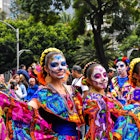
Oct 30, 2023 • 6 min read

Oct 19, 2023 • 5 min read
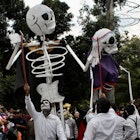
Security Alert May 17, 2024
Worldwide caution, update may 10, 2024, information for u.s. citizens in the middle east.
- Travel Advisories |
- Contact Us |
- MyTravelGov |
Find U.S. Embassies & Consulates
Travel.state.gov, congressional liaison, special issuance agency, u.s. passports, international travel, intercountry adoption, international parental child abduction, records and authentications, popular links, travel advisories, mytravelgov, stay connected, legal resources, legal information, info for u.s. law enforcement, replace or certify documents.
Share this page:
Mexico Travel Advisory
Travel advisory august 22, 2023, mexico - see state summaries.
Reissued after periodic review with general security updates, and the removal of obsolete COVID-19 page links.
Country Summary: Violent crime – such as homicide, kidnapping, carjacking, and robbery – is widespread and common in Mexico. The U.S. government has limited ability to provide emergency services to U.S. citizens in many areas of Mexico, as travel by U.S. government employees to certain areas is prohibited or restricted. In many states, local emergency services are limited outside the state capital or major cities.
U.S. citizens are advised to adhere to restrictions on U.S. government employee travel. State-specific restrictions are included in the individual state advisories below. U.S. government employees may not travel between cities after dark, may not hail taxis on the street, and must rely on dispatched vehicles, including app-based services like Uber, and regulated taxi stands. U.S. government employees should avoid traveling alone, especially in remote areas. U.S. government employees may not drive from the U.S.-Mexico border to or from the interior parts of Mexico, except daytime travel within Baja California and between Nogales and Hermosillo on Mexican Federal Highway 15D, and between Nuevo Laredo and Monterrey on Highway 85D.
Read the country information page for additional information on travel to Mexico.
Do Not Travel To:
- Colima state due to crime and kidnapping .
- Guerrero state due to crime .
- Michoacan state due to crime and kidnapping .
- Sinaloa state due to crime and kidnapping
- Tamaulipas state due to crime and kidnapping.
- Zacatecas state due to crime and kidnapping .
Reconsider Travel To:
- Baja California state due to crime and kidnapping .
- Chihuahua state due to crime and kidnapping .
- Durango state due to crime .
- Guanajuato state due to crime and kidnapping .
- Jalisco state due to crime and kidnapping .
- Morelos state due to crime .
- Sonora state due to crime and kidnapping .
Exercise Increased Caution When Traveling To:
- Aguascalientes state due to crime .
- Baja California Sur state due to crime .
- Chiapas state due to crime .
- Coahuila state due to crime .
- Hidalgo state due to crime .
- Mexico City due to crime .
- Mexico State due to crime .
- Nayarit state due to crime.
- Nuevo Leon state due to crime and kidnapping .
- Oaxaca state due to crime .
- Puebla state due to crime and kidnapping .
- Queretaro state due to crime .
- Quintana Roo state due to crime .
- San Luis Potosi state due to crime and kidnapping .
- Tabasco state due to crime .
- Tlaxcala state due to crime .
- Veracruz state due to crime .
Exercise Normal Precautions When Traveling To:
- Campeche state
- Yucatan state
Visit our website for Travel to High-Risk Areas .
If you decide to travel to Mexico:
- Keep traveling companions and family back home informed of your travel plans. If separating from your travel group, send a friend your GPS location. If taking a taxi alone, take a photo of the taxi number and/or license plate and text it to a friend.
- Use toll roads when possible and avoid driving alone or at night. In many states, police presence and emergency services are extremely limited outside the state capital or major cities.
- Exercise increased caution when visiting local bars, nightclubs, and casinos.
- Do not display signs of wealth, such as wearing expensive watches or jewelry.
- Be extra vigilant when visiting banks or ATMs.
- Enroll in the Smart Traveler Enrollment Program (STEP) to receive Alerts and make it easier to locate you in an emergency.
- Follow the Department of State on Facebook and Twitter .
- Follow the U.S. Embassy on Facebook and Twitter .
- Review the Country Security Report for Mexico.
- Mariners planning travel to Mexico should check for U.S. maritime advisories and alerts , which include instructions on reporting suspicious activities and attacks to Mexican naval authorities.
- Prepare a contingency plan for emergency situations. Review the Traveler’s Checklist .
- Visit the CDC page for the latest travel health information related to your travel.
Aguascalientes state – Exercise Increased Caution
Exercise increased caution due to crime.
Criminal activity and violence may occur throughout the state.
There are no restrictions on travel for U.S. government employees in Aguascalientes state.
Baja California state – Reconsider Travel
Reconsider travel due to crime and kidnapping.
Transnational criminal organizations compete in the border area to establish narco-trafficking and human smuggling routes. Violent crime and gang activity are common. Travelers should remain on main highways and avoid remote locations. Of particular concern is the high number of homicides in the non-tourist areas of Tijuana. Most homicides appeared to be targeted; however, criminal organization assassinations and territorial disputes can result in bystanders being injured or killed. U.S. citizens and LPRs have been victims of kidnapping.
U.S. government employees must adhere to the noted restrictions:
- Mexicali Valley: U.S. government employees should avoid the Mexicali Valley due to the heightened possibility of violence between rival cartel factions. The boundaries of the restricted area are: to the east, the Baja California/Arizona and Baja California/Sonora borders; to the south, from La Ventana (on Highway 5) due east to the Colorado River; to the west, Highway 5; and to the north, Boulevard Lazaro Cardenas/Highway 92/Highway 1 to Carretera Aeropuerto, from the intersection of Highway 1 and Carretera Aeropuerto due north to the Baja California/California border, and from that point eastward along the Baja California/California border.
- Travelers may use Highways 2 and 2D to transit between Mexicali, Los Algodones, and San Luis Rio Colorado during daylight hours. Travelers may also use Highways 1 and 8 to transit to and from the Mexicali Airport during daylight hours. Travel on Highway 5 is permissible during daylight hours.
There are no other travel restrictions for U.S. government employees in Baja California state. These include high-traffic tourism areas of border and coastal communities, such as Tijuana , Ensenada , and Rosarito .
Baja California Sur state – Exercise Increased Caution
There are no restrictions on travel for U.S. government employees in Baja California Sur state.
Campeche state – Exercise Normal Precautions
Exercise normal precautions.
There are no restrictions on travel for U.S. government employees in Campeche state.
Chiapas state – Exercise Increased Caution
There are no restrictions on travel for U.S. government employees in Chiapas state.
Chihuahua state – Reconsider Travel
Violent crime and gang activity are common. Most homicides are targeted assassinations against members of criminal organizations. Battles for territory between criminal groups have resulted in violent crime in areas frequented by U.S. citizens and U.S. government employees, including restaurants and malls during daylight hours. Bystanders have been injured or killed in shooting incidents. U.S. citizens and LPRs have been victims of kidnapping.
U.S. government employee travel is limited to the following areas with the noted restrictions:
- Ciudad Juarez: U.S. government employees may travel to the area of Ciudad Juarez bounded to the east by Bulevar Independencia; to the south by De los Montes Urales/Avenida Manuel J Clouthier/Carretera de Juárez; to the west by Via Juan Gabriel/Avenida de los Insurgentes/Calle Miguel Ahumada/Francisco Javier Mina/Melchor Ocampo; and to the north by the U.S.-Mexico border. Direct travel to the Ciudad Juarez airport (officially called the Abraham González International Airport) and the factories located along Bulevar Independencia and Las Torres is permitted. Travel to San Jerónimo is permitted only through the United States via the Santa Teresa U.S. Port of Entry; travel via Anapra is prohibited.
U.S. government employees may only travel from Ciudad Juarez to the city of Chihuahua during daylight hours via Federal Highway 45, with stops permitted only at the Guardia Nacional División Caminos station, the Umbral del Milenio overlook area, the border inspection station at KM 35, and the shops and restaurants on Federal Highway 45 in the city of Ahumada.
- U.S. government employees may travel between Ciudad Juarez and Ascension via Highway 2.
- Nuevo Casas Grandes Area (including Nuevo Casas Grandes, Casas Grandes, Mata Ortiz, Colonia Juárez, Colonia LeBaron, Paquimé and San Buenaventura): U.S. government employees may travel to the Nuevo Casas Grandes area during daylight hours via Mexico Federal Highway 2, and subsequently Federal Highway 10, to Nuevo Casas Grandes. Employees are permitted to stay overnight in the cities of Nuevo Casas Grandes and Casas Grandes only.
- City of Chihuahua: U.S. government employees may travel at any time to the area of the city of Chihuahua bounded to the north by Avenida Transformación; to the east by Avenida Tecnológico/Manuel Gómez Morín/Highway 16/Blvd.José Fuentes Mares; to the west by the city boundary; and to the south by Periférico Francisco R. Almada.
- U.S. government employees may travel on Highways 45, 16, and 45D through the city of Chihuahua and to the Chihuahua airport (officially called the General Roberto Fierro Villalobos International Airport).
- U.S. government employees may travel to Santa Eulalia to the east of the city of Chihuahua, as well as to Juan Aldama via Highway 16 to the northeast.
- U.S. government employees may travel south of the city of Chihuahua on Highway 45 to the southern boundary of Parral, including each town directly connected to Highway 45, including Lázaro Cárdenas, Pedro Meoqui, Santa Cruz de Rosales, Delicias, Camargo, Ciudad Jiménez, and Parral itself.
- U.S. government employees may only travel on official business from the city of Chihuahua on Highway 16 to Ciudad Cuauhtémoc bounded by Highway 21 to the north and east, Highway 5 to the west, and Bulevar Jorge Castillo Cabrera to the south.
- Ojinaga: U.S. government employees must travel to Ojinaga via U.S. Highway 67 and enter through the U.S. Port of Entry in Presidio, Texas.
- Palomas: U.S. government employees may travel to Palomas via U.S. highways through the U.S. Port of Entry in Columbus, New Mexico, or via Highway 2 in Mexico.
U.S. government employees may not travel to other areas of Chihuahua, including Copper Canyon .
Coahuila state – Exercise Increased Caution
Violent crime and gang activity occur in parts of Coahuila state.
U.S. government employees must adhere to the following travel restrictions:
- Zaragoza, Morelos, Allende, Nava, Jimenez, Villa Union, Guerrero, and Hidalgo municipalities : U.S. government employees may not travel to these municipalities.
- Piedras Negras and Ciudad Acuña: U.S. government employees must travel directly from the United States and observe a curfew from midnight to 6:00 a.m. in both cities.
There are no other restrictions on travel for U.S. government employees in Coahuila state.
Colima state – Do Not Travel
Do not travel due to crime and kidnapping.
Violent crime and gang activity are widespread. Most homicides are targeted assassinations against members of criminal organizations. Shooting incidents between criminal groups have injured or killed bystanders. U.S. citizens and LPRs have been victims of kidnapping.
Travel for U.S. government employees is limited to the following areas with noted restrictions:
- Manzanillo: U.S. government employee travel is limited to the tourist and port areas of Manzanillo.
- Employees traveling to Manzanillo from Guadalajara must use Federal Toll Road 54D during daylight hours.
U.S. government employees may not travel to other areas of Colima state.
Durango state – Reconsider Travel
Reconsider travel due to crime.
Violent crime and gang activity are common in parts of Durango state.
- West and south of Federal Highway 45: U.S. government employees may not travel to this region of Durango state.
There are no other restrictions on travel for U.S. government employees in Durango state.
Guanajuato state – Reconsider Travel
Gang violence, often associated with the theft of petroleum and natural gas from the state oil company and other suppliers, occurs in Guanajuato, primarily in the south and central areas of the state. Of particular concern is the high number of murders in the southern region of the state associated with cartel-related violence. U.S. citizens and LPRs have been victims of kidnapping.
- Areas south of Federal Highway 45D: U.S. government employees may not travel to the area south of and including Federal Highway 45D, Celaya, Salamanca, and Irapuato.
There are no other restrictions on travel for U.S. government employees in Guanajuato state, which includes tourist areas in: San Miguel de Allende , Guanajuato City , and surrounding areas.
Guerrero state – Do Not Travel
Do not travel due to crime.
Crime and violence are widespread. Armed groups operate independently of the government in many areas of Guerrero. Members of these groups frequently maintain roadblocks and may use violence towards travelers. U.S. citizens and LPRs have been victims of kidnapping in previous years.
Travel for U.S. government employees is limited to the following area with the noted restrictions:
- Taxco: U.S. government employees must use Federal Highway 95D, which passes through Cuernavaca, Morelos, and stay within downtown tourist areas of Taxco. Employees may visit Grutas de Cacahuamilpa National Park during the day with a licensed tour operator.
U.S. government employees may not travel to other areas of the state of Guerrero, including to tourist areas in Acapulco , Zihuatanejo , and Ixtapa .
Hidalgo state – Exercise Increased Caution
There are no restrictions on travel for U.S. government employees in Hidalgo state.
Jalisco state – Reconsider Travel
Violent crime and gang activity are common in parts of Jalisco state. In Guadalajara, territorial battles between criminal groups take place in tourist areas. Shooting incidents between criminal groups have injured or killed innocent bystanders. U.S. citizens and LPRs have been victims of kidnapping.
- Jalisco-Michoacan border and Federal Highway 110: U.S. government employees may not travel to the area between Federal Highway 110 and the Jalisco-Michoacan border, nor travel on Federal Highway 110 between Tuxpan, Jalisco, and the Michoacan border.
- Federal Highway 80: U.S. government employees may not travel on Federal Highway 80 south of Cocula.
There are no other restrictions on travel for U.S government employees in Jalisco state which includes tourist areas in: Guadalajara Metropolitan Area , Puerto Vallarta (including neighboring Riviera Nayarit) , Chapala , and Ajijic .
Mexico City (Ciudad de Mexico) – Exercise Increased Caution
Both violent and non-violent crime occur throughout Mexico City. Use additional caution, particularly at night, outside of the frequented tourist areas where police and security patrol more routinely. Petty crime occurs frequently in both tourist and non-tourist areas.
There are no restrictions on travel for U.S. government employees in Mexico City.
Mexico State (Estado de Mexico) – Exercise Increased Caution
Both violent and non-violent crime occur throughout Mexico State. Use additional caution in areas outside of the frequented tourist areas, although petty crime occurs frequently in tourist areas as well.
There are no restrictions on travel for U.S. government employees in Mexico State.
Michoacan state – Do Not Travel
Do not travel due to crime and kidnapping.
Crime and violence are widespread in Michoacan state. U.S. citizens and LPRs have been victims of kidnapping.
Travel for U.S. government employees is limited to the following areas with the noted restrictions:
- Federal Highway 15D: U.S. government employees may travel on Federal Highway 15D to transit the state between Mexico City and Guadalajara.
- Morelia: U.S. government employees may travel by air and by land using Federal Highways 43 or 48D from Federal Highway 15D.
- Lazaro Cardenas: U.S. government employees must travel by air only and limit activities to the city center or port areas.
U.S. government employees may not travel to other areas of the state of Michoacan, including the portions of the Monarch Butterfly Reserve located in Michoacan.
Morelos state – Reconsider Travel
Violent crime and gang activity are common in parts of Morelos state.
There are no restrictions on travel for U.S. government employees in Morelos state.
Nayarit state – Exercise Increased Caution
Criminal activity and violence may occur throughout Nayarit state.
There are no restrictions on travel for U.S government employees in Nayarit state.
Nuevo Leon state – Exercise Increased Caution
Exercise increased caution due to crime and kidnapping.
Criminal activity and violence may occur throughout the state. U.S. citizens and LPRs have been victims of kidnapping.
There are no restrictions on travel for U.S. government employees in Nuevo Leon state.
Oaxaca state – Exercise Increased Caution
Criminal activity and violence occur throughout the state.
U.S. travelers are reminded that U.S. government employees must adhere to the following travel restrictions:
- Isthmus region: U.S. government employees may not travel to the area of Oaxaca bounded by Federal Highway 185D to the west, Federal Highway 190 to the north, and the Oaxaca-Chiapas border to the east. This includes the cities of Juchitan de Zaragoza, Salina Cruz, and San Blas Atempa.
- Federal Highway 200 northwest of Pinotepa: U.S. government employees may not use Federal Highway 200 between Pinotepa and the Oaxaca-Guerrero border.
There are no restrictions on travel for U.S. government employees to other parts of Oaxaca state, which include tourist areas in: Oaxaca City , Monte Alban , Puerto Escondido, and Huatulco .
Puebla state – Exercise Increased Caution
There are no restrictions on travel for U.S. government employees in Puebla state.
Queretaro state – Exercise Increased Caution
There are no restrictions on travel for U.S. government employees in Queretaro state.
Quintana Roo state – Exercise Increased Caution
Criminal activity and violence may occur in any location, at any time, including in popular tourist destinations. Travelers should maintain a high level of situational awareness, avoid areas where illicit activities occur, and promptly depart from potentially dangerous situations.
While not directed at tourists, shootings between rival gangs have injured innocent bystanders. Additionally, U.S. citizens have been the victims of both non-violent and violent crimes in tourist and non-tourist areas.
There are no restrictions on travel for U.S. government employees in Quintana Roo state. However, personnel are advised to exercise increased situational awareness after dark in downtown areas of Cancun, Tulum, and Playa del Carmen, and to remain in well-lit pedestrian streets and tourist zones.
San Luis Potosi state – Exercise Increased Caution
Criminal activity and violence may occur throughout the state. U.S. citizens and LPRs have been victims of kidnapping.
There are no restrictions on travel for U.S. government employees in San Luis Potosi state.
Sinaloa state – Do Not Travel
Violent crime is widespread. Criminal organizations are based in and operating in Sinaloa. U.S. citizens and LPRs have been victims of kidnapping.
- Mazatlan: U.S. government employees may travel to Mazatlan by air or sea only, are limited to the Zona Dorada and historic town center, and must travel via direct routes between these destinations and the airport and sea terminal.
- Los Mochis and Topolobampo: U.S. government employees may travel to Los Mochis and Topolobampo by air or sea only, are restricted to the city and the port, and must travel via direct routes between these destinations and the airport.
U.S. government employees may not travel to other areas of Sinaloa state.
Sonora state – Reconsider Travel
Sonora is a key location used by the international drug trade and human trafficking networks. Violent crime is widespread. U.S. citizens and LPRs have been victims of kidnapping. Travelers should maintain a heightened level of awareness of their surroundings in all their travels in Sonora. Security incidents may occur in any area of Sonora.
- Travel between Hermosillo and Nogales: U.S. government employees may travel between the U.S. Ports of Entry in Nogales and Hermosillo during daylight hours via Federal Highway 15 only. U.S. government employees may not use ANY taxi services, public buses, nor ride-share applications due to a lack of secure vetting and/or dispatching procedures. Travelers should exercise caution and avoid unnecessary stops as security incidents, including sporadic, armed carjackings, and shootings have been reported along this highway during daylight hours. Travelers should have a full tank of gas and inform friends or family members of their planned travel.
- Nogales: U.S. government employees may not travel in the triangular area north of Avenida Tecnologico, west of Bulevar Luis Donaldo Colosio (Periferico), nor east of Federal Highway 15D (Corredor Fiscal). U.S. government employees also may not travel in the residential and business areas to east of the railroad tracks along Plutarco Elias Calle (HWY 15) and Calle Ruiz Cortino, including the business area around the Morley pedestrian gate port-of-entry. U.S. government employees may not use ANY taxi services, public buses, nor ride-share applications in Nogales due to a lack of secure vetting and/or dispatching procedures and the danger of kidnapping and other violent crimes.
- Puerto Peñasco: U.S. government employees may travel between Puerto Peñasco and the Lukeville-Sonoyta U.S. Port of Entry during daylight hours via Federal Highway 8 only. They may not travel on any other route to Puerto Peñasco. U.S. government employees may not use ANY taxi services, public buses, nor ride-share applications in Puerto Peñasco. due to a lack of secure vetting and/or dispatching procedures and the danger of kidnapping and other violent crimes.
- Triangular region near Mariposa U.S. Port of Entry: U.S. government employees may not travel into or through the triangular region west of the Mariposa U.S. Port of Entry, east of Sonoyta, and north of Altar municipality.
- San Luis Rio Colorado, Cananea, and Agua Prieta : U.S. government employees may travel directly from the nearest U.S. Port of Entry to San Luis Rio Colorado, Cananea (via Douglas Port of Entry), and Agua Prieta, but may not go beyond the city limits. Travel is limited to daylight hours only. Travel between Nogales and Cananea via Imuris is not permitted. U.S. government employees may not use ANY taxi services, public buses, nor ride-share applications in these cities due to a lack of secure vetting and/or dispatching procedures and the danger of kidnapping and other violent crimes.
- Eastern and southern Sonora (including San Carlos Nuevo Guaymas and Alamos): U.S. government employees may not travel to areas of Sonora east of Federal Highway 17, the road between Moctezuma and Sahuaripa, and State Highway 20 between Sahuaripa and the intersection with Federal Highway 16. U.S. government employees may travel to San Carlos Nuevo Guaymas and Alamos; travel to Alamos is only permitted by air and within city limits. U.S. government employees may not travel to areas of Sonora south of Federal Highway 16 and east of Federal Highway 15 (south of Hermosillo), as well as all points south of Guaymas, including Empalme, Guaymas, Obregon, and Navojoa. U.S. government employees may not use ANY taxi services, public buses, nor ride-share applications in these areas due to a lack of secure vetting and/or dispatching procedures and the danger of kidnapping and other violent crimes.
U.S. government employees may travel to other parts of Sonora state in compliance with the above restrictions, including tourist areas in: Hermosillo , Bahia de Kino , and Puerto Penasco .
Tabasco state – Exercise Increased Caution
There are no restrictions on travel for U.S. government employees in Tabasco state.
Tamaulipas state – Do Not Travel
Organized crime activity – including gun battles, murder, armed robbery, carjacking, kidnapping, forced disappearances, extortion, and sexual assault – is common along the northern border and in Ciudad Victoria. Criminal groups target public and private passenger buses, as well as private automobiles traveling through Tamaulipas, often taking passengers and demanding ransom payments.
Heavily armed members of criminal groups often patrol areas of the state and operate with impunity particularly along the border region from Reynosa to Nuevo Laredo. In these areas, local law enforcement has limited capacity to respond to incidents of crime. Law enforcement capacity is greater in the tri-city area of Tampico, Ciudad Madero, and Altamira, which has a lower rate of violent criminal activity compared to the rest of the state.
U.S. citizens and LPRs have been victims of kidnapping.
- Matamoros and Nuevo Laredo: U.S. government employees may only travel within a limited radius around and between the U.S. Consulates in Nuevo Laredo and Matamoros, their homes, the respective U.S. Ports of Entry, and limited downtown sites, subject to an overnight curfew.
- Overland travel in Tamaulipas: U.S. government employees may not travel between cities in Tamaulipas using interior Mexican highways. Travel between Nuevo Laredo and Monterrey is limited to Federal Highway 85D during daylight hours with prior authorization.
U.S. government employees may not travel to other parts of Tamaulipas state.
Tlaxcala state – Exercise Increased Caution
There are no restrictions on travel for U.S. government employees in Tlaxcala state.
Veracruz state – Exercise Increased Caution
Violent crime and gang activity occur with increasing frequency in Veracruz, particularly in the center and south near Cordoba and Coatzacoalcos. While most gang-related violence is targeted, violence perpetrated by criminal organizations can affect bystanders. Impromptu roadblocks requiring payment to pass are common.
There are no restrictions on travel for U.S. government employees in Veracruz state.
Yucatan state – Exercise Normal Precautions
There are no restrictions on travel for U.S. government employees in Yucatan state, which include tourist areas in: Chichen Itza , Merida , Uxmal , and Valladolid .
Zacatecas state – Do Not Travel
Violent crime, extortion, and gang activity are widespread in Zacatecas state. U.S. citizens and LPRs have been victims of kidnapping.
- Zacatecas City : U.S. government employee travel is limited to Zacatecas City proper, and employees may not travel overland to Zacatecas City.
- U.S. government employees may not travel to other areas of Zacatecas state.
Travel Advisory Levels
Assistance for u.s. citizens, search for travel advisories, external link.
You are about to leave travel.state.gov for an external website that is not maintained by the U.S. Department of State.
Links to external websites are provided as a convenience and should not be construed as an endorsement by the U.S. Department of State of the views or products contained therein. If you wish to remain on travel.state.gov, click the "cancel" message.
You are about to visit:
Places the U.S. Government Warns Not to Travel Right Now
You may want to reconsider traveling to these countries right now.
Do Not Travel to These Countries

Getty Images
Crime, civil unrest and terrorism are common risk factors for countries that end up on the State Department's "Do Not Travel" advisory list.
In 2024, tourism across the globe is “well on track” to return to pre-pandemic levels, according to projections by UN Tourism.
Global conflicts and natural disasters , ranging from a series of coups across Africa to catastrophic earthquakes in the Middle East affected international travel patterns throughout 2023. Still, international tourist arrivals reached 87% of pre-pandemic levels in 2023, according to estimates by UN Tourism .
In January 2024 alone, about 4.6 million U.S. citizens left the country for international destinations, 17% higher than the same month in 2019, according to the International Trade Administration . But some destinations warrant more caution than others.
On Oct. 19, 2023, following the outbreak of war between Israel and Gaza and flaring tensions in the region, the U.S. State Department issued a worldwide caution advisory due to “increased tensions in various locations around the world, the potential for terrorist attacks, demonstrations or violent actions against U.S. citizens and interests.” Prior to this update, the most recent worldwide caution advisory was issued in 2022 after a U.S. strike killed Ayman al-Zawahiri, Osama bin Laden’s successor as leader of Al Qaeda, causing “a higher potential for anti-American violence.” The worldwide caution advisory remains in effect.
The U.S. State Department also issues individual travel advisory levels for more than 200 countries globally, continually updating them based on a variety of risk indicators such as health, terrorism and civil unrest. Travel advisory levels range from Level 1, which means exercise normal precautions, to Level 4, which means do not travel there.
About 10% of countries – 19 total – have a Level 4: “Do Not Travel” advisory as of Mar. 4. In Level 4 countries, the U.S. government may have “very limited ability” to step in should travelers’ safety or security be at risk, according to the State Department. Crime, civil unrest, kidnapping and terrorism are common risk factors associated with Level 4 countries.
So far in 2024, the State Department made changes to the existing Level 4 advisories for Myanmar, Iran and Gaza, and moved Niger and Lebanon off of the Level 4 list.
Places With a Level 4 Travel Advisory
These are the primary areas the U.S. government says not to travel to right now, in alphabetical order:
Jump to Place: Afghanistan Belarus Burkina Faso Central African Republic Myanmar (formerly Burma) Gaza Haiti Iran Iraq Libya Mali Mexico North Korea (Democratic People's Republic of Korea) Russia Somalia South Sudan Sudan Syria Ukraine Venezuela Yemen
Afghanistan: The Central Asian country is wrestling with “terrorism, risk of wrongful detention, kidnapping and crime,” according to the State Department. U.S. citizens are specifically at risk for wrongful detention and kidnapping. In 2022, the government reinstituted public floggings and executions, and women’s rights are disappearing under Taliban control. The U.S. Embassy in Kabul halted operations in August 2021. Since the Taliban took control , many forms of international aid have been halted . Meanwhile, in 2023, some of the year’s deadliest earthquakes killed more than 2,400 in Afghanistan while the country continues to face a years-long extreme drought.
Belarus: Belarus, which shares a western border with Russia and a southern border with Ukraine, has been flagged for “Belarusian authorities’ continued facilitation of Russia’s war against Ukraine, the buildup of Russian military forces in Belarus, the arbitrary enforcement of local laws, the potential of civil unrest, the risk of detention, and the Embassy’s limited ability to assist U.S. citizens residing in or traveling to Belarus.” The U.S. Embassy in Minsk halted operations in February 2022.
Burkina Faso: Terrorism, crime and kidnapping are plaguing this West African nation. Terrorist attacks may target hotels, restaurants and schools with little to no warning, and the East and Sahel regions of the country are under a state of emergency. In late November 2023, hundreds died in clashes between state security forces and rebels near the country’s border with Mali. In June, more than 2 million people in Burkina Faso were displaced due to “violence linked to al-Qaida and the Islamic State group.”
Central African Republic: While there have not been specific incidents of U.S. citizens targeted with violence or crime, violent crime and sudden closure of roads and borders is common. The advisory states that “Embassy Bangui’s limited capacity to provide support to U.S. citizens, crime, civil unrest, and kidnapping” is a factor in its assessment. Recent data from UNICEF suggests the country has the worst drinking water accessibility of all countries in 2022.
Myanmar (Formerly Burma): Armed conflict and civil unrest are the primary reasons to not travel to this Southeast Asian country, which experienced a military coup in early 2021. Limited health care resources, wrongful detentions and “areas with land mines and unexploded ordnance” are also listed as risk factors. After Ukraine and Israel, Myanmar had the highest conflict-related death toll in 2023.
Gaza : Hamas, a foreign terrorist organization as designated by the State Department, controls much of the Gaza Strip, which shares borders with both Israel and Egypt. On Oct. 7, 2023, Hamas fighters broke across the border into Israel, killing hundreds of civilians and soldiers in a brazen attack that stunned Israelis. On Oct. 10, Israel hit the Gaza Strip with “the fiercest air strikes in its 75-year conflict” according to Reuters . The conflict has since escalated into war between Israel and Hamas, with regular Israeli airstrikes leading to extensive civilian casualties in Gaza. As of mid-December, nearly 85% of Gaza’s population were displaced from their homes, according to UN estimates . The region continues to face shortages of food , water, electricity and medical supplies , with conditions deemed “far beyond a humanitarian crisis.” The State Department warns of terrorism and armed conflict within Gaza’s borders.
Haiti: In July 2023, the Department of State ordered all non-emergency U.S. government personnel and family members to leave the U.S. Embassy in Port-au-Prince in response to the increased risk of kidnapping and violent crime in the country , as well as armed conflict between gangs and police. The travel advisory states that cases of kidnapping “often involve ransom negotiations and U.S. citizen victims have been physically harmed during kidnappings.” The travel advisory also states that “U.S. citizens in Haiti should depart Haiti as soon as possible” given “the current security situation and infrastructure challenges.” A series of gang attacks in late September 2023 caused thousands to flee their homes, and many aid groups have been forced to cut or suspend operations amid escalating violence in recent months.
Iran: Terrorism, kidnapping and civil unrest are risk factors for all travelers to Iran, while U.S. citizens are specifically at risk for “arbitrary arrest.” U.S.-Iranian nationals such as students, journalists and business travelers have been arrested on charges of espionage and threatening national security. Executions in Iran rose sharply between 2021 and 2022, bringing the country’s total to nearly 580 people over the year, according to a report by Amnesty International released in May 2023.
Iraq: The State Department cites “terrorism, kidnapping, armed conflict [and] civil unrest” as cause for the country’s Level 4 distinction. Iraq’s northern borders, and its border with Syria, are especially dangerous. Since the escalation of conflict in neighboring Israel in October, there has been an increase in attacks against Iraqi military bases, which host U.S. troops and other international forces. In October 2023, non-emergency U.S. government personnel and eligible family members were ordered to leave the U.S. embassy in Baghdad.
Libya: Following the end of its dictatorship over a decade ago, Libya has been wrought with internal conflict between armed groups in the East and West. Armed conflict, civil unrest, crime, kidnapping and terrorism are all risk factors. U.S. citizens have been targets of kidnapping for ransom, with terrorists targeting hotels and airports frequented by Westerners. The U.S. Embassy in Tripoli halted operations in 2014. In mid-September 2023, floods, which some say were intensified by climate change , killed thousands in eastern Libya. Clashes between armed factions escalated across the country in the latter half of 2023, including in the capital city of Tripoli and in Benghazi.
Mali: After experiencing military coups in 2020 and 2021, crime, terrorism and kidnapping are all prevalent threats in this West African landlocked nation. In July 2022, non-emergency U.S. government employees and their families were ordered to leave the country due to higher risk of terrorist activity. A U.N. report in August 2023 said that military groups in the country, including both Mali security forces and possibly Russian Wagner mercenaries, were spreading terror through the use of violence against women and human rights abuses. Democratic elections were supposed to occur in February 2024, but Mali’s military junta postponed the plans indefinitely. In December, the U.N. officially ended a decade-long peacekeeping presence in the country, which had been among the agency’s deadliest missions, with hundreds of the mission personnel killed since 2013.
Mexico: Each state in Mexico is assessed separately for travel advisory levels. Six of the 32 states in Mexico are designated as Level 4: Colima, Guerrero, Michoacan, Sinaloa, Tamaulipas and Zacatecas. Crime and kidnapping are listed as the primary risk factors throughout the country. Nearly 112,000 people were missing across the country as of October, a number the U.N. has called “alarming.”
North Korea (Democratic People’s Republic of Korea): U.S. passports are not valid for travel “to, in, or through” this country, home to one of the world's longest-running dynastic dictatorships. The travel advisory states that the Level 4 distinction is due to “the continuing serious risk of arrest and long-term detention of U.S. nationals.” In July 2023, a U.S. soldier fled across the border into North Korea, where he is believed to be in North Korean custody, the first American detained in the North in nearly five years. He was returned to U.S. custody in September 2023.
Russia: The travel advisory for Russia cites its invasion of Ukraine , harassment of U.S. citizens by Russian government officials and arbitrary law enforcement as a few of the reasons for the Level 4 designation. Chechnya and Mount Elbrus are specifically listed as Level 4 regions. Terrorism, civil unrest, health, kidnapping and wrongful detention are all noted as risks.
Russia Invades Ukraine: A Timeline

Somalia: A severe drought resulting from five failed rainy seasons in a row killed 43,000 people in 2022, and caused a famine amid conflict with Islamist insurgents . Violent crime is common throughout Somalia , pirates frequent its coast off the Horn of Africa, and medical facilities, where they exist, have limited capacity. Crime, terrorism, civil unrest, health and kidnapping are all risk factors. In January 2024, some passengers aboard a U.N.-contracted helicopter were taken hostage by al-Shabaab militants after the vehicle crashed in central Somalia.
South Sudan: Crime, kidnapping and armed conflict are the primary risk factors for South Sudan, which separated from Sudan in 2011, making it the world’s newest country . Weapons are readily available, and travelers have been victims of sexual assault and armed robbery.
Sudan: The U.S. evacuated its embassy in Khartoum in April 2023, and the country closed its airspace due to the ongoing conflict in the country, only permitting humanitarian aid and evacuation efforts. Fighting has escalated in the region between two warring generals seeking to gain control after a military coup in 2021 ousted the country’s prime minister. Civil unrest is the primary risk factor for Africa’s third largest country by area. Crime, terrorism, kidnapping and armed conflict are also noted. The International Criminal Court began investigating alleged war crimes and violence against African ethnic groups in the country in 2023. Millions have fled their homes due to conflict, and the U.N. has said its efforts to provide aid have been hindered by a lack of support, safety and resources. As recently as December 2023, the United Nations warned of catastrophic famine , with millions of children at-risk for malnutrition .
Syria: The advisory states that “No part of Syria is safe from violence,” with terrorism, civil unrest, kidnapping, armed conflict and risk of unjust detention all potential risk factors. U.S. citizens are often a target for kidnappings and detention. The U.S. Embassy in Damascus halted operations in 2012. Fighting in neighboring Israel has escalated since October, and the conflict has spilled over into Syria, where the U.S. has carried out air strikes following drone and rocket attacks against American troops in Syria and Iraq, triggered by the Israel-Hamas war.
Ukraine: Russian setbacks in their invasion of Ukraine buoyed hopes in Ukraine in 2023. However, Ukraine is a Level 4 country due to Russia’s invasion, with crime and civil unrest also noted as risk factors. The country’s forces shot down two Russian fighter jets on Christmas Eve 2023, in a move Ukrainian President Volodymyr Zelenskyy said “sets the right mood for the entire year ahead.”
Venezuela: Human rights abuses and lack of health care plague this South American nation, which has been in a political crisis since 2014. In 2019, diplomatic personnel were withdrawn from the U.S. Embassy in Caracas. Threats in the country include crime, civil unrest, kidnapping, wrongful detention and poor health infrastructure.
Yemen: Six of the nine risk factors defined by the State Department – terrorism, civil unrest, health risks, kidnapping, armed conflict and landmines – are all present in Yemen. Despite private companies offering tourist visits to the Yemeni island of Socotra, the U.S. government argues those arranging such visits “are putting tourists in danger.” Civil war and cholera are also both present throughout the country. The U.S. Embassy in Sanaa halted operations in 2015. The country has experienced a relative lull in the civil war fighting, but as peace negotiations have gotten traction, flare ups in the fighting have jeopardized progress. Most recently, the U.S. and U.K. have carried out a series of airstrikes in the country, targeting Iran-backed Houthi sites.
Other Countries to Watch
Since Jan. 1, the State Department has updated travel advisories for 17 different countries as well as for the West Bank and Gaza, adding information about specific regions or risk factors, or simply renewing an existing advisory. Travel advisory levels can change based on several factors in a nation, such as increased civil unrest, policies that affect human rights or higher risks of unlawful detention.
The State Department has given about 25 countries an assessment of Level 3, meaning it recommends people “reconsider travel” to those destinations.
On Oct. 14, one week after the deadly Hamas attack on Israel, Israel and the West Bank were both moved from Level 2 to Level 3, while Gaza remains at Level 4. The region’s travel advisory was updated in November to reflect travel restrictions for certain government employees who have not already left the area, and it was updated again on Jan. 3.
Following the outbreak of the Israel-Hamas war in early October, the U.S. State Department raised Lebanon ’s travel advisory level from a Level 3 to a Level 4 level due to “the unpredictable security situation related to rocket, missile, and artillery exchanges” between Israel and Hezbollah or other militant groups. In December, the U.S. Embassy in Beirut returned to normal staffing and presence, and on Jan. 29, the country was moved back to Level 3. Crime, terrorism, armed conflict, civil unrest, kidnapping and unexploded landmines are listed as the country’s primary risk factors. However, the country’s borders with Syria and with Israel, as well as refugee settlements within Lebanon, are specifically noted as Level 4 regions.
China became a Level 3 country in late 2020, with an update in December 2022 citing “the surge in COVID-19 cases, arbitrary enforcement of local laws, and COVID-19-related restrictions” as the reason for the advisory. In June 2023, the Hong Kong Special Administrative Region (SAR) was moved from the Level 3 to the Level 2 list, but travelers are still advised to be cautious in the area due to “arbitrary enforcement of local laws.” Meanwhile, Macau remains at Level 3.
Following an attempted coup in August 2023, Niger was elevated to Level 4 in August and the Department of State ordered all non-emergency U.S. government personnel and family members to leave the U.S. Embassy in Niamey. In early January 2024, the overall risk level for the country was lowered back to Level 3. Despite the new classification, the State Department still asks non-emergency government personnel and eligible family members to depart the country.
In mid-December 2023 there was an explosion at Guinea’s main fuel depot which has since affected access to health care and basic goods and services. The country was subsequently designated a Level 3 nation after having previously been Level 2. Concerns about civil unrest, health, crime and fuel shortages impacting local infrastructure were listed as the primary risk factors contributing to the change.
Several Level 3 countries are among the worst countries for human trafficking, as designated by the State Department’s annual Trafficking in Persons Report . Level 3 countries on this list include Papua New Guinea, Guinea Bissau, China and Chad. There are also nine Level 4 countries designated as among the worst for human trafficking: Afghanistan, Belarus, Iran, Myanmar, North Korea, Russia, Syria, South Sudan and Venezuela.
Over 70 countries are currently at Level 2, meaning the State Department recommends travelers “exercise increased caution” when traveling to those destinations.
Botswana became the newest Level 2 country on Feb. 26 after having previously been Level 1, with crime noted as the primary risk factor.
France, which saw nationwide protests throughout 2023, has civil unrest and terrorism noted as risk factors for its Level 2 status, and Sweden’s Level 2 status is associated with risks of terrorism.
The Level 2 travel advisory for the Bahamas was updated in January to reflect water safety concerns. The advisory warns that “activities involving commercial recreational watercraft, including water tours, are not consistently regulated” and notes that government personnel are “not permitted to use independently operated jet-ski rentals on New Providence and Paradise Islands.” It also warns visitors to be mindful of sharks, weather and water conditions. The advisory also says that crime is a primary risk factor with gang-on-gang violence contributing to high homicide rates in some areas. Visitors are asked to “be vigilant” and to not physically resist robbery attempts.
Bangladesh 's Level 2 travel advisory was updated in October 2023 to add a note about the country’s general election , which took place Jan. 7, 2024. The advisory states “demonstrations intended to be peaceful can turn confrontational and escalate into violence.” The U.S. has since claimed the country’s election was not free nor fair.
In November 2023, several Level 2 travel advisories were updated with new cautionary information. The advisory for Ghana was updated to reflect threats against LGBTQI+ travelers specifically, noting “anti-LGBTQI+ rhetoric and violence have increased in recent years.” Meanwhile, the advisory for South Africa was updated in February to note that routes recommended by GPS may be unsafe with higher risk for crime.
Turkmenistan was moved off of the Level 2 list to become the newest addition to the Level 1 list on Jan. 22, meaning normal precautions are recommended but there are no risk factors causing travelers to practice increased caution.
The State Department asks travelers to pay attention to travel advisory levels and alerts , review country information pages for their destinations and read related country security reports before going abroad.
Join the Conversation
Tags: Russia , Ukraine , Travel , Coronavirus , Travel Tips , Israel , Gaza , violence , Civil War , crime , kidnapping , international relations
Recent Articles
Best countries.

World Report

Best Countries Rankings
- # 1 Switzerland
- # 5 Australia
- # 5 United States
Health News Bulletin
Stay informed on the latest news on health and COVID-19 from the editors at U.S. News & World Report.
Sign in to manage your newsletters »
Sign up to receive the latest updates from U.S News & World Report and our trusted partners and sponsors. By clicking submit, you are agreeing to our Terms and Conditions & Privacy Policy .
You May Also Like
Switzerland is world's best country.
Julia Haines Sept. 6, 2023

Photos: Best Countries Around the World
Sept. 6, 2023

The 25 Best Countries in the World
Elliott Davis Jr. Sept. 6, 2023

Chinese Defense Minister Accuses US of Causing Friction With Its Support for Taiwan and Philippines
Associated Press June 1, 2024

Prospect of Peaceful 'Reunification' With Taiwan Being 'Eroded', China Says
Reuters June 1, 2024

This Map Shows Where Americans Are Being Told ‘Do Not Travel’ in Mexico
T he State Department issued new travel warnings for parts of Mexico on Wednesday, advising American travelers to entirely avoid five regions due to crime.
The advisory tells Americans “do not travel” to the five Mexican coastal states of Sinaloa, Colima, Michoacán, Guerrero, and Tamaulipas. It also suggests exercising “increased caution” or “reconsider travel” to other parts of the country.
Here’s a map of Mexico’s five states the U.S. deemed most dangerous, as well as the general warnings across the rest of the country. The State Department gave Mexico a level 2 travel warning overall, encouraging travelers to exercise increased caution in general.

“Violent crime, such as homicide, kidnapping, carjacking, and robbery, is widespread,” the advisory states.
The latest advisory gives the five Mexican states the same warning level as risky travel destinations like Syria, Yemen and Somalia.
More Must-Reads from TIME
- How Selena Gomez Is Revolutionizing the Celebrity Beauty Business
- TIME100 Most Influential Companies 2024
- Javier Milei’s Radical Plan to Transform Argentina
- How Private Donors Shape Birth-Control Choices
- The Deadly Digital Frontiers at the Border
- What's the Best Measure of Fitness?
- The 31 Most Anticipated Movies of Summer 2024
- Want Weekly Recs on What to Watch, Read, and More? Sign Up for Worth Your Time
Write to Julia Zorthian at [email protected] and Lon Tweeten at [email protected]
- Search Please fill out this field.
- Manage Your Subscription
- Give a Gift Subscription
- Newsletters
- Sweepstakes
U.S. Issues Travel Warning for Mexico Ahead of Spring Break
The warning is asking travelers to “travel smart” and “be informed."
:max_bytes(150000):strip_icc():format(webp)/alison-fox-author-pic-15f25761041b477aaf424ceca6618580.jpg)
marako85/Getty Images
The United States is warning travelers heading to Mexico to be aware of their surroundings ahead of the spring break holiday season.
The warning , which was issued this week by the U.S. Embassy and Consulates in Mexico, reminds travelers to “travel smart” and “be informed” as “thousands of U.S. citizens visit Mexico during spring break” each year. The embassy continued that “while the vast majority travel safely,” visitors should be aware of issues with crime, drugs, unregulated alcohol, drownings, and more.
“Crime, including violent crime, can occur anywhere in Mexico, including in popular tourist destinations. Travelers should maintain a high level of situational awareness, avoid areas where illicit activities occur, and promptly depart from potentially dangerous situations,” the embassy warned. “U.S. citizens should exercise increased caution in the downtown areas of popular spring break locations including Cancun, Playa Del Carmen, and Tulum, especially after dark.”
The warning also reminded American travelers that drug possession and use is illegal in Mexico, including medical marijuana. It also advised that unregulated alcohol may be contaminated, that counterfeit medication is common, and that guns are illegal in Mexico.
When it comes to the country’s popular beaches, the embassy reminded travelers some beaches may have strong rip tides and “may lack lifeguards, warnings, or signs of unsafe conditions.”
The U.S. Embassy and Consulates in Mexico issued a similar spring break warning last year .
The U.S. Department of State classifies different states in Mexico under different warning levels. While travelers can “exercise normal precautions” when traveling to the Campeche and Yucatan states, the State Department warns them to “exercise increased caution” when heading to places like Baja California Sur (where Los Cabos is), Mexico City, and Quintana Roo (where Cancun is) due to crime.
The State Department also asks American travelers to “reconsider” going to the state of Jalisco, which is home to popular destination Puerto Vallarta , due to the danger of crime and kidnapping.
The State Department recommends Americans who do travel to Mexico keep people at home informed of their travel plans and enroll in the department’s Smart Traveler Enrollment Program (STEP) to both receive alerts and make it easier to locate them if an emergency occurs.
Travelers heading to international destinations can view all current travel advisories on the State Department's website at travel.state.gov .
Related Articles
- Meet the Team
- Work with Us
- Czech Republic
- Netherlands
- Switzerland
- Scandinavia
- Philippines
- South Korea
- New Zealand
- South Africa
- Budget Travel
- Work & Travel
- The Broke Backpacker Manifesto
- Travel Resources
- How to Travel on $10/day
Home » North America » Oaxaca
Is Oaxaca Safe for Travel? (Safety Advice for 2024)
Oaxaca may look like a mouthful (pronunced wa-ha-ka ) but now we’ve got that cleared up, you’re about to receive core life memories. The sheer depth of culture in Oaxaca rivals that of anywhere else in the world. It’s complete with a vibrant art scene, soulful food, and landscapes to make your heart fall out your arse.
The central valleys teem with archaeological sites. Hop over to the coast for sandy beaches and easy-living. Nature-lovers take note: Oaxaca is also one of the most biologically diverse states in Mexico.
A surfer’s paradise as much as foodie heaven, Oaxaca looks great on paper. And actually, it’s even better in real life. It’s no wonder this is one of the top destinations to visit in Mexico.
Though, there we have it: the buzz word. We are in Mexico . So how safe is Oaxaca really?
There are certain things – and certain areas – that aren’t as safe as you’d want them to be. A lot of the time, nature plays a role in posing a danger.
If you’re wondering whether or not Oaxaca is safe, read on. Here are some tips, important info, and details you’ll need for your journey around this magical Mexican state.
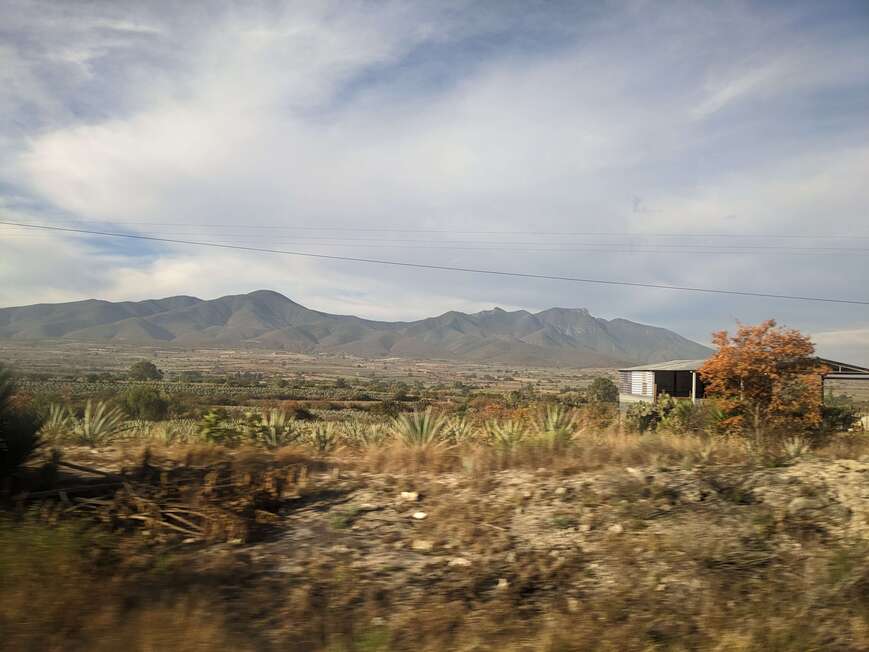
The Broke Backpacker is supported by you . Clicking through our links may earn us a small affiliate commission, and that's what allows us to keep producing free content 🙂 Learn more .

Unlock Our GREATEST Travel Secrets!
Sign up for our newsletter and get the best travel tips delivered right to your inbox.
There is no such thing as a perfect safety guide, as things change quickly. The question of “Is Oaxaca Safe?” will ALWAYS have a different answer depending on who you ask.
The information in this safety guide was accurate at the time of writing. If you use our guide, do your own research, and practice common sense, you will probably have a wonderful and safe trip to Oaxaca.
If you see any outdated information, we would really appreciate it if you could reach out in the comments below. Otherwise, stay safe friends!
Updated April 2024
Is Oaxaca Safe to Visit Right Now?
Safest places in oaxaca, 20 top safety tips for travelling to oaxaca, is oaxaca safe to travel alone, is oaxaca safe for solo female travellers, where to start your travels in oaxaca, is oaxaca safe for families, getting around oaxaca safely, crime in oaxaca, what to pack for your oaxaca trip, getting insured before visiting oaxaca, faqs on oaxaca’s safety, so, how safe is oaxaca.
Yes, Oaxaca is safe for tourists to visit! And actually, I recommend that you DO visit! In 2018, an analytical database reported 1,121,615 international visitors to Oaxaca . Majority having no troubles with their stay.
Mexico has been working hard to increase tourism in Oaxaca – and it’s working. The focus on the safety of visitors has made a noticeable difference, making it a great place to explore in Mexico .
While the USA Oaxaca travel advisories remain at “exercise increased caution” for most of the state, this is mainly due to petty crime such as pickpocketing.
Oaxaca is safe for tourists, yet large, and very diverse. The colourful capital, Oaxaca City, is one of the most visited destinations in Mexico and for the Day of the Dead festival.
The state has a large coast on the Pacific Ocean, and between them is a large mountainous region. If you want diversity, Oaxaca is your place.
Especially as far as Latin America goes, Oaxaca is a destination with few complications. That is not mean to say that there are NO safety concerns in Oaxaca. Having some safety tips under your belt is still invaluable.
While much of Mexico suffers from travel warnings , high crime rates and dangerous drug dealings, Oaxaca remains relatively safe. It’s a great alternative to Mexico City.
Drug-related violence, though still existing, is low and generally under control in Oaxaca. It’s extremely unlikely that any would affect tourists minding their own business.
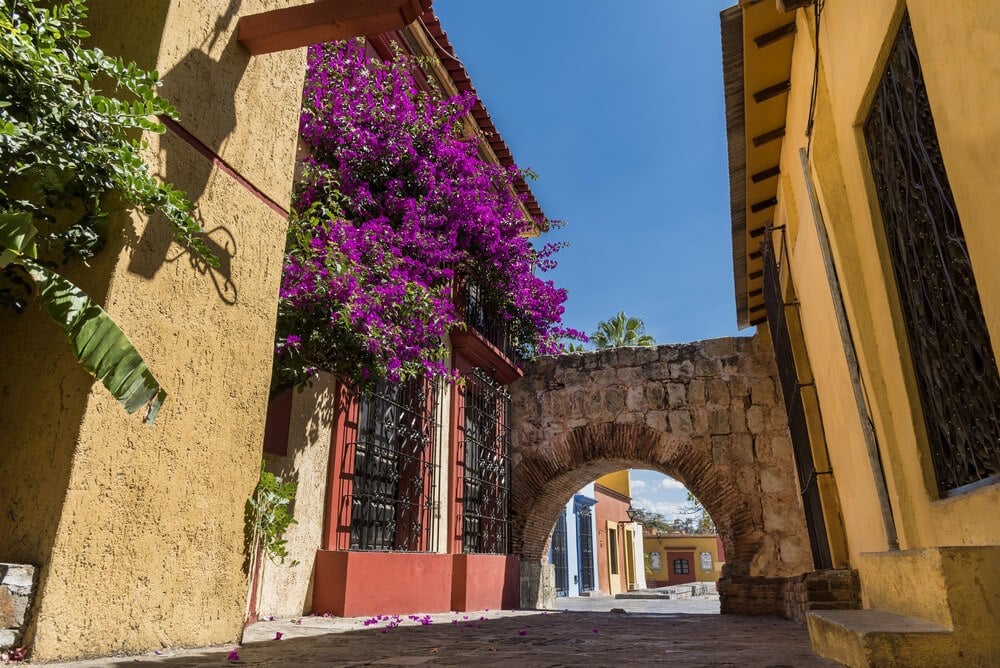
Natural disasters are a small risk in Oaxaca. Hurricane season affects Oaxaca from June to November. The size of these storms vary, but can cause widespread flooding, landslides, and disruption of local services.
Earthquakes can and do occur. Big tremors are uncommon but it’s good to be aware that they can occur.
Oaxaca’s coastline has powerful undercurrents and waves. Even strong swimmers get into trouble. On many beaches, you’ll find flags and warnings, which you should always heed.
So that’s the basics. But let’s go into a little more detail now.
Check out our detailed where to stay guide for Oaxaca so you can start your trip right!
The safest places to visit in Mexico are usually the places with the most tourism. For this reason, much of Oaxaca state is safe to visit. Although visitors are recommended to exercise increased caution. (Good advice for anywhere you’re travelling.)
These “safe destinations” have very few issues. However, you should still follow local laws and practice your usual safety protocol.
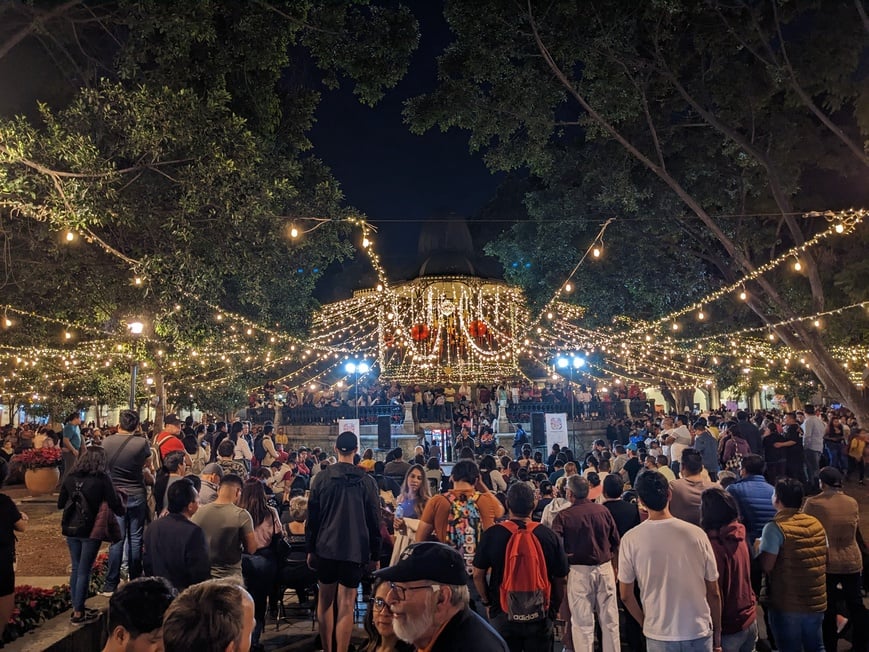
- Oaxaca City – Visiting Mexico is not complete without staying in Oaxaca City. It’s one of the more colourful and culturally rich places, with exciting art and endless places to eat. Go with an empty belly, leave with a full heart.
- Puerto Escondido – This popular backpacker spot attracts travellers from all over – and many find themselves not wanting to leave. On the Pacific Coast, people come for the surf, incredible food, and a relaxed vibe. Puerto Escondido’s hostels are something you should definitely experience.
- San Jose Del Pacifico – Once a hidden gem, now a pretty popular tourist town. This astonishing mountain spot is a place where time slows down. There’s nowhere else like this in Mexico (or even the world).
Unsafe Places in Oaxaca
While Oaxaca is mostly safe, there are certain areas of the state to avoid . Though there are very little to see in these places anyway, you really can skip across them and not miss a thing.
The USA government also recommends avoiding certain highways. This could be due to the safety of the road or illegal roadblocks. These rarely affect tourists – especially using reputable bus companies – though if you’re driving or hitchhiking in Mexico, it’s good to do thorough research.
- Towns bordering the state of Chiapas – including Juchitan de Zaragoza, Salina Cruz, and San Blas Atempa.
- Anywhere at Night – some select areas are okay such as downtown Oaxaca City, though it’s best to use a taxi or public transport if you’re going between areas or back to your accommodation.
- Sketchy Neighbourhoods – ask your accommodation staff if there are any barrios to avoid. Again, there will be nothing to see here anyway.
Keeping Your Money Safe in Oaxaca
One of the most common things to happen to you whilst travelling is losing your money. And let’s face it: the most annoying way for this to actually occur is when it’s stolen from you.
Petty crime is pretty much a problem all over the world.
The best solution? Get a money belt.

Stash your cash safely with this money belt. It will keep your valuables safely concealed, no matter where you go.
It looks exactly like a normal belt except for a SECRET interior pocket perfectly designed to hide a wad of cash, a passport photocopy or anything else you may wish to hide. Never get caught with your pants down again! (Unless you want to…)
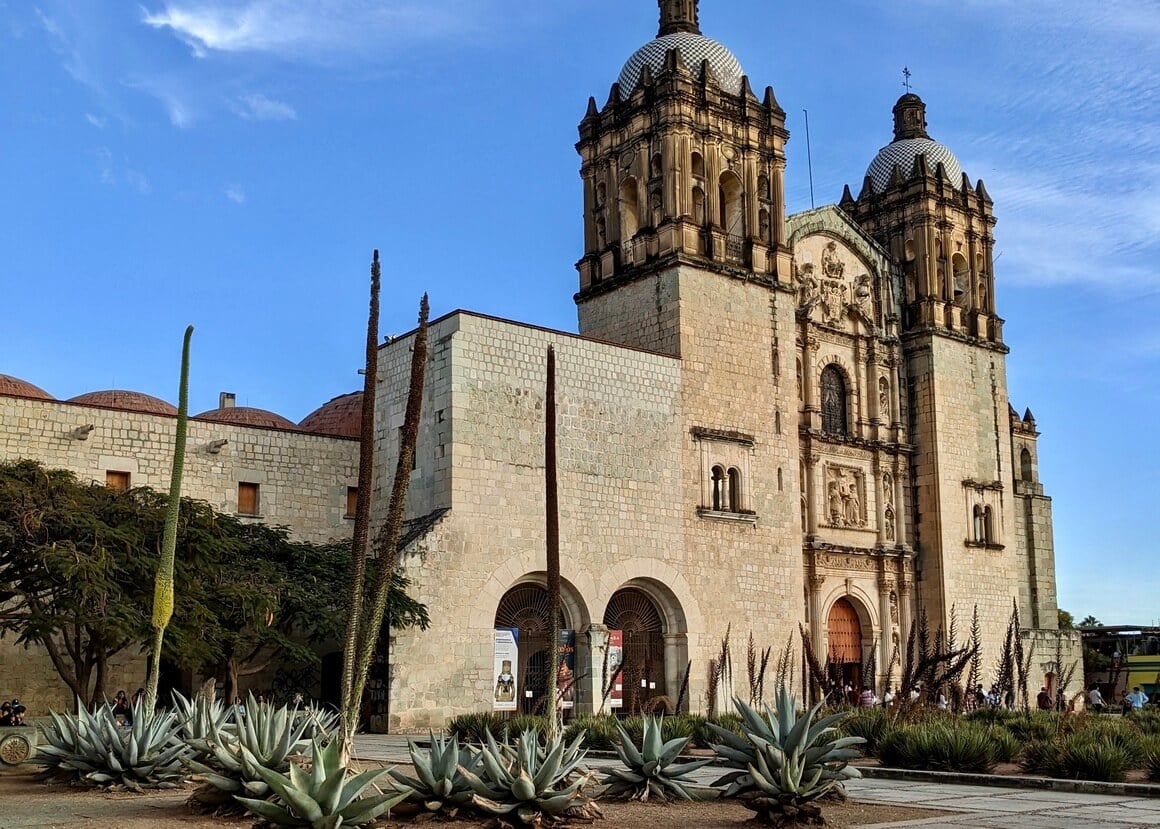
So the safety concerns for Oaxaca and the conclusion of “is Oaxaca Safe to visit?” comes down to knowing some crucial safety tips . This is not an exhaustive list, though they will help you experience safety in Oaxaca and enjoy this incredible adventure.
So here are some of our top safety tips for Oaxaca to keep you travelling smart.
- Don’t walk around looking rich – Leave designer clothes, flashy watches, and expensive jewellery at home.
- Try to dress down and blend in with what you are wearing – Erring on the side of casual is best. Try to reflect what other people may be wearing around you.
- Do your research – Oaxaca is a big place so plan accordingly. Different areas have different safety standards and cultures, too. Puerto Escondido is very different from Oaxaca City, for example.
- Learn Spanish – You don’t need to be fluent, but you’ll be surprised how much this helps – including getting yourself out of some sticky situations.
- DO NOT WALK AROUND ALONE AT NIGHT – Even in groups, it’s still very risky. I cannot stress this enough. Very certain areas are okay but it’s always better to ask locals before you do.
- Limit the amount of money you carry around with you – The more you have, the more you potentially lose. Store cash in different places of your person and luggage. Travel money belts are great for this.
- Be careful when using ATMs – Use them during daylight hours and preferably inside a mall, shop, or bank. Put it away discreetly before you leave the machine.
- Keep an eye on your belongings – Even on your suitcase when checking in at a hotel or bus station.
- Always keep an emergency stash of cash – Never keep all your cards/ currency in one place. And hide it all from thieves with a hidden money belt .
- The emergency number is 911 – remember it.
- Be careful of people who claim to be police officers – Not everyone is who they appear to be. If you aren’t sure, ask for details such as their name, badge number, patrol car number, etc.
- Watch out for scam artists – People approaching you asking for personal information or financial help. Treat unsolicited chats like these as suspicious.
- Watch for warning on beaches – Not all beaches are safe for swimming. If there are no flags or lifeguards, ask the locals. Even the calmest looking waters can have extremely strong undercurrents. The Pacific Ocean takes no prisoners.
- Take a good medical kit with you – you never know when you might need it!
- Research tour companies – If you’re heading out on a tour, make sure you are going with a reputable company that has good safety standards.
- Don’t leave food and drink unattended – Spiking does occur, so keep an eye on it and take care.
- Don’t get involved in drugs – I know it’s fun, but drugs are the source of many problems in Mexico. There are certain places that are okay in Oaxaca but unless you’re 1000% sure it’s really not worth the hassle.
- Keep an eye on earthquakes – Small tremors are common. Large tremors are uncommon. It’s good to have a general idea.
- Pay attention to the weather – Local reports will tell you about any tropical storms on the Pacific coast.
- Get a local sim card – This helps a lot.
- If somebody tries to rob you, hand over the goods – It is just not worth being a hero in these kinds of situations.
- Get trusty travel insurance – an absolute essential for any trip. Make sure your travel insurance covers the type of trip you’re having.
Oaxaca is safer than much of Mexico overall, but that doesn’t mean that you’ll be able to wander around freely without a care in the world. Keep these tips in mind and make sure to keep vigilant as you explore this amazing Mexican state.
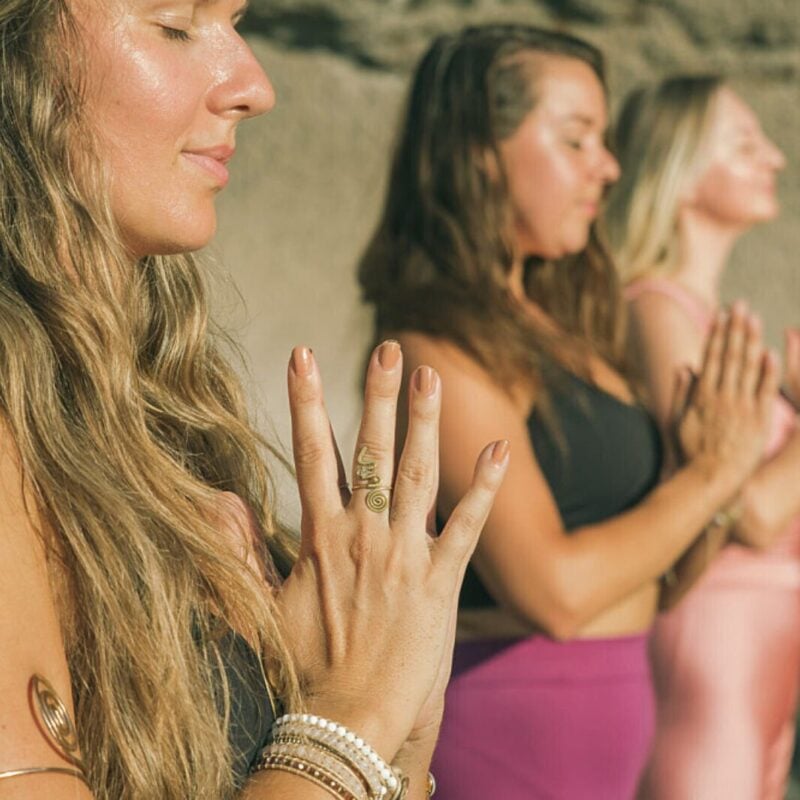
Ever thought about doing a retreat whilst travelling?
We recommend BookRetreats as your one stop-shop to finding specialised retreats focussed on everything from Yoga to fitness, plant medicine and how to be a better writer. Unplug, de-stress, and recharge.
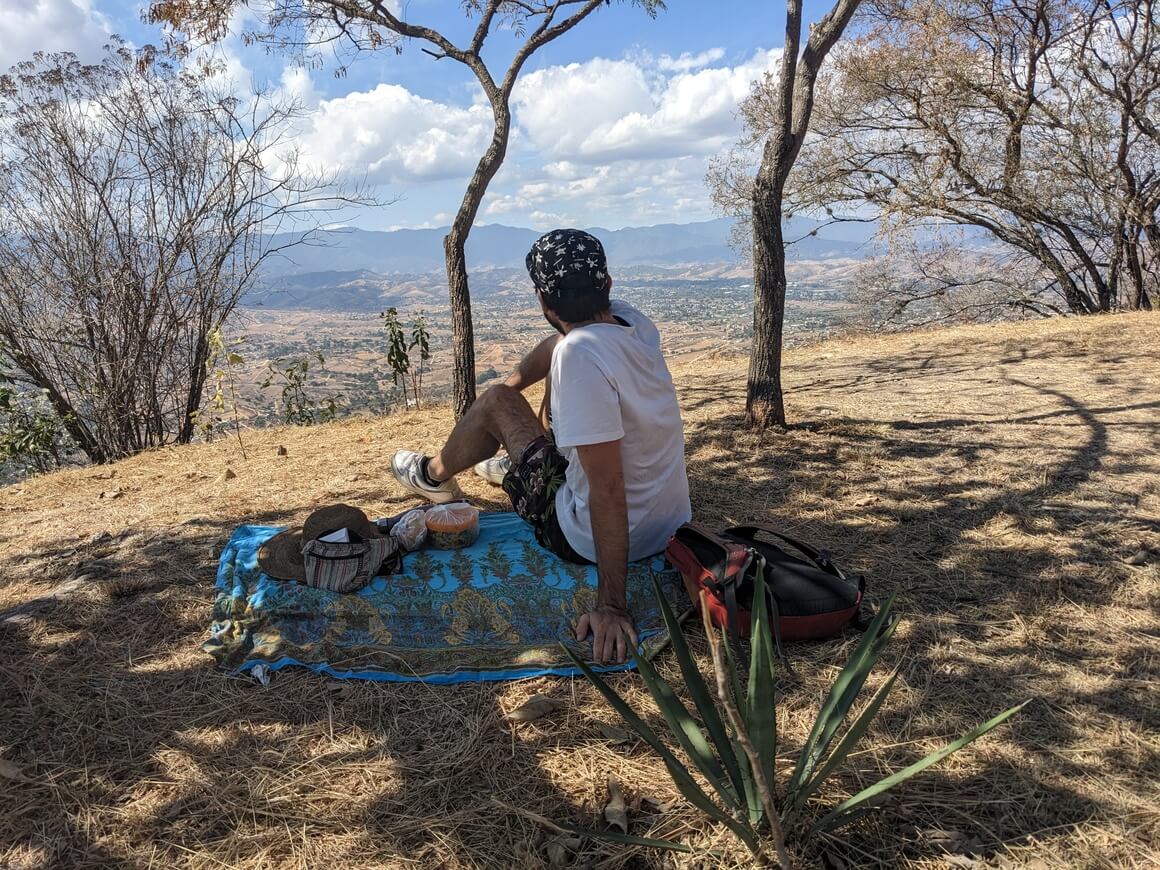
Yes! Oaxaca is an amazing place to travel – even alone.
It may not be a well-developed tourist destination, but it’s doable – and worth it. I’ve put together some tips for solo travellers in Mexico and Oaxaca to bear in mind when you travel around.
It’s a great place to go for history, with the colonial centre of the capital city to explore, as much as it is a foodie destination with a wealth of delicious treats to enjoy.
- Make friends ! – Always rule number 1 for solo travellers. There’s safety in numbers – plus it’s a lot more fun.
- Do your research – Have a rough idea of your itinerary, book accommodation ahead and read reviews, and ask other travellers for recommendations.
- DO NOT walk around at night alone – some very select places are okay. Generally, this is a big no no. Know how to get to your accommodation before you leave.
- Keep your phone charged – Your lifeline.
- Choose good hostels in Oaxaca – The state has no shortage of great choices. Read reviews, ask for recommendations, and stay somewhere that suits your personality.
- Stay alert. Don’t walk around with your iPhone in hand, not paying attention to your surroundings. I hope this is not the first time you’re hearing this.
- Download useful travel apps . Maps.me, Hostelworld, and even Tinder (to some extent) can be super useful for safety in Oaxaca.
- Take care when visiting beaches by yourself. Don’t leave belongings and valuables unattended on the beach.
- Ask locals for their insider knowledge – They will know interesting spots to visit, and places to eat, plus areas to avoid.
- Sun Protection! You don’t want to get sunstroke or increased risk of skin cancer.
- Let someone know where you are. Friends and family back home, or at the very least someone your accommodation staff.
- Don’t push yourself too much. Know when to stop and when to take a break.
- Travel light. Less baggage, less worries – literally.
- Keep track of your money and don’t keep it all in one place. You lose your wallet, you lose everything. Spread your bank and credit cards around.
Usually, Oaxaca feels like some remote wonderland of Mexico where everything’s fine. But the truth is, it’s not always. It’s somewhere in between, where you still need to watch out for your belongings and travel with some level of vigilance.
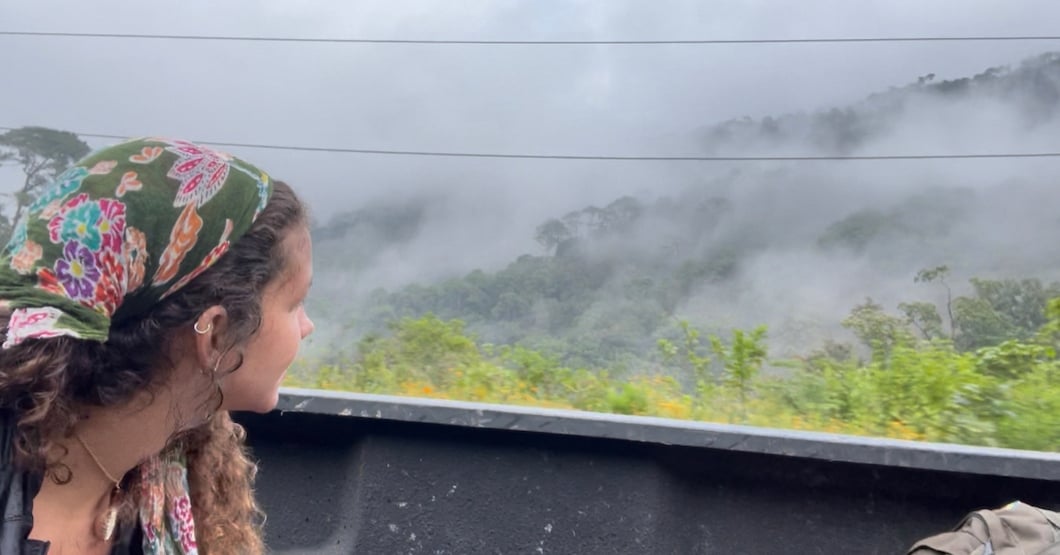
Yes! Oaxaca is one of the best places in Mexico for solo female travellers .
Though, like anywhere, travelling alone as a woman comes with some extra things to think about. Here are some tailored tips to keep you solo travellers super safe on your adventure.
- Listen to your spidey senses – female solo traveller tip 1: if your gut tells you something isn’t right, it probably isn’t. Get yourself out of there.
- Choose accommodation carefully – there are great hostels for women in Oaxaca.
- Chat with other female travellers – they understand the road you’re on better than anyone.
- Only use reputable bus companies – especially if you’re travelling at night, it’s worth paying the extra bit of cash for a safe journey.
- Read reviews before you book – that goes for hostels, hotels, tour companies, or anything else.
- Damn it, DO NOT WALK AROUND ALONE AT NIGHT – I’ve repeated this so many times already but it’s vital that everyone visiting Oaxaca understands this.
- Choose accommodation in a good location. In Oaxaca City, for example, stay close to attractions so it’s easy to get back at night.
- Dress modestly – Mexico is still quite conservative. Breaking boundaries is great but this is not the time or place. See what local women are wearing and try to match.
- Saying no is ALWAYS okay – you don’t need to please anyone, especially if it involves your safety.
- Make a fuss – It is unlikely that any hassle will turn ugly, but in a worst-case scenario, let everyone around know!
- Be careful of how much you drink – Keep your wits about you.
- Careful who you share information with – If someone’s asking too much personal information – red flag. Never share details of your accommodation or itinerary.
As a solo female traveller, one of the biggest dangers is falling in love with the place. It’s hard to drag yourself away when your time is up.
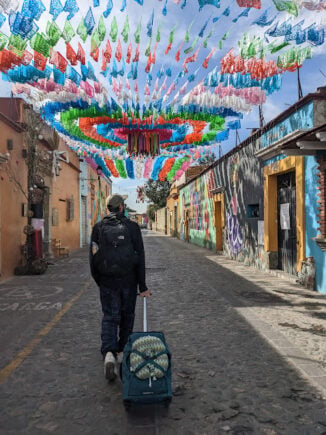
One of the coolest places to stay in Oaxaca. It is a hip and colourful neighbourhood best known for its quirky cafes and bars.
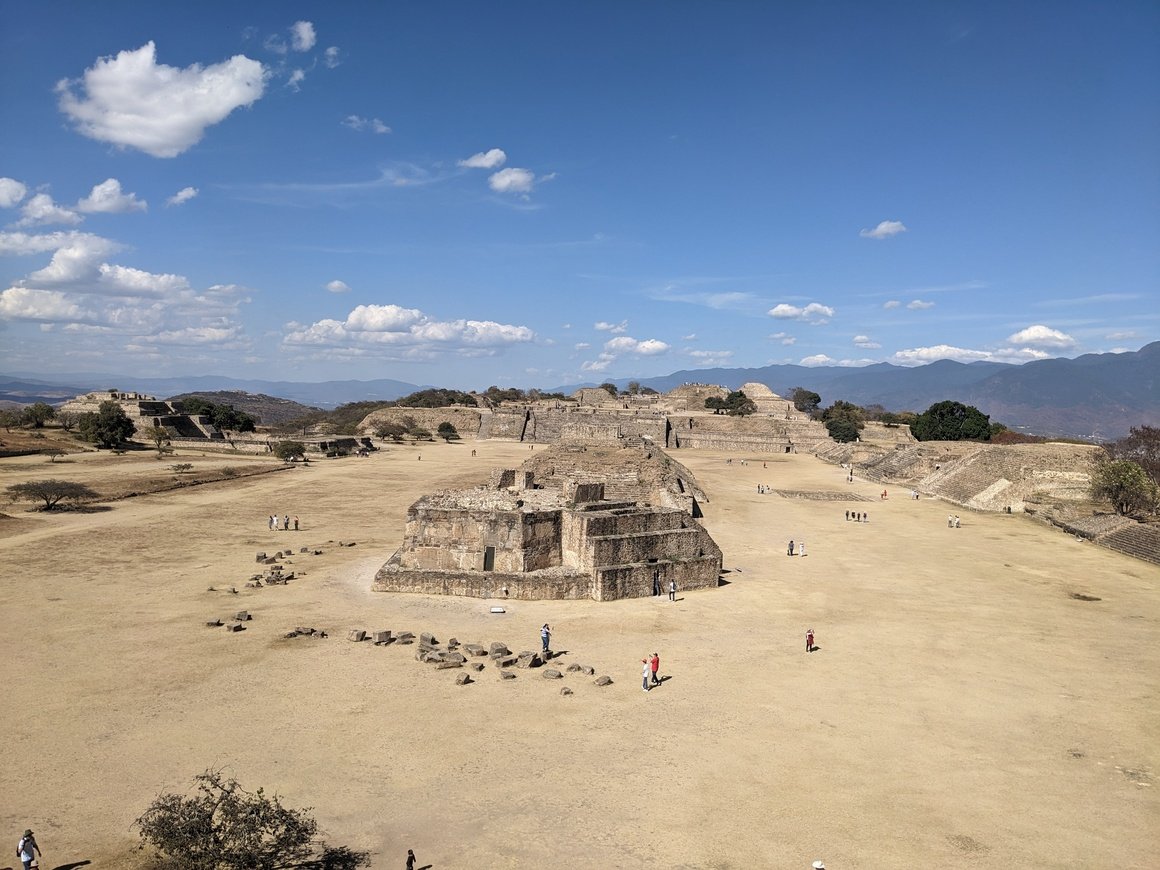
This is a question that comes us a lot. Is Oaxaca safe for families? YES!
Oaxaca is a kid-friendly place to travel to. From Oaxaca City itself to the beach, the coast, and the mountains, there’s a lot to keep everyone entertained.
Oaxaca city is very different from the likes of Mexico City. It’s walkable, colourful, and full of amazing character.
It is perfect for exploring with children with plenty to enlighten their senses. Lots of Mexican families travel to Oaxaca too, and you’ll see the main squares full of kids playing day and night.
The coastal area is also an ideal spot. Though the road from the city to the coast is long, don’t rush, plan accordingly, and you’ll arrive to enjoy all the best that you can expect from any coast anywhere.
Just pay attention to beach warnings. It is not always safe to swim everywhere. If there are no flags, ask at your accommodation whether or not it’s safe to swim.
Remember, like everywhere in Mexico, the places with the most visitors are the safest areas. So when you’re looking for a safe place to travel in Oaxaca with your family, bear that in mind. If you’re travelling between places, only use reputable companies like ADO Bus .
Also, much of the state of Oaxaca has high altitudes. So even sometimes when it doesn’t feel hot, the sun can be extremely strong. Make sure you have all the sun protection!
All in all, Oaxaca is a safe destination for families if you exercise increased caution (like you should everywhere).
Getting around Oaxaca safety isn’t overly complicated. You have the choice of buses, minivans, taxis, or driving yourself. They’re generally all pretty safe options – with a few important pointers.
Depending on where you go, the roads in Oaxaca can be complicated. From Oaxaca City to the coast it’s pretty rough.
Roads are narrow and winding, aren’t well maintained, and hazards aren’t well marked. Bear this in mind, whatever type of transport you choose.
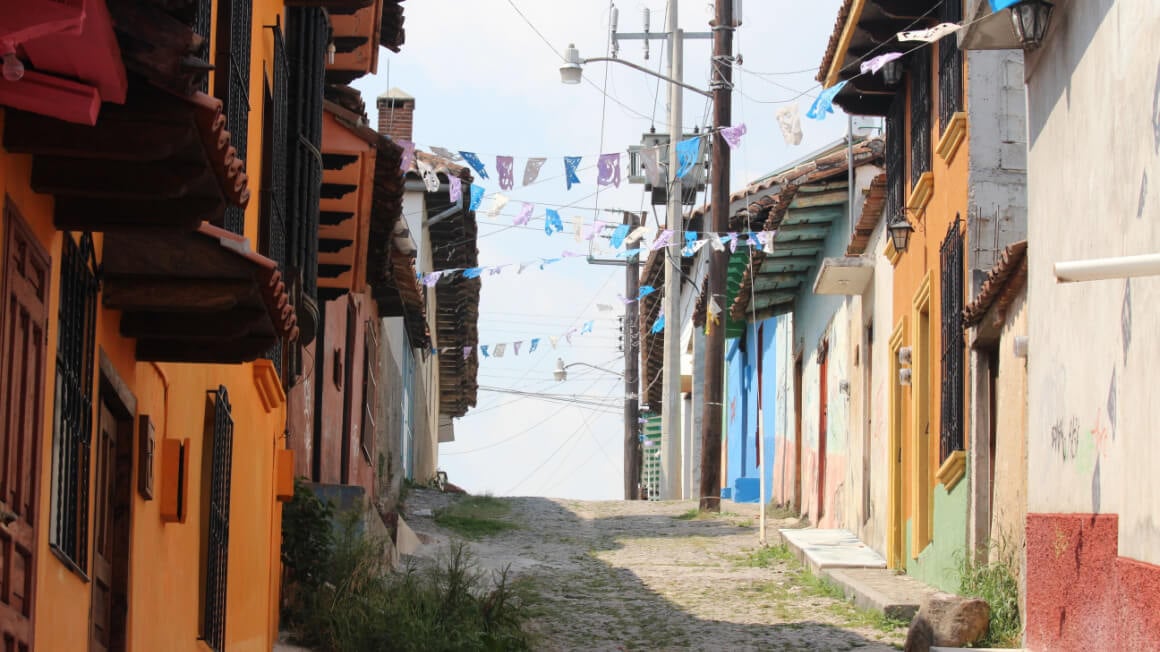
Driving in Oaxaca is safe enough, but may be challenging. Drivers in Oaxaca City are more aggressive, won’t stop for pedestrians, and don’t tend to follow traffic laws too much.
Local laws aren’t necessarily followed by police or drivers – so just be slightly aware of that. Go slowly, stop as you need to, and absolutely avoid driving at night at all costs.
Taxis in Oaxaca are generally safe. Though ensure that they are official taxis.
Use the sititos (taxi ranks) or ask your accommodation where to find them. If you are worried about the driver, take note of the driver’s name and license plate number.
Public transport varies throughout the state of Oaxaca, from luxurious buses to local pickup trucks. Reputable bus companies like ADO bus are your best bet. They do checks on the drivers and passengers, take toll roads, and drive sensibly.
Local buses, like the buses that drive around Oaxaca City, are regular and cheap. However make sure to HOLD ON TIGHT because they do not always drive the safest.
Minibuses are a great option for mid-distance travel. Lineas Unidas are super cushty, will give you an assigned seat, and generally drive safer than other minibus firms.
Depending on where you are going will depend on where you take them. Your best bet is to search on Google Maps, or ask locals for advice.
Oaxaca has a low crime rate compared to much of Mexico – though that doesn’t mean it doesn’t occur. Fortunately, most of this crime is petty theft which is pretty easily avoided. Violent crime is rare in Oaxaca.
Wherever you are, at the beach or in Oaxaca City, keep your valuables close.
Not watching your back and letting your guard slip when you’re on the beach at night, for example, or walking around looking like you’re wealthy, could result in being a victim of crime.
Protests in Oaxaca City are common, for example, and are usually held by union workers. Not often turning violent, these gatherings do throw up roadblocks and prevent travel in and around the capital city or further afield.
I do suggest that you avoid drugs in Oaxaca. I love a joint as much as the next person but, for various reasons, Mexico is not really the place to do it. There are some very select places where you can get away with it but there’s absolutely no way I’d list them here for fear of someone running with that idea.
Police are corrupt, you don’t need to give them any more reasons to hassle you, and drug cartels are the source of many of Mexico’s issues. It’s really best for everyone’s sake to just not get involved.
Apart from that, Oaxaca is one of the safest places in Mexico to take your travels.
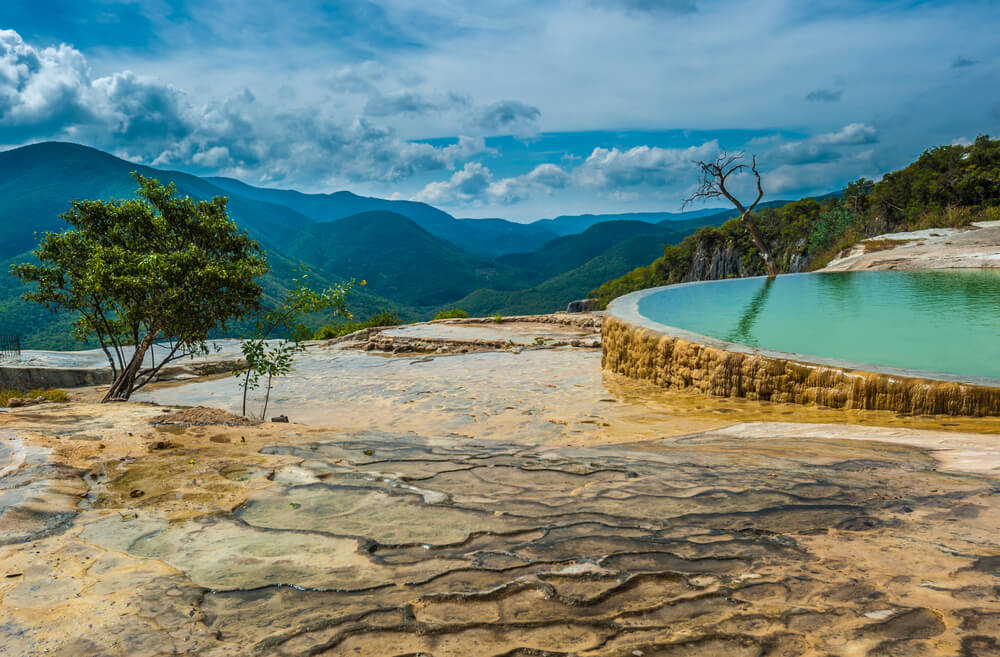
Everyone’s packing list is going to look a little different, but here are a few things I would never want to travel to Oaxaca without…

Hanging Laundry Bag
Trust us, this is an absolute game changer. Super compact, a hanging mesh laundry bag stops your dirty clothes from stinking, you don’t know how much you need one of these… so just get it, thank us later.

A decent head torch could save your life. If you want to explore caves, unlit temples, or simply find your way to the bathroom during a blackout, a headtorch is a must.

Yesim stands as a premier eSIM service provider, catering specifically to the mobile internet needs of travellers.

Monopoly Deal
Forget about Poker! Monopoly Deal is the single best travel card game that we have ever played. Works with 2-5 players and guarantees happy days.

This is a regular looking belt with a concealed pocket on the inside – you can hide up to twenty notes inside and wear it through airport scanners without it setting them off.
Before you go anywhere, having top-notch travel insurance for Mexico is vital. If something goes awray, and that does happen, this is your guardian angel.
ALWAYS sort out your backpacker insurance before your trip. There’s plenty to choose from in that department, but a good place to start is Safety Wing .
They offer month-to-month payments, no lock-in contracts, and require absolutely no itineraries: that’s the exact kind of insurance long-term travellers and digital nomads need.

SafetyWing is cheap, easy, and admin-free: just sign up lickety-split so you can get back to it!
Click the button below to learn more about SafetyWing’s setup or read our insider review for the full tasty scoop.
Here are some quick answers to common questions about safety in Oaxaca.
What should you avoid in Oaxaca?
Avoid these things in Oaxaca in order to have a safe trip: – Don’t walk around looking rich – Avoid being careless when getting money out of the ATM – Don’t walk around at night (especially if you are alone) – Don’t get involved in drugs of any kind
Is Oaxaca safe for tourists?
Yes, Oaxaca is pretty safe for tourists, especially those who stick to our travel tips and use their common sense. Being prepared and cautious during your trip will almost always keep you out of trouble.
What are the main safety issues in Oaxaca?
Tourists often experience small crimes like petty theft or pickpocketing. It’s rare (but not impossible) for tourists to face serious or violent crimes.
Is Oaxaca safe for female solo travellers?
Yes, we’d even go as far as saying that Oaxaca is the safest place in Mexico for female solo travellers. As long as you use basic common sense and stay aware of your surroundings, you should have a trouble-free trip in Oaxaca.
Is Oaxaca City safer than Mexico City?
Generally, yes. Oaxaca has a much lower crime rate than Mexico city. Though I always recommend that you should practice the same safety precautions in both cities, regardless.
At this point, I hope you’ve come to realise that the question of whether Oaxaca is safe to visit or not isn’t necessarily straightforward. Yes, you absolutely can visit Oaxaca and have a safe trip. Safety concerns are low and you’ll create memories to enlighten your life.
I’ve been in and out of Oaxaca for a few years now and never had any worries. So yes, it can be done. Without a doubt, I’ll be back to visit Oaxaca again one day.
Families, solo female travellers, and even LGBT travellers are all safe in Oaxaca. BUT you must practice some caution. This is Mexico after all and you are a guest here.
If you’re going to walk around with your Rolex, looking at maps on your iPhone 22, hailing illegal cabs in the night, and smoking a fat joint in the central squares, you can probably guess it’s definitely not going to be safe. Though, that would apply to most places really.
Be aware of your surrounding, but don’t get consumed by worry. Keep your sensible head on, exercise increased caution, prepare yourself with good travel insurance, and you’ll be rewarded ten folds by this impossibly beautiful state; one that leaves a big, fat, taco-shaped stamp on your heart.
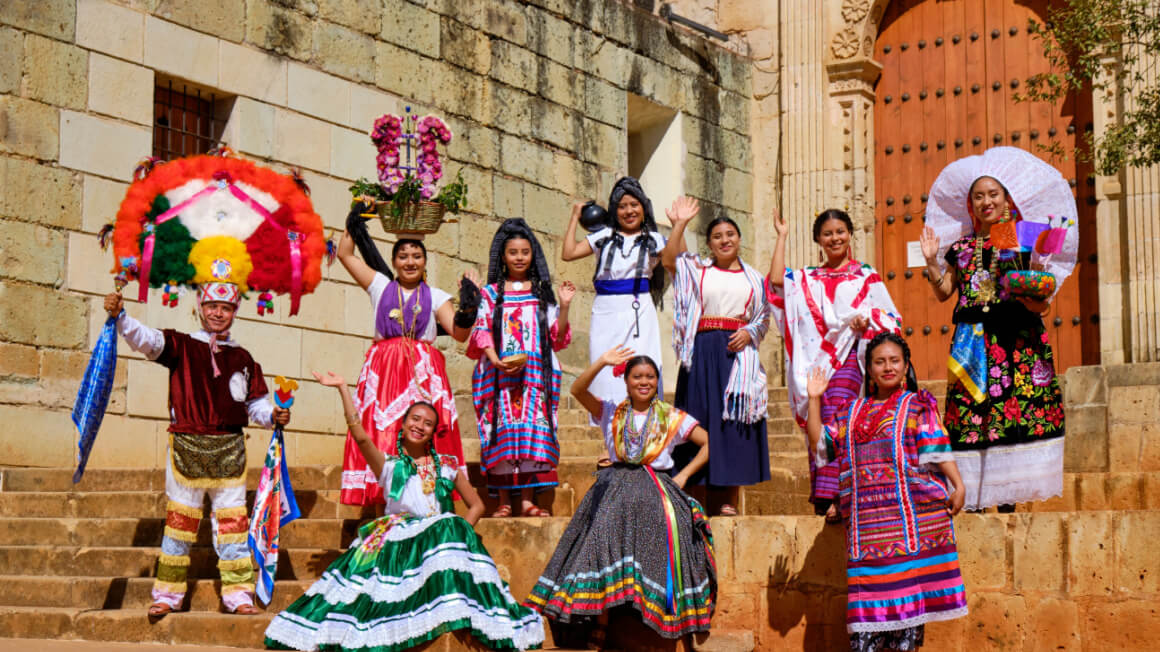
Looking for more info on traveling to Oaxaca?
- Let me help you choose where to stay in Oaxaca
- Swing by one of these fabulous festivals
- Don’t forget to add an epic national park to your itinerary
- Check out my favorite Airbnbs in the centre of all the action
- Plan the rest of your trip with our fantastic backpacking Mexico travel guide!
Disclaimer: Safety conditions change all over the world on a daily basis. We do our best to advise but this info may already be out of date. Do your own research. Enjoy your travels!

Share or save this post

i am an american retired in puerto escondido. i often drive to the capital. i have had very little problems with safety. yes, it’s best to be careful but that’s true everywhere. the food is indeed delicious and cheap, and asking for recomendations is always smart. when in doubt look for the crowds. taco stands, street food is similarly safe.
Leave a Reply Cancel reply
Your email address will not be published. Required fields are marked *
Save my name, email, and website in this browser for the next time I comment.
Notify me of followup comments via e-mail.
Most Dangerous Cities in Mexico 2024
According to the Global Peace Index , Mexico is the 24th least peaceful and 140th most peaceful country in the world. The Global Peace Index measures the relative peacefulness of 172 independent states and territories around the world.
The GPI weighs both internal peace (60%) and external peace (40%). Internal peace is weighted 1 to 5 using indicators such as homicide rate, the intensity of internal conflict, violent crime, political instability, political terror, and more. External peace is weighted 1 to 5 as well using indicators such as military expenditure, nuclear and heavy weapons capabilities, external conflicts fought, and more. A score of 1 is the most peaceful and a score of 5 is the least peaceful. Mexico has an index score of 2.600.
While Mexico is a popular vacationing destination, especially for U.S. tourists, the country has many dangerous areas and cities that should be avoided. Mexico is currently dealing with drug trafficking, organized crime, political corruption, violence against journalists, violence against women, and more. Those visiting Mexico should be cautious of kidnappings, homicides, robberies, and carjacking.
The ten most dangerous cities in Mexico, based on number of homicides per 100,000 residents are:
- Tijuana (138)
- Acapulco (111)
Tijuana, which is the world’s busiest land border crossings with over 50 million people passing through it every year, is the most dangerous city in Mexico. Tijuana’s homicide rate is 138 homicides per 100,000 people with a total of 2,640 homicides in 2018. With San Diego right across the border, there are concerns of such violence carrying over, but San Diego has remained relatively safe due to the hundreds of law enforced from U.S. Customs and Border Protection, Immigration and Customs Enforcement, the U.S. Drug Enforcement Agency, the FBI, and the U.S. Coast Guard. In 2018, San Diego had a homicide rate of 2.5 per 100,000 people.
The five most dangerous cities in Mexico are also among the top ten most dangerous cities in the world. Tijuana also ranks as the most dangerous city in the world, Acapulco takes the second spot, Ciudad Victoria takes the fourth, Ciudad Juárez takes the fifth, and Irapuato takes the sixth.
Download Table Data
Enter your email below, and you'll receive this table's data in your inbox momentarily.
7 Safest Beach Towns In Mexico With Low Crime Rates
Explore the natural wonders, archaeological sites, and gastronomic delights of Mexico while staying safe at these cities with low crime rates.
- Traveling to Mexico? Choose safe beach destinations like Cabo San Lucas with a low crime rate of 42.07 for a worry-free vacation.
- Tulum offers easy-going vibes with a crime rate index of 37.98, making it a sparkling gem of the Riviera Maya for tourists to enjoy.
- La Paz, the safest city in Mexico on the list, promises stunning beaches, desert terrain, and vibrant green waters for a memorable trip.
When traveling, feeling safe is one of the most important things that can make or break the quality of a vacation. For tourists seeking a beach respite in Mexico, legitimate concerns over safety may arise in certain areas. Although Mexico is known for its beautiful beaches, unique focus on eco-tourism, rich history, and delicious food, there are still places in the country that are not amenable for conventional tourism yet.
While many vacations run into unexpected hiccups, tourists can minimize anxieties simply by choosing the right place to go in the first place. For U.S. tourists venturing south of the border, Mexico boasts many beach towns that are as safe as they are beautiful. In this list, you'll find seven beachside cities and towns in Mexico that offer safe vacations, presented in descending order of crime index.
When reading the crime index numbers, it's good to have a comparison in mind. For example, the crime rate in Mexico's most dangerous city of Tijuana is 72.10 (very high) and Mexico City is 67.74 (high) .
10 Scenic Small Towns To Visit On The Yucatán Peninsula
Crime rate index: 47.06.
History comes alive in the Caribbean city of Chetumal. With a crime index of 47.06, it ranks as a relatively safe destination, ideal for a beach vacation rich in history and archeology. After spending an afternoon basking in the warm sunshine of Mahahual Beach , tourists can head to the Museum of Mayan Culture to learn about the incredible artifacts left behind by the Ancient Mayans.
To learn more about this rich history, a trip to the archaeological site of Dzibanche is a must; once a bustling Classic Maya city, Dzibanche once boasted a population of 40,000 people. Tourists can also head to Kohunlich , the site of a sprawling Mayan palace from 500 AD.
Chetumal is considered to be a highly safe city for walking alone during the daylight hours, and moderately safe for walking alone at night. This makes it an excellent choice for adventure-seeking tourists with an interest in archeology, offering the perfect mix of beachside relaxation and historic education.
As in many places in the Yucatan Peninsula, this crime rate index is brought up by the recreational use of drugs, not necessarily by violent crime.
6 Playa del Carmen
Crime rate index: 46.81.
Playa del Carmen is one of the Yucatan's paradise destinations for family travel , and with good reason. This beachside city is notably safe, with a crime index of 46.81 .
Playa del Carmen has no shortage of exciting activities for tourists to do. Tourists traveling with kids will have a blast at the eco-adventure waterpark, Xcaret Park , where families can snorkel to their hearts' content, swim with dolphins, meet exotic animals, and see historical reproductions of Ancient Mayan life. The park was named after the nearby archaeological site of Xcaret, an important trading center for the Ancient Mayans.
What's so great about Playa del Carmen is that it's an excellent entry point for some of Mexico's best historic ruins. Just a short drive away are the awe-inspiring ruins of Chichén Itzá , which are one of the Seven Wonders of the World .
Another great place within driving distance is Cenote Dos Ojos . Cenotes are a staple of the ecology of the Mayan Riviera; these jungle sinkholes offer tourists a cool place to swim after a day of sightseeing in the hot summer sun.
5 Cabo San Lucas
Crime rate index: 42.07.
On the rugged shores of Mexico's Baja California Sur is the city of Cabo San Lucas. For American tourists who are interested in nature adventures, this city is renowned as one of the safest cities to visit in all of Mexico.
With expansive views of the dark blue Pacific Ocean, dramatic geologic rock formations along the coastline, swaying palm trees, and beaches galore, Cabo San Lucas is considered by many to be the perfect place for a Mexican vacation. Tourists can explore beaches like El Medano Beach, Chileno Bay Public Beach, Santa Maria Beach, and Lovers Beach.
Positioned on the wild Pacific, Cabo San Lucas is also home to an excellent fishing scene, great whale-watching, and beachside horseback riding. Besides all of this, Cabo San Lucas is great for golfing, spas, nightlife, and shopping.
Skip Chichen Itza & Visit Uxmal: One Of The Yucatan's Most Spectacular Mayan Cities
Crime rate index: 39.96.
Another one of Mexico's most safest cities is also located on its Pacific Coast. This is the colorful city of Mazatlan, where tourists can expect a safe beachside getaway. From historic cathedrals to hiking opportunities to peaceful beaches, tourists will find Mazatlan has a plethora of exciting activities to do.
Tourists looking for a thrill would be remiss if they didn't stop at the city's 50 foot cliff diving sites. Those who are looking for a more relaxing time in the city should head to Old Mazatlan, where tourists can shop, eat, and enjoy historic buildings. Those interested in religious history should head to Catedral Mazatlan Basilica de la Inmaculada Concepcion to see a gorgeous 19th-century church.
Those who know a bit about the local history of Mazatlan and are interested in linguistics will know that the city's name means "the place of deer" in Nahuatl. A local place in the city where tourists can experience this linguistic connection is Deer Island (Isla de Venados) . Here, tourists can snorkel, kayak, hike, and go birding.
The Ultimate Travel Guide To The Yucatán Peninsula: Scenic Sites & Best Times To Visit
Crime rate index: 37.98.
The safe-to-visit city of Tulum is one of the Riviera Maya's most sparkling gems. With crystalline water, archaeological ruins that tower over the coastline, sandy white beaches, and delicious food, Tulum is one of the best places in Mexico to visit for those who are looking for an easy vacation.
Overlooking the turquoise waters of the Caribbean are the archaeological Maya ruins of Tulum. These ruins stand tall on the rugged cliffside, bringing visitors back to an era of empires, pagan gods, and rich culture. A trip to this incredible site will teach tourists about the incredible accomplishments of the Ancient Mayans.
Tourists who are traveling with children will have a blast at the local waterpark, Xel-Há . Here, you can experience excellent snorkeling, a lazy river tour through mangroves, caves, zip-lining into cenotes, and swimming with dolphins.
Mayapan: Visit One Of The Yucatan's Most Stunning But Rarely Visited Mayan Sites
2 puerto vallarta, crime rate index: 35.45.
Mexico's Pacific state of Jalisco is home to the picturesque city of Puerto Vallarta. This city is one of the safest places for tourists to visit in Mexico. Tourists to Puerto Vallarta can expect white sandy beaches, electric green water that fades into a deep Pacific blue, and rugged coastlines dotted with scrublands.
Tourists will truly have a safe time walking the streets of Viejo Vallarta (Puerto Vallarta's old town), exploring the vast Vallarta Botanical Gardens, seeing some of Mexico's best art at the creative Cuale River Island, and exploring the Cuale Archaeological Museum .
Crime rate index: 31.96
The safest city in Mexico to visit on this list is La Paz. Located in Mexico's Baja California Sur, La Paz promises tourists ancient churches, incredible rock formations, and electric green water that contrasts starkly against the red rock desert coasts. Not only is La Paz considered to be a very safe city, it's also one of Mexico's hidden gems.
For those who want a taste of La Paz's white sandy beaches, Balandra Beach, Playa Pichilingue, and Ensenada Grande are the places to go. While La Paz is famous for its beaches, it's also famous for its desert terrain. For tourists who want to explore the desert and see cool cacti, the local botanical garden at Sanctuary of the Cactus is the place to go.
Tourists who love wildlife would be remiss without a trip to Isla Espiritu Santo. This UNESCO World Heritage Site is one of Mexico's best places for biodiversity. Here, tourists will meet aquatic mammals, such as sea lions and dolphins, swim the seas with whale sharks and sea turtles, and watch over 100 bird species take to the sky.
Those who want to experience the city's history will enjoy the La Paz Cathedral and the Museo de Antropologia e Historia de Baja California Sur .
Mexico is a popular destination for U.S. tourists, but many worry about safety concerns while traveling. Whether tourists are looking for a great vacation spot or some of the safest places to retire in Mexico, there are always great options for them to choose from.
Cookies on GOV.UK
We use some essential cookies to make this website work.
We’d like to set additional cookies to understand how you use GOV.UK, remember your settings and improve government services.
We also use cookies set by other sites to help us deliver content from their services.
You have accepted additional cookies. You can change your cookie settings at any time.
You have rejected additional cookies. You can change your cookie settings at any time.
Register to vote Register by 18 June to vote in the General Election on 4 July.
- Passports, travel and living abroad
- Travel abroad
- Foreign travel advice
Safety and security
You should also read FCDO’s overall travel advice and regional risks advice .
Upcoming Elections
Mexico will hold national elections on 2 June 2024. There may be an increase in political demonstrations and travel disruptions, such as roadblocks or clashes between political supporters. Avoid demonstrations and leave the area if you see a large public gathering or demonstration. Monitor local media for updates on any disruptions.
There is a high threat of terrorist attack globally affecting UK interests and British nationals, including from groups and individuals who view the UK and British nationals as targets. You should remain vigilant at all times.
UK Counter Terrorism Policing has information and advice on staying safe abroad and what to do in the event of a terrorist attack. Find out how to reduce your risk from terrorism while abroad .
Terrorism in Mexico
Terrorist attacks in Mexico cannot be ruled out.
Political situation
Political demonstrations are common in Mexico City and can happen across the country. These can be tense and confrontational and could potentially turn violent. Onlookers can be quickly drawn in. Monitor local media and avoid all demonstrations.
It is illegal for foreigners to participate in political activities in Mexico. Participation in demonstrations may result in detention and deportation.
Politically motivated violence can happen across the country. Onlookers can be quickly drawn in. You should monitor local media and avoid all demonstrations. If you come across protests, move away from the area.
Crime in Mexico can pose a risk for foreigners, particularly in major cities and tourist resort areas where street crime is a serious issue.
Many Mexican and foreign businesses choose to hire private security. You should:
- research your destination thoroughly
- only travel during daylight hours when possible
- monitor local media
- inform trusted contacts of your travel plans
If you’re the victim of a crime and want to report the incident, do so immediately to the nearest branch of the state prosecutor’s office (‘Agencia del Ministerio Público’). A criminal investigation is not possible without a formal complaint to Mexican authorities. Complaints must be made in person before leaving Mexico.
The Mexico City Command and Control Centre (‘Centro de Atención a Emergencias y Proteción Ciudadana de la Ciudad de México’) has information and advice in Spanish on safety in Mexico City.
Take care when withdrawing money from ATMs or exchanging money at an exchange shop (bureau de change). It’s generally safer to use ATMs during daylight hours and inside shops or malls. People withdrawing money from airport money exchange shops and ATMs in various locations have later been targeted by criminals. Avoid withdrawing large amounts of money and be careful of your surroundings and who is around you while you are using the ATM.
Protecting your belongings
Pickpocketing and theft are common, including on public transport. Avoid wearing expensive clothing, jewellery or watches. Limit the amount of cash or credit/debit cards you carry with you. Watch your briefcases and luggage, even in apparently secure places like the lobby of your hotel.
Be wary of people presenting themselves as police officers trying to fine or arrest you for no reason, travellers driving rental cars have been targeted. Some police officers have extorted money from tourists, for alleged minor offences or traffic violations. If this happens:
- do not hand over money or your passport
- ask for a copy of the written fine, which is payable later.
- ask for identification
- try to take note of the officer’s name, badge number, and patrol car number
Criminals may attempt to contact your friends or relatives to transfer money to Mexico, this can occur following cases of phone theft or hacking, arrange with relatives and friends how you will contact them or how you would arrange to transfer money in advance.
A common scam involves criminals phoning, acting as a distressed member of family, or an employee, claiming to be kidnapped and demanding money for their release. Thieves may also claim that a relative is being detained. If you are threatened over the phone, hang up and check on the safety of your family member or employee.
Drink and food spiking
Do not leave food and drinks unattended in bars and restaurants. Travellers have been robbed or assaulted after being drugged. Tainted alcohol has caused illness or blackouts. If you have any concerns, get advice from your tour operator or the local authorities.
Sexual assault
Sexual offences have been reported in tourist areas. Take care even in areas close to hotels, and especially after dark.
Short-term opportunistic kidnapping (called ‘express kidnapping’) can happen, particularly in urban areas. Victims are forced to withdraw money from credit or debit cards at a cash point to secure their release.
Longer-term kidnapping for financial gain also happens, and there have been allegations of police officers being involved. Be discreet about discussing your financial or business affairs in places where you may be overheard by others.
Do not become involved with drugs of any kind. Drug-related violence in Mexico has increased over recent years. Penalties for drug offences are severe, convictions carry sentences of up to 25 years.
Some areas of Mexico have a high crime rate due to the fighting between rival organised crime gangs. In these areas, there is a risk of being caught in the crossfire or of being mistaken for a member of a rival gang. Whilst risks are lower in tourist areas, you should:
- take advice from local authorities or your hotel
- be aware of your surroundings at all times
- use reputable tourism or transport companies
- travel during the daytime where possible
Vehicle crime
Stay away from isolated roads and use toll roads (‘cuotas’) whenever possible. Keep car doors locked and windows closed, especially at traffic lights.
Violent car-jackings and robberies happen along the Pacific Highway, if you suspect you’re being followed or watched, drive to a police station or other safe place. Targets have included large camper vans or sports utility vehicles (SUVs).
There have been incidents of criminals deliberately causing traffic accidents in order to make insurance claims or request cash from the other party. They are sometimes accompanied by threats of violence or intimidation. Contact the authorities for support where necessary.
If you are involved in a hijacking, stay calm and surrender your valuables and your vehicle if asked. Resisting demands for your belongings can put you at significant risk of harm.
Public transport
Be alert on public transport, at airports and in bus stations. Theft on buses is common, so always keep your belongings safe.
Buses have also been hijacked. Try to travel on first-class buses using toll roads, which have a lower rate of incidents than second and third-class buses travelling on the less secure free (‘libre’) roads. Most first-class bus companies perform security checks when passengers board the bus.
Women travelling alone on public transport have been targeted with harassment, robbery and sexual assault.
Laws and cultural differences
If you require information on procedures, local laws, development of current events or social services you can contact Mexico City’s public telephone service LOCATEL on 5658 1111. They have English-speaking staff available.
Personal ID
If requested by Mexican authorities, you will need to provide your passport and stamp to prove your entrance and stay, copies and photos are not accepted. To demonstrate your visa status, you can get a digital registry of your entry documents from the Portal de Servicios INM . If you are unable to produce these documents, you may be questioned by Immigration officers and held in a detention centre while the authorities check your immigration status. Depending on the outcome, you can be deported.
Legal status
The Mexican Police have the authority to ask for proof of legal status in Mexico at any time. Several British people have been detained for not having the relevant documentation on them. If you are a resident, you may be asked to provide your residency card issued by the Mexican government.
Smoking and e-cigarette bans
It is illegal to bring electronic cigarettes, vaping devices and solutions into Mexico or to buy and sell them. If found in your belongings by customs officials, these will be confiscated; resulting in being fined or being detained.
You can be fined up to £150 for smoking or vaping in public places.
Illegal drugs and prison sentences
Do not become involved with drugs of any kind. Penalties for drug offences are severe and convictions carry sentences of up to 25 years.
LGBT+ travellers
Same-sex relations in Mexico are generally tolerated, rather than accepted. Civil unions between same-sex partners are legal in Mexico. Public displays of affection between same-sex couples may be frowned upon. Read more advice for LGBT+ travellers.
Assisted human reproduction, including surrogacy, is only legally recognised in some Mexican states. If you’re considering a surrogacy arrangement in Mexico, familiarise yourself with the relevant laws and regulations and make sure you meet all legal requirements to take the child out of Mexico before you start the process. Seek independent legal advice before entering into any surrogacy arrangement. For more information see our guidance on surrogacy overseas .
Main tourist destinations
The Mexican government makes efforts to protect major tourist destinations like:
- Nuevo Vallarta
- Playa del Carmen
- Puerto Vallarta
British travellers have been physically and sexually assaulted. In some cases, hotel employees, taxi drivers and security personnel at popular tourist destinations were involved. On occasion, hotel staff have not been helpful and tried to dissuade victims from pursuing the incident with police.
Cancun and Tulum
There have been several clashes between rival criminal gangs in popular tourist destinations in Cancun and surrounding areas.
While tourists have not been the target, anyone in the vicinity of an incident could be affected. Since 2021, there have been several cases of tourists being affected by shootings.
Exercise increased caution after dark in downtown areas of Cancun, Tulum, and Playa del Carmen. Remain in well-lit pedestrian streets and tourist zones. If you are visiting any of these areas, monitor local advice, remain vigilant and follow the advice of the local authorities and your tour operator.
Hotel safety
In some hotels, balcony balustrades may not be as high as you expect and there could be a risk of falling.
Outdoor activities and adventure tourism
If you take part in adventurous sports (including paragliding, skydiving, scuba diving and jet-skiing), make sure safety precautions are in place. Equipment may not meet UK safety and insurance standards. British nationals have been injured and, in some cases, killed participating in extreme sports.
You should make sure:
- you only use reputable operators
- the company is using the most up-to-date equipment and safety features
- the company are fully licensed and insured
- you’re covered by your travel insurance for all the activities you want to undertake
Swimming safety
Sea conditions can be unpredictable, and some beaches are unpatrolled. Follow the guidance of the coastguard or other local authorities on whether it is safe to swim.
Shark attacks are rare in Mexico, but you should take care particularly when surfing, research the local area and follow the advice of the local authorities.
Crocodiles are present in Mexico, most commonly in lagoons and coastal areas. Sightings have been reported near tourist areas, including Cancun and resorts on the Pacific coast. There are signs warning about crocodiles around many lagoons in these areas. Respect the warnings and do not walk too close to the water. Tourists have been seriously injured in crocodile attacks in the past.
Transport risks
Road travel.
Driving standards are very different from the UK. Roads can be pot-holed, and driving conditions can be unpredictable. Be prepared to stop unexpectedly and beware of vehicles moving slowly, changing lane without indicating and going through red lights. Many local drivers do not have any form of car insurance.
Licences and permits
You can drive in Mexico using a UK license or an International Driving Permit . If you are planning to drive in Mexico, see information on driving abroad .
Driving restrictions
To reduce air pollution, Mexico City and some other parts of the country have driving restrictions. Cars may be banned from entering certain areas on particular days, based on their number plates, Check the Hoy no Circula programme for further details.
These regulations are strictly enforced and offenders face heavy fines and temporary confiscation of their vehicle. Check if this applies with your car hire company.
There is an additional driving restriction in Mexico City, where vehicles without registration plates from the State of Mexico (‘Estado de Mexico’) or Mexico City are not allowed to enter Mexico City from:
- Monday to Friday between 5am and 11am
- Saturday between 5am and 10pm
If air pollution is high, generally between February and June, further driving restrictions may apply.
In remote areas, you may come across unofficial roadblocks, including on main roads. They are manned by local groups seeking money for an unofficial local toll, they can become violent and deny entry.
Passengers have been robbed and assaulted by unlicensed taxi drivers including in Mexico City. Use the better regulated ‘sitio’ taxis from authorised taxi ranks or ask your hotel to order you a taxi. At airports, use only authorised pre-paid airport taxi services.
Licensed taxi drivers have been blocking roads and targeting Uber taxis in Cancun’s Hotel zone, in protest against Uber. Tourists have been affected, including being pulled from Uber taxis and experiencing long delays because of roadblocks, sometimes leading to missed flights. Protests can happen without notice. Listen to local announcements and follow the advice of your hotel on how best to avoid any protests.
Extreme weather and natural disasters
Monitor local and international weather updates from the US National Hurricane Center and follow the advice of local authorities and your tour operator including any evacuation orders.
In the aftermath of a hurricane, there can be flooding, high winds and continued rainfall. See the extreme weather and natural hazards for further advice about how to prepare for travel during hurricane season, what to do ahead of a storm and what to expect in the aftermath of a hurricane.
The hurricane season in Mexico normally runs from June to November and can affect both the Pacific and Atlantic coasts. The effects of tropical storms and hurricanes causes flooding, landslides and disruption to local services, including transport networks.
On 25 October 2023, Hurricane Otis hit the south coast of Mexico around Acapulco. as a Category 5 hurricane. It caused significant damage to infrastructure in Acapulco and along Mexico’s southern coast between Zihuatenejo and Punta Maldonado. There continues to be disruption to tourism while reconstruction efforts are ongoing, and the security situation is unpredictable. The Foreign Commonwealth and Development Office advises against all but essential travel to the city of Acapulco.
Earthquakes
Earthquakes can occasionally happen in most parts of Mexico. Tremors happen regularly, particularly in the states of Oaxaca and Guerrero.
The US Federal Emergency Management Agency has advice about what to do before, during and after an earthquake or tsunami as does the Mexican Ministry of Civil Protection (in Spanish).
If you’re travelling in Mexico City you can download the 911 CDMX app (accessible only by local phone numbers: Download on iOS or Android ), which warns you an earthquake will happen 60 seconds before the movement starts. Although these alarms are useful, they cannot detect every kind of earthquake there can be.
Volcanic eruptions
The Popocatepetl and Colima volcanoes are active and closed to the public. There are danger zones around both volcanoes, the size of which can change depending on the current level of activity. A 12km exclusion zone is currently in place around Popocatépetl volcano, which is 92km from Mexico City centre and 64km from Puebla. The alert level at Popocatépetl is Level 2 of the Amber tier. Check with your tour or flight operator or follow Benito Juárez international airport on twitter . Information about the alert level and other Government advice can be found at @SGIRPC_CDMX on Twitter .
Ash fall from Popocatépetl has previously caused flight disruption, including cancellations at Benito Juarez International Airport in Mexico City. If you are travelling, you should check your flight status directly with your airline.
Exposure to falling ash and toxic fumes from active volcanoes can affect your health, especially if you suffer from a respiratory condition.
For more updates on both the Popocatepetl and Colima volcanoes and the tier system, visit the website of the Mexican Disaster Prevention Centre .
Related content
Is this page useful.
- Yes this page is useful
- No this page is not useful
Help us improve GOV.UK
Don’t include personal or financial information like your National Insurance number or credit card details.
To help us improve GOV.UK, we’d like to know more about your visit today. Please fill in this survey (opens in a new tab) .

IMAGES
VIDEO
COMMENTS
Of the most dangerous cities in the world per capita, 7 out of 10 are in Mexico, with familiar places like Tijuana and Ensenada on the list. (Source: Statista) (Source: Statista) 2.
10. Coatzacoalcos. With a homicide rate of 48 per 100,000 residents, Coatzacoalcos was once a vibrant tourist spot in Veracruz. Today, it is the sight of violence where recently nine bodies were left on the street. Murder, robbery, and violent crime make this city one of the top ten most dangerous in Mexico. 9.
74.81 / 100. 1. Celaya. Another lesser known city on our list, Celaya now officially ranks as the most dangerous city in Mexico, and one of the most dangerous cities in the world. Located in the usually safe state of Guanajuato, the high amount of violence here is due to the presence of the Santa Rosa de Lima cartel.
The State Department recommends U.S. citizens not to travel to five states in Mexico due to increasing levels of crime and kidnapping. Those states are Colima (where Manzanillo is located), Michoacan, Sinaloa (where Mazatlán is located), Tamaulipas, and Zacatecas (home to Zacatecas City). Guerrero — where Acapulco, Zihuatanejo, and Ixtapa ...
1. Colima. Colima is a small Mexican state on Mexico's Pacific coast and is the home of Manzanillo, a beach town with tourist resorts and consistently warm weather. It is posted as a "Do Not Travel" state because of the prevalence of violent crime, kidnapping, and gang activity, which are widespread.
And the popular Cancún is also considered dangerous by locals. Also, the Mexican government recently deployed over 300 army soldiers to keep tourists safe . These are the most popular destinations for travelers where people feel unsafe: Zacatecas: 90.4%. Colima: 87.5%. Guadalajara: 87.1%. Puebla: 87.1%. Morelia: 83.6%.
The safety situation in Mexico does vary considerably by region, however. The U.S. State Department has issued elevated travel advisories for several Mexican states, including a few popular with tourists as well as several bordering the US. These travel advisories mostly related to gang-related crime.
There are 32 states in Mexico, and the US State Department has "do not travel" advisories in place for six, including Tamaulipas state, where Matamoros is located.
Despite a longstanding reputation as a dangerous city to visit, Mexico City only has an advisory to exercise increased caution, and for good reason; the downtown core in particular is considered ...
The more recent map is here. Even as travel is discouraged to all of Mexico because of the COVID-19 pandemic, the U.S. State Department continues to update its warnings concerning kidnappings and ...
The CDC places a destination at Level 4 when more than 500 cases per 100,000 residents are registered in the past 28 days. The CDC advises travelers to avoid travel to Level 4 countries.
Mr. de Hail recommends researching the resort and news from the area you're visiting. The U.S. State Department provides state-by-state information about travel risks in Mexico. As of early ...
San Miguel de Allende. Yes, it's an obvious choice - and with reason. A bit of an American-expat go-to of the silver towns of the central highlands north of Mexico City (and two hours from the León airport), San Miguel de Allende is a stunner, with any worry of drug violence a distant rumor. The town itself - as seen in Robert Rodriguez's ...
Reissued after periodic review with general security updates, and the removal of obsolete COVID-19 page links. Country Summary: Violent crime - such as homicide, kidnapping, carjacking, and robbery - is widespread and common in Mexico.The U.S. government has limited ability to provide emergency services to U.S. citizens in many areas of Mexico, as travel by U.S. government employees to ...
So far in 2024, the State Department made changes to the existing Level 4 advisories for Myanmar, Iran and Gaza, and moved Niger and Lebanon off of the Level 4 list. Places With a Level 4 Travel ...
January 11, 2018 1:30 PM EST. T he State Department issued new travel warnings for parts of Mexico on Wednesday, advising American travelers to entirely avoid five regions due to crime. The ...
Safety. Avoid protests and large public gatherings. These can become violent. It's against the law for foreigners to participate in political activity. Mexico has a high risk of violent crime, including murder, armed robbery, sexual assault and kidnapping. Don't travel at night outside major cities. Drug-related violence is widespread.
The United States is warning travelers heading to Mexico to be aware of their surroundings ahead of the spring break holiday season. The warning, which was issued this week by the U.S. Embassy and ...
The country may be the top destination for U.S. travelers, but violent crime is soaring, leaving travelers questioning whether Mexico is safe to visit. The stories are sobering. In January 2022 ...
The quick answer to that question is yes. Travelling to Mexico right now is safe. Based on the reports of Gobierno de Mexico tourism, Mexico recorded an estimated 30,700,000 tourists from January to November 2022. Amongst these are pretty much safe travels.
The safest places to visit in Mexico are usually the places with the most tourism. For this reason, much of Oaxaca state is safe to visit. ... There's nowhere else like this in Mexico (or even the world). Unsafe Places in Oaxaca. While Oaxaca is mostly safe, there are certain areas of the state to avoid. Though there are very little to see in ...
Irapuato (81) Cancun (64) Culiacán (61) Uruapan (55) Ciudad Obredón (52) Coatzacoalcos (48) Tijuana, which is the world's busiest land border crossings with over 50 million people passing through it every year, is the most dangerous city in Mexico. Tijuana's homicide rate is 138 homicides per 100,000 people with a total of 2,640 homicides ...
Choose safe beach destinations like Cabo San Lucas with a low crime rate of 42.07 for a worry-free vacation. Tulum offers easy-going vibes with a crime rate index of 37.98, making it a sparkling gem of the Riviera Maya for tourists to enjoy. La Paz, the safest city in Mexico on the list, promises stunning beaches, desert terrain, and vibrant ...
A 12km exclusion zone is currently in place around Popocatépetl volcano, which is 92km from Mexico City centre and 64km from Puebla. The alert level at Popocatépetl is Level 2 of the Amber tier.
Isla Holbox. If you're really itching to escape the crowds, head to Isla Holbox, a 26-mile-long car-free island located right off the coast of the Yucatan Peninsula. While the island has grown ...